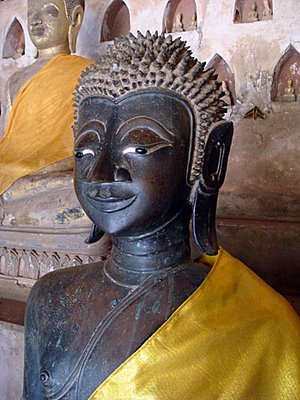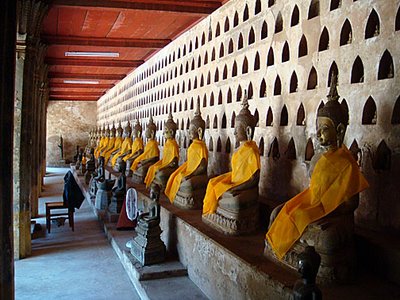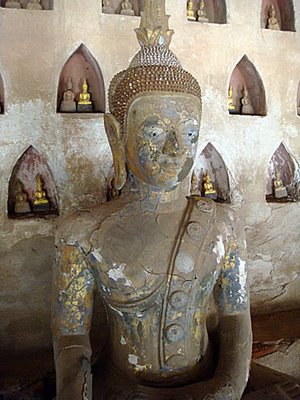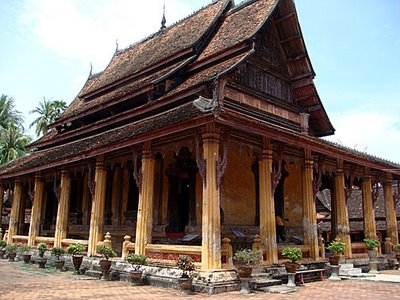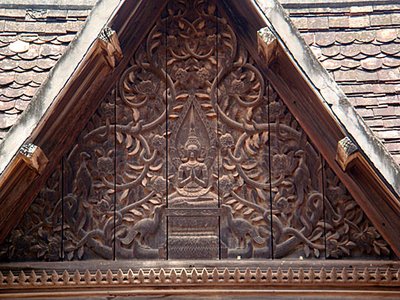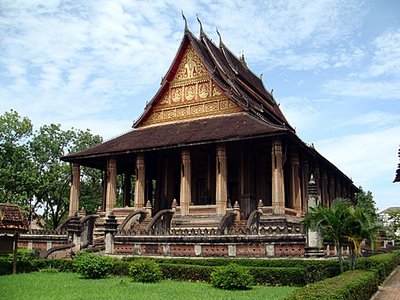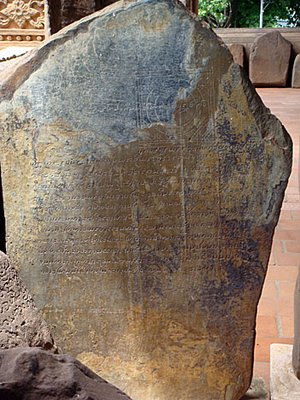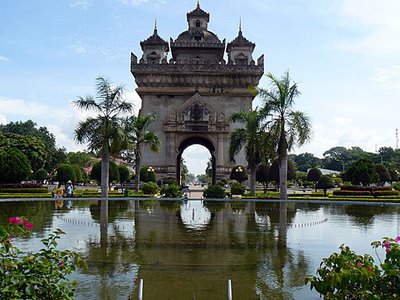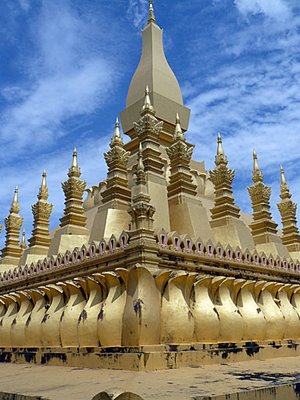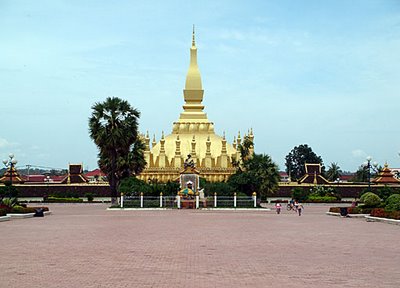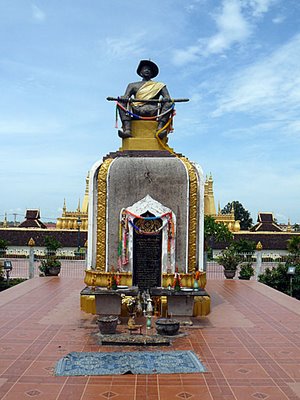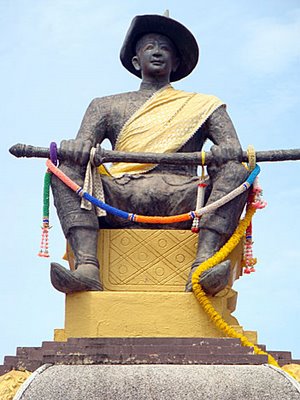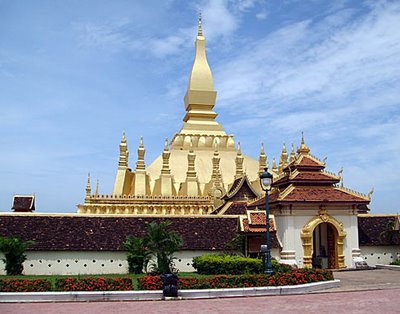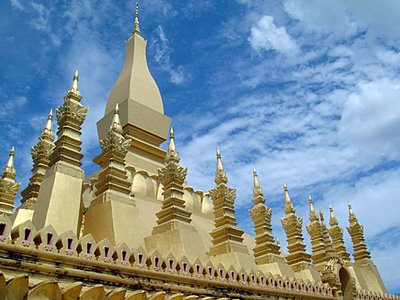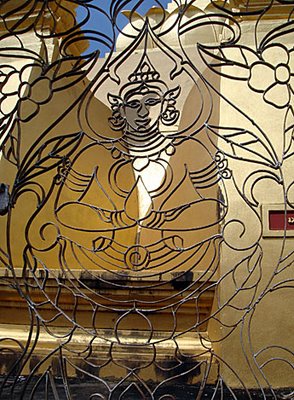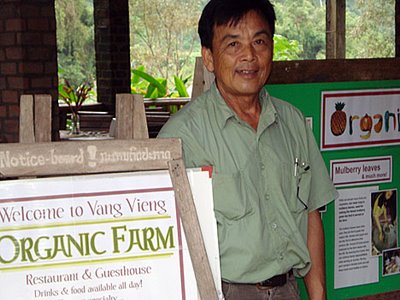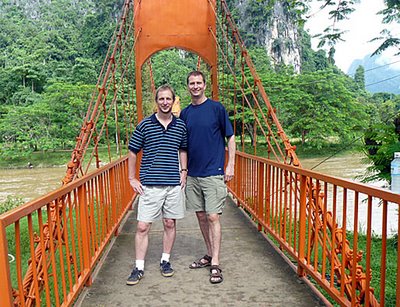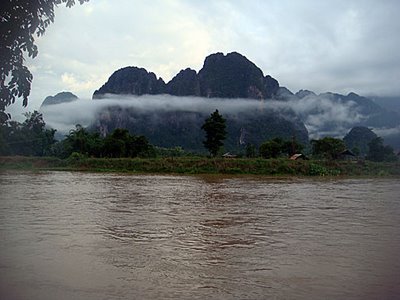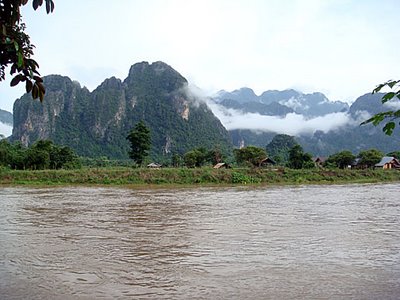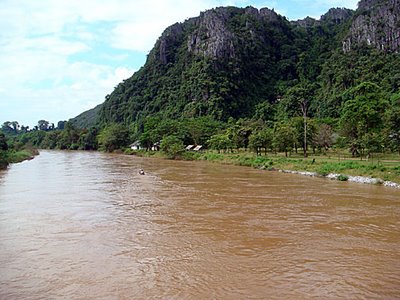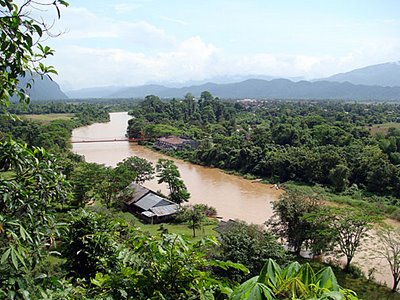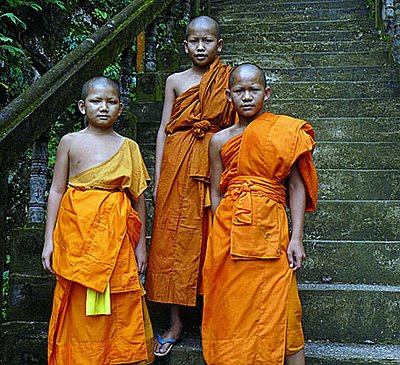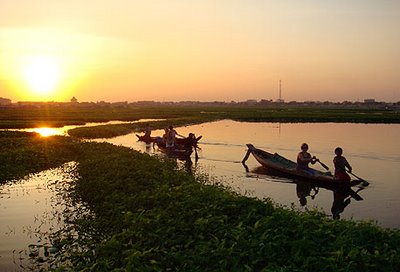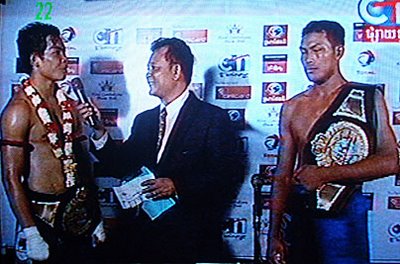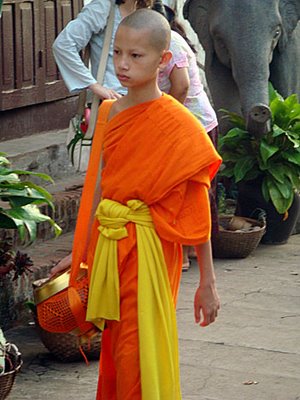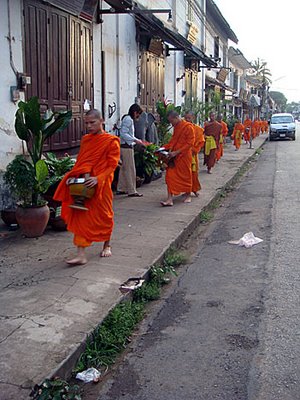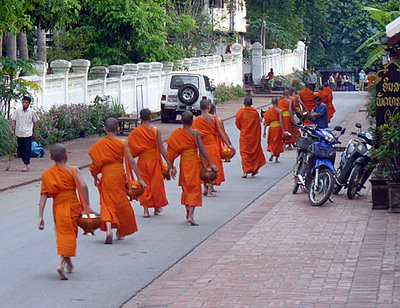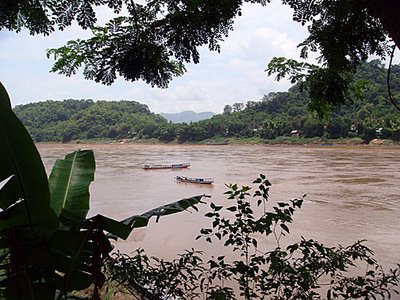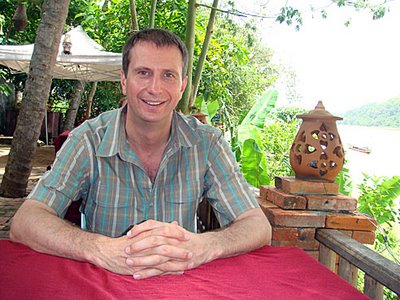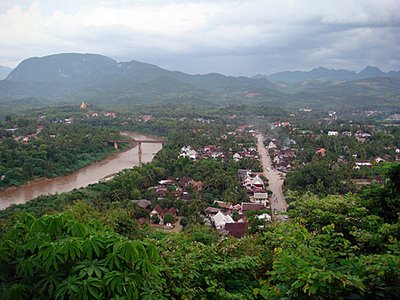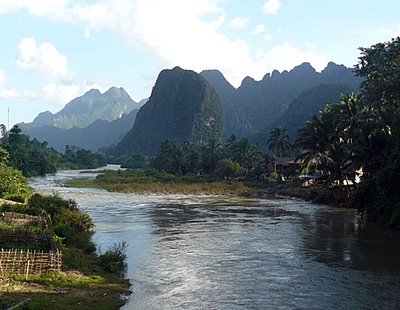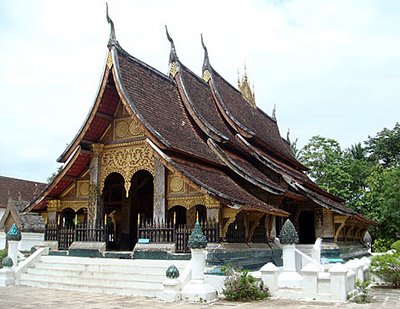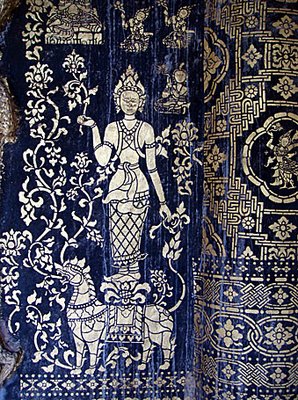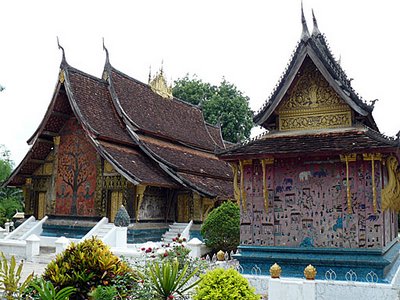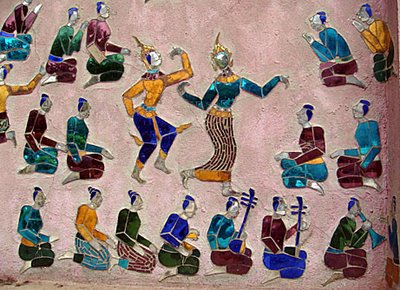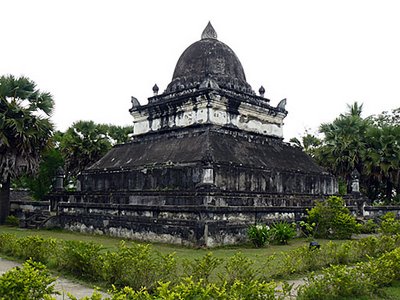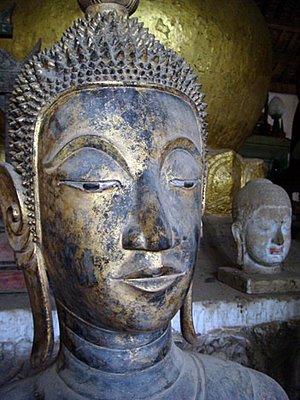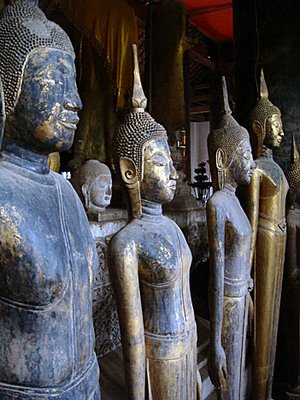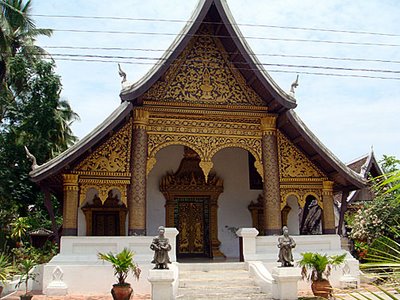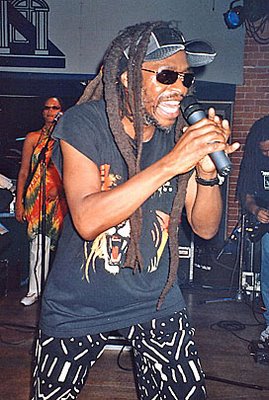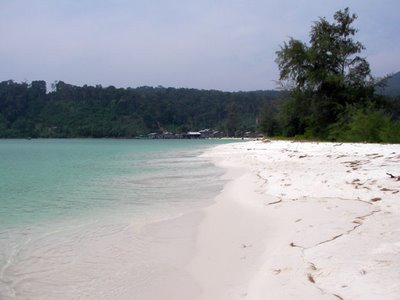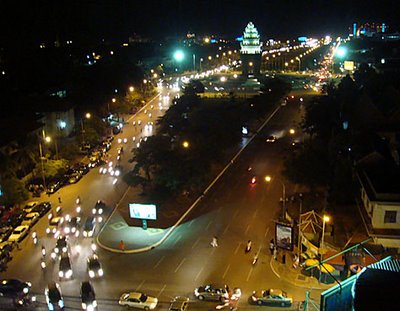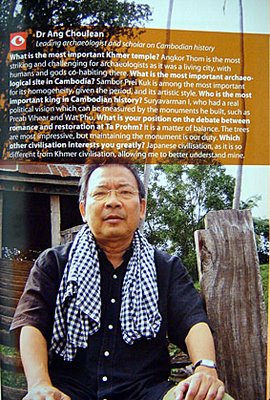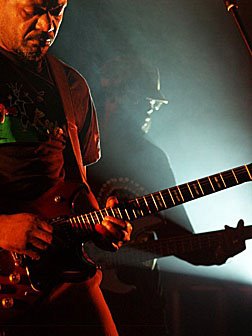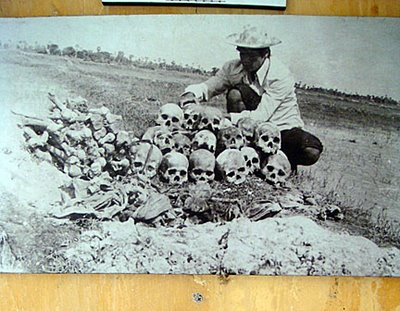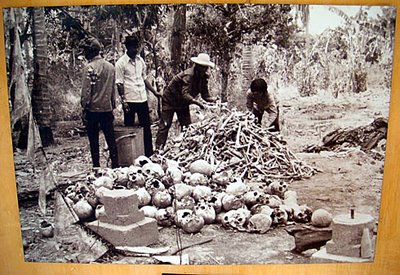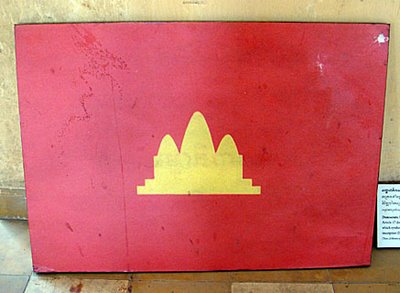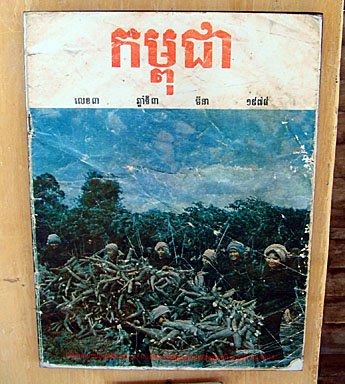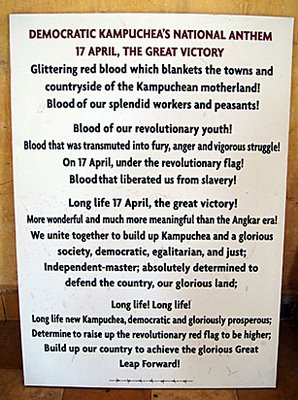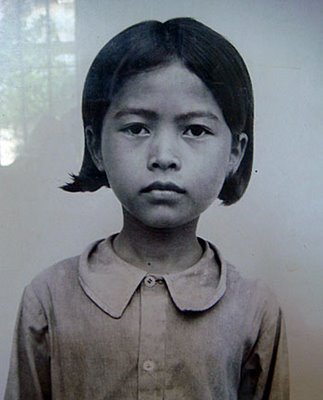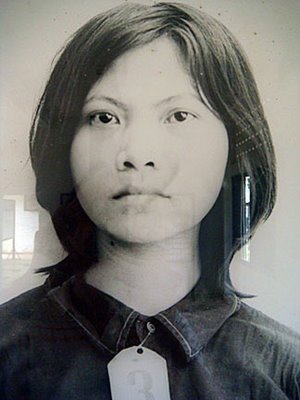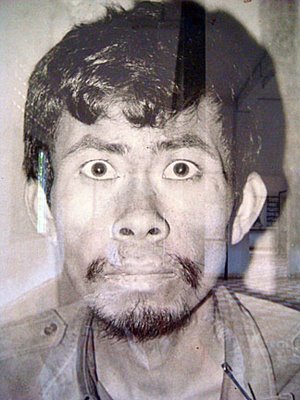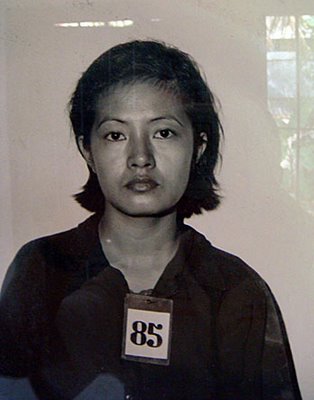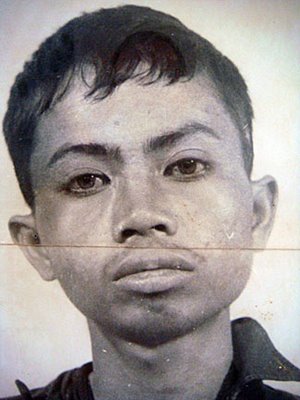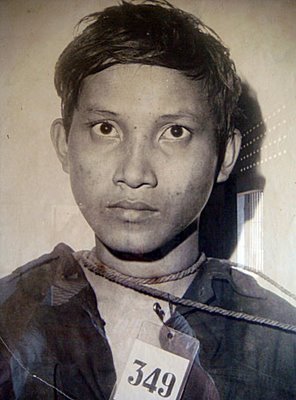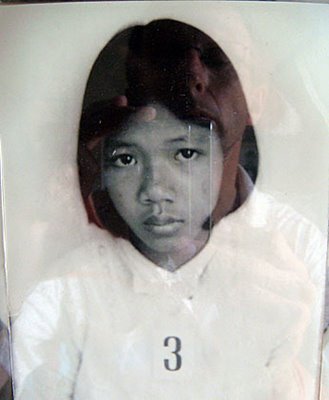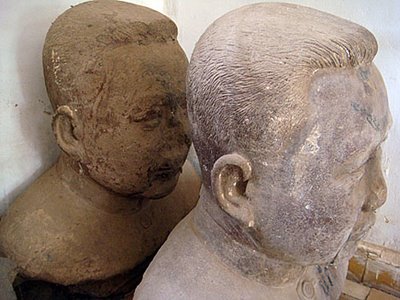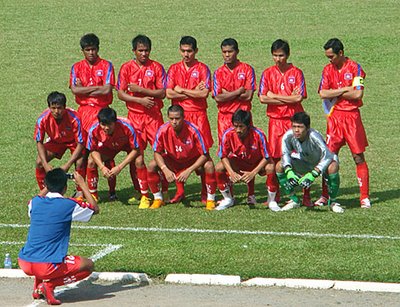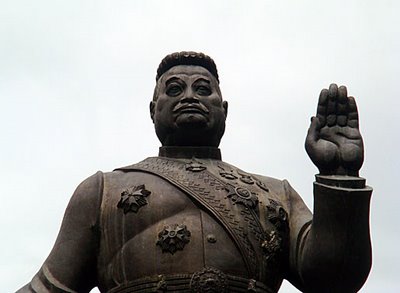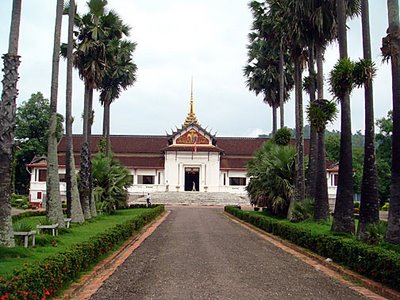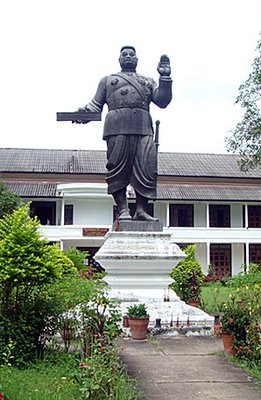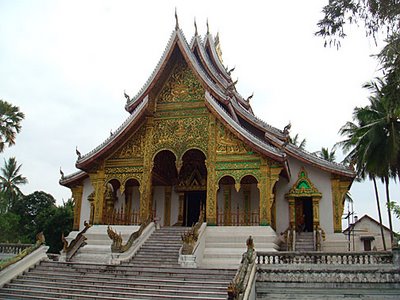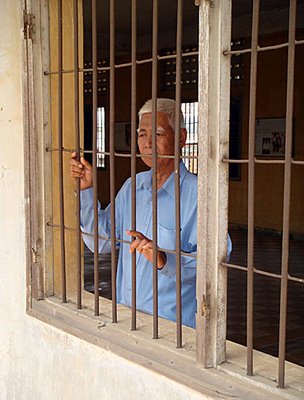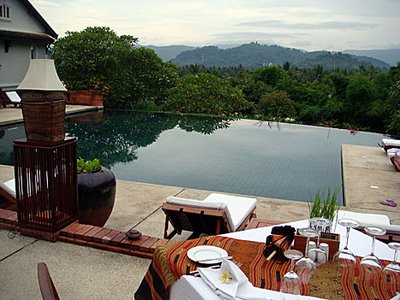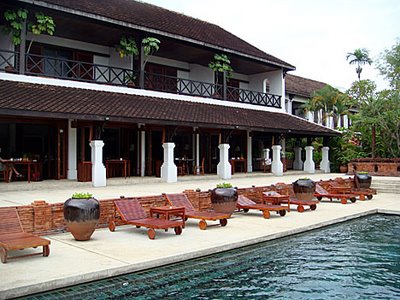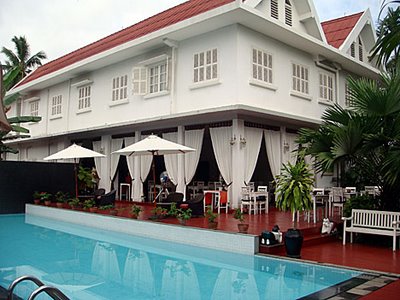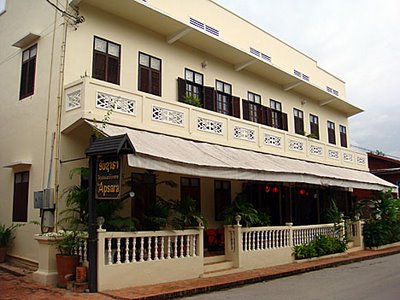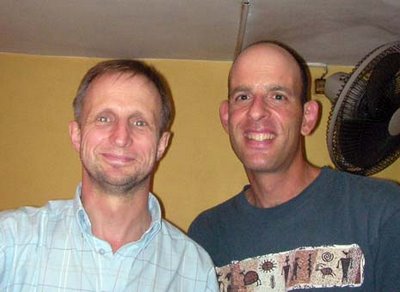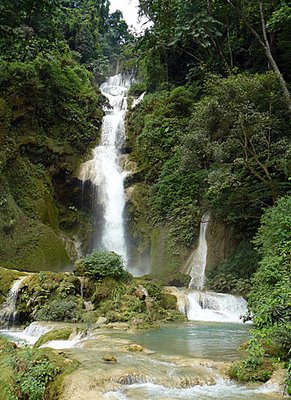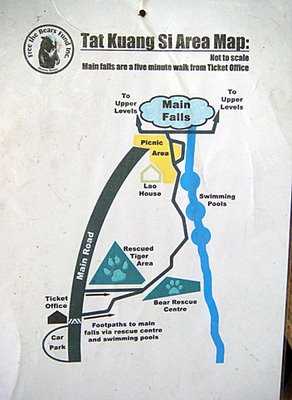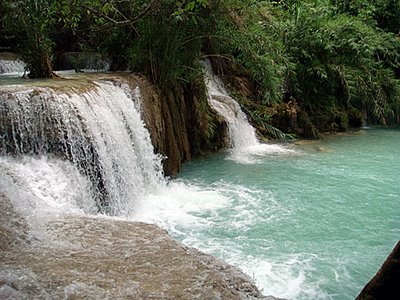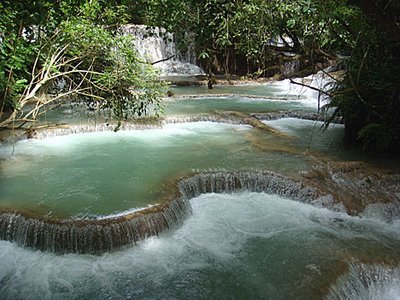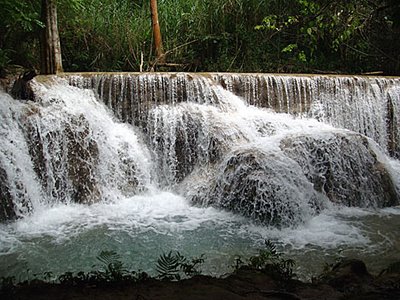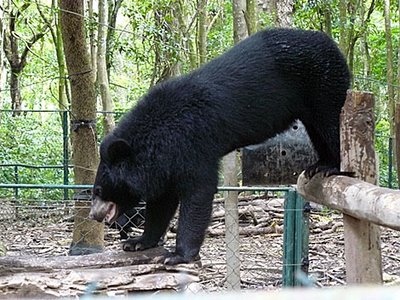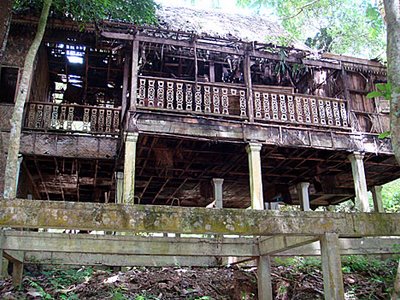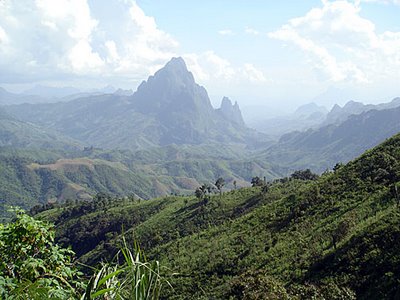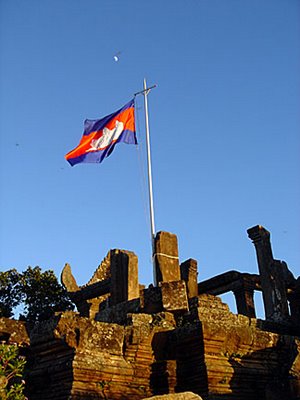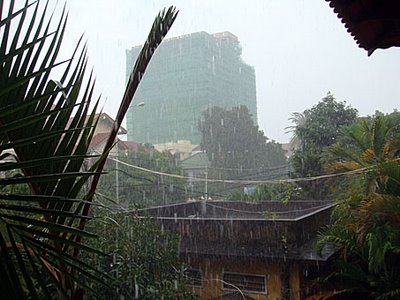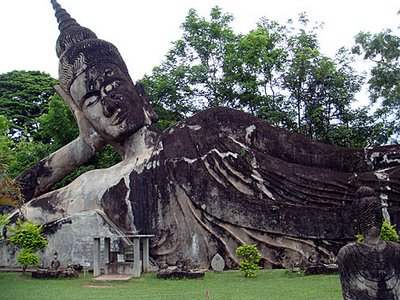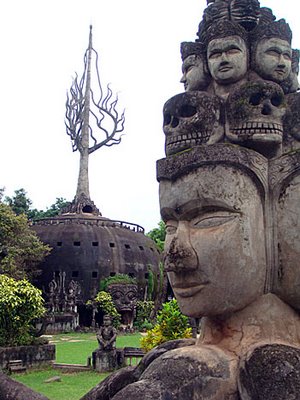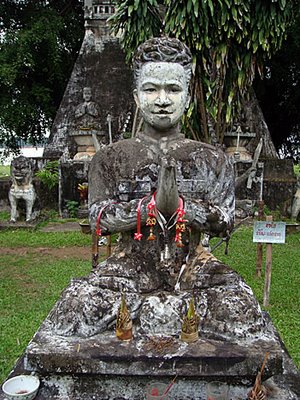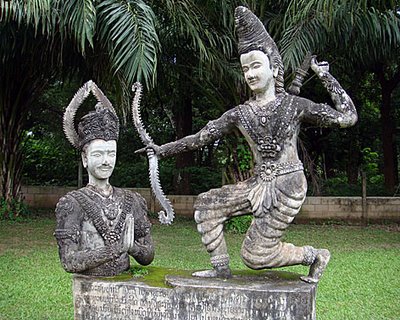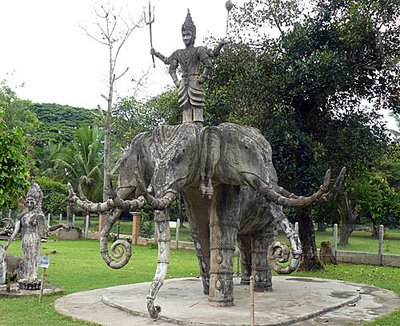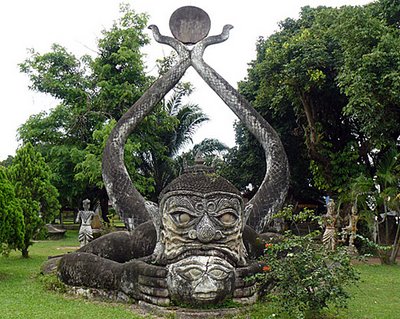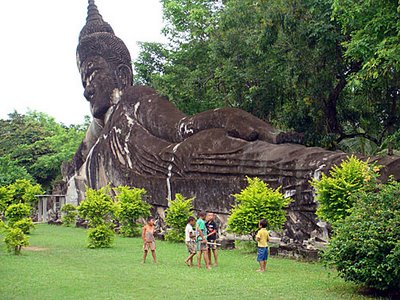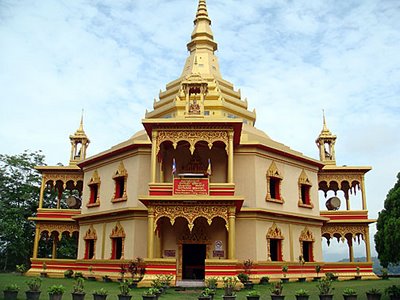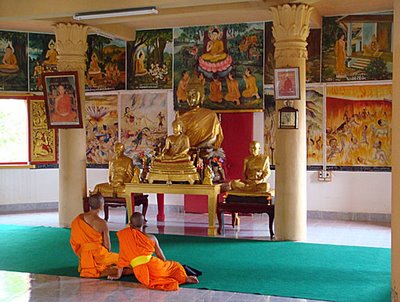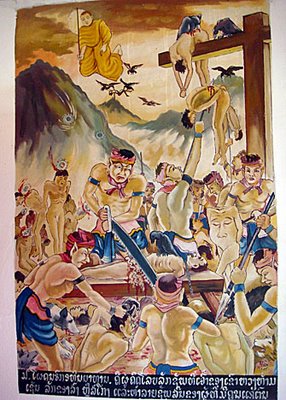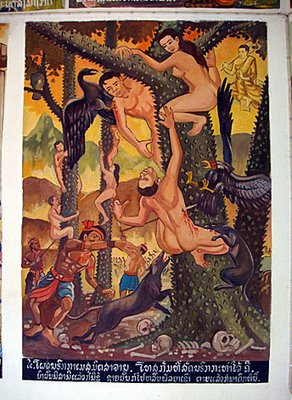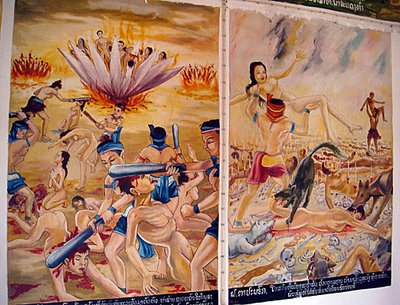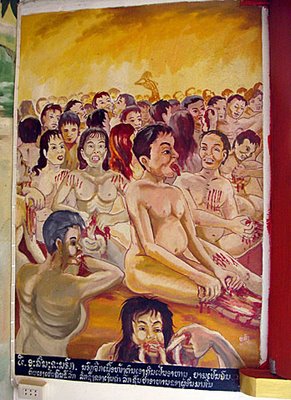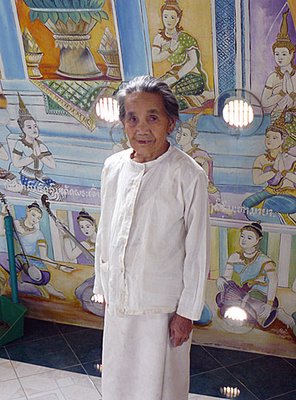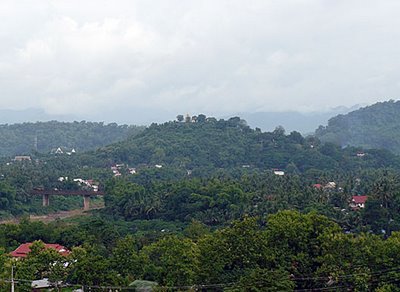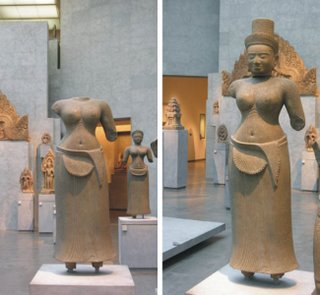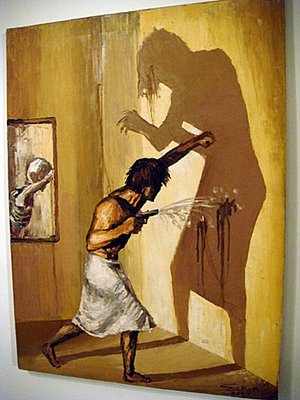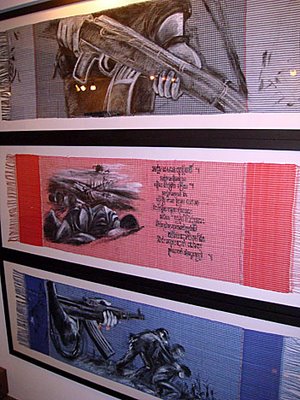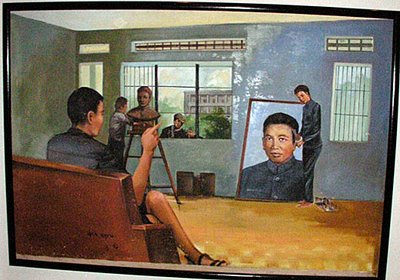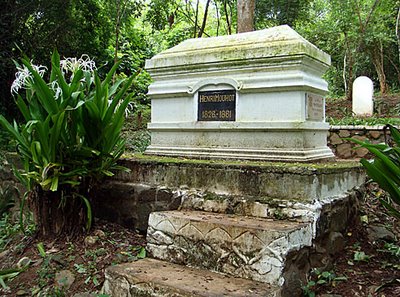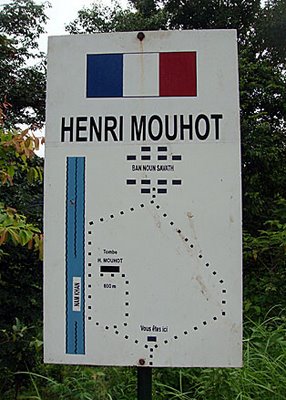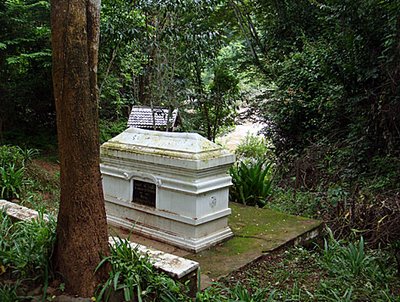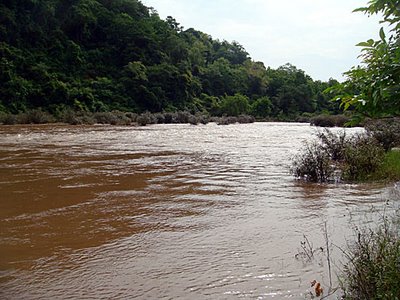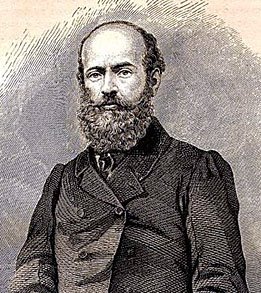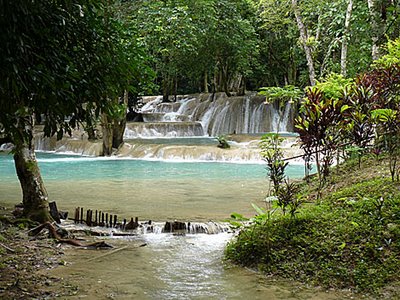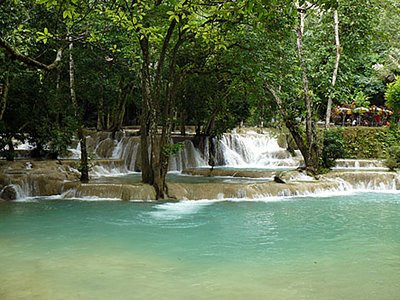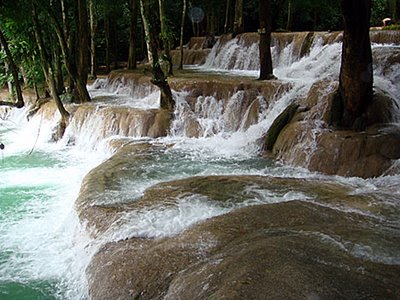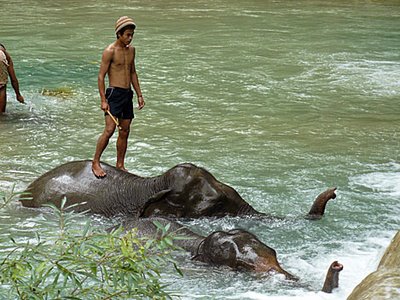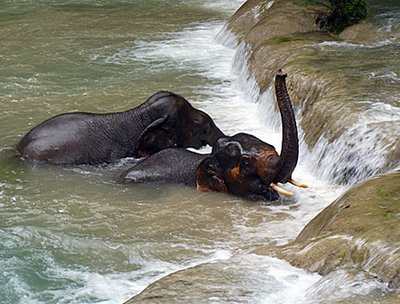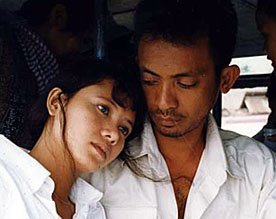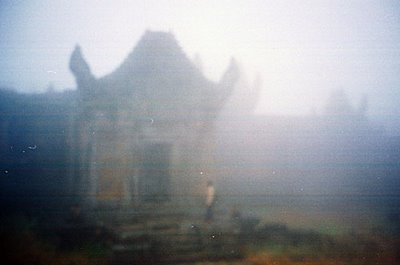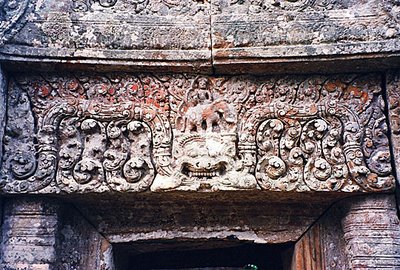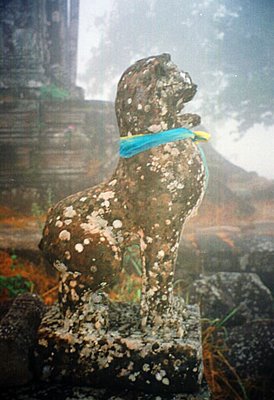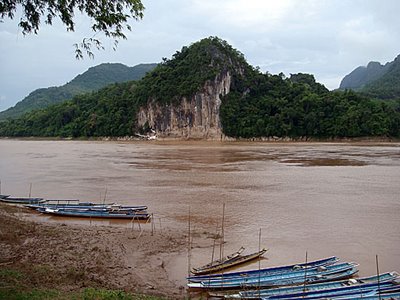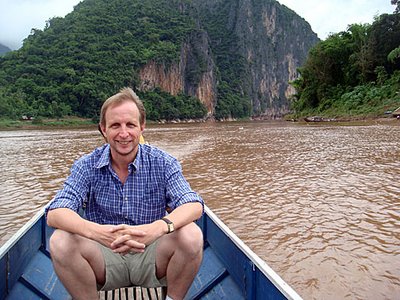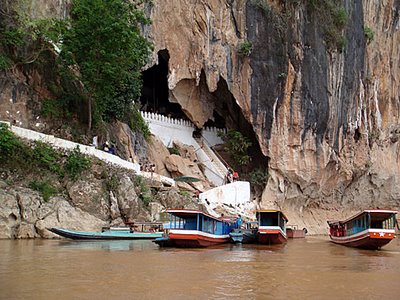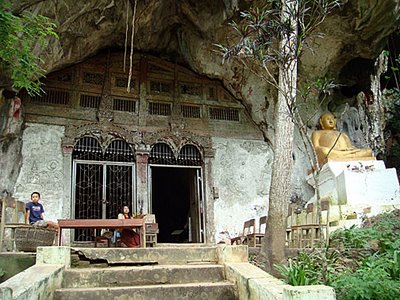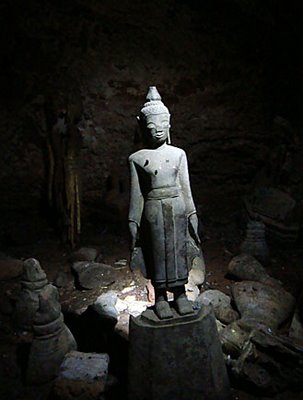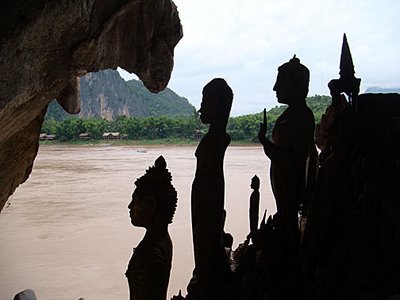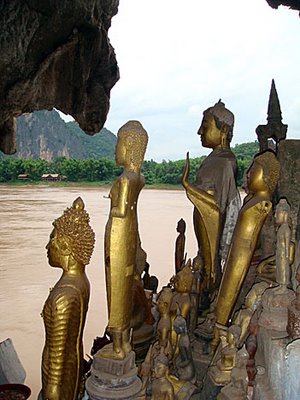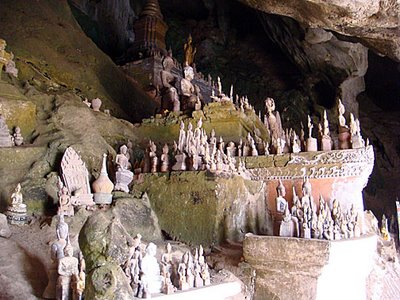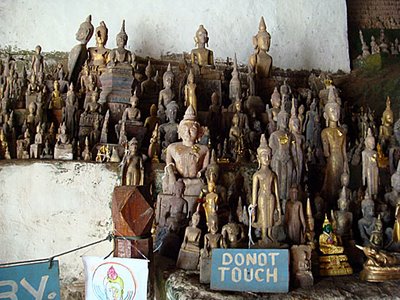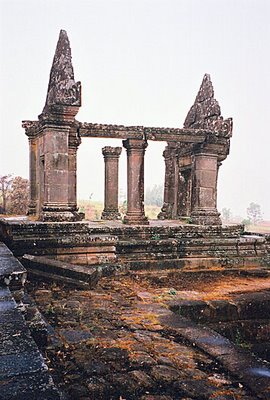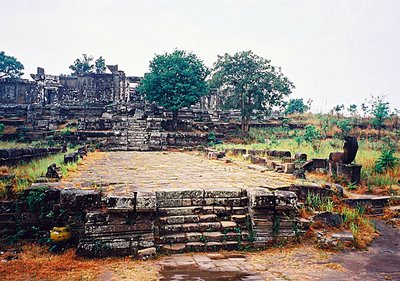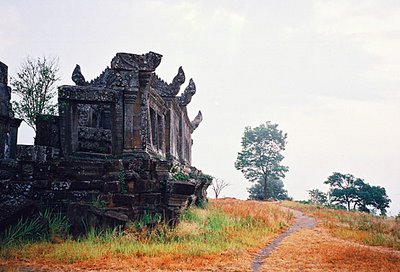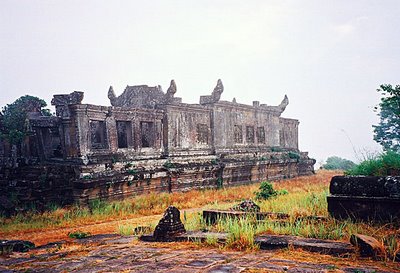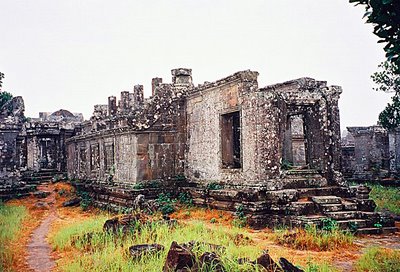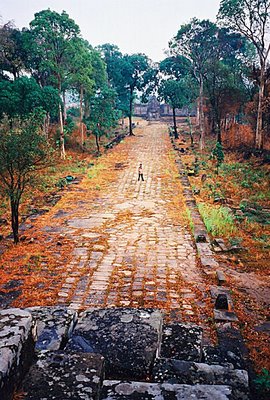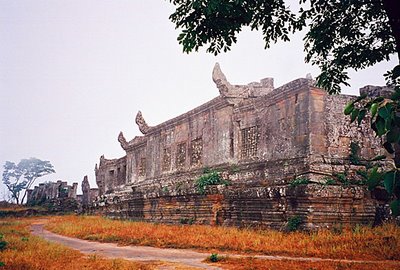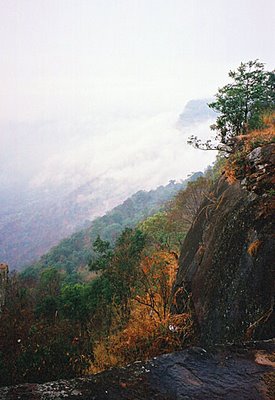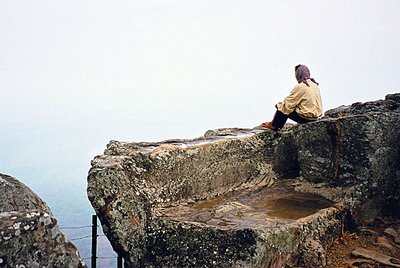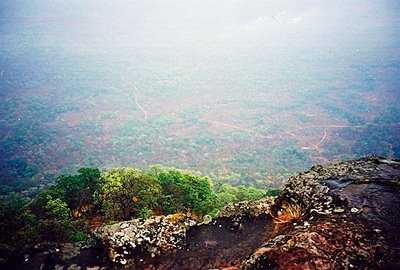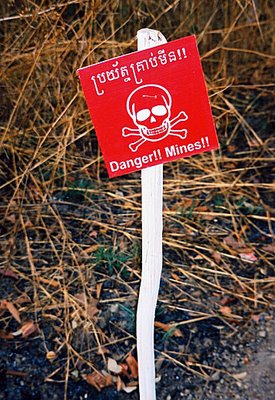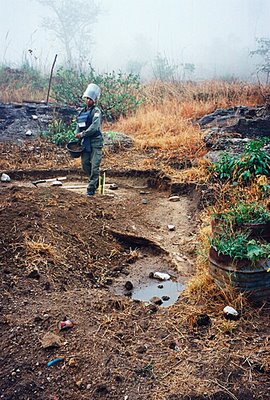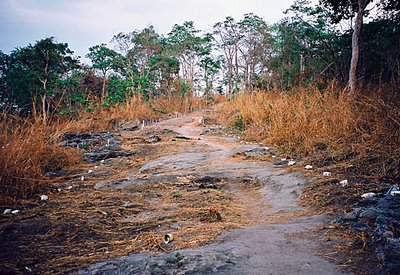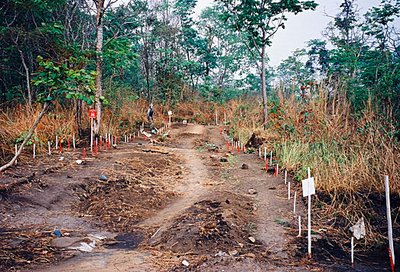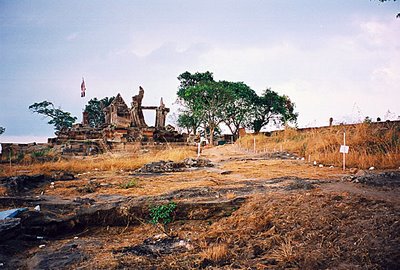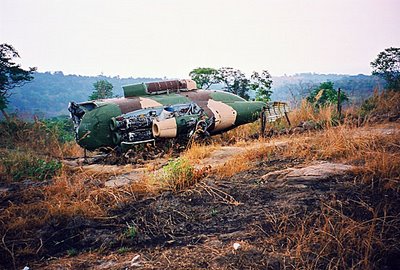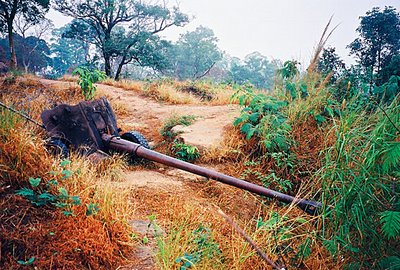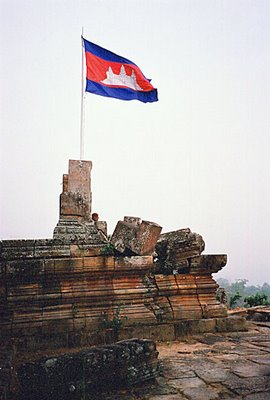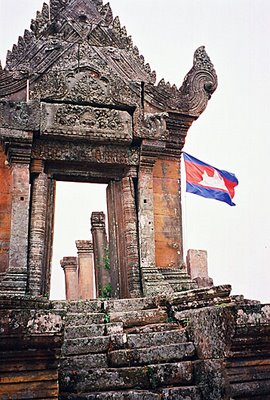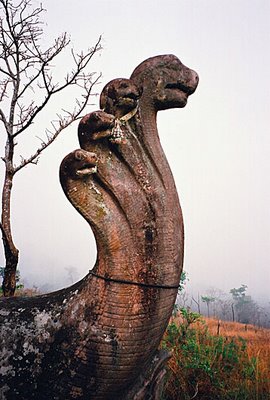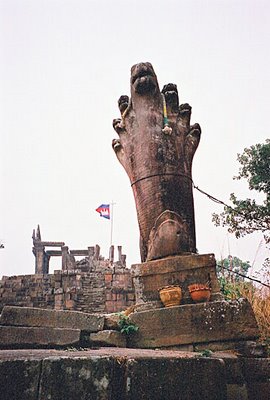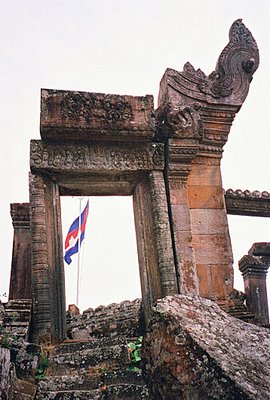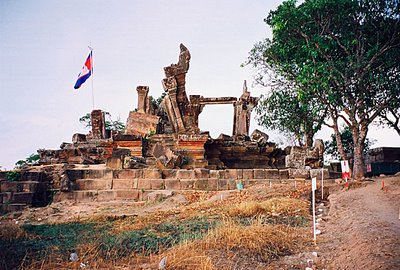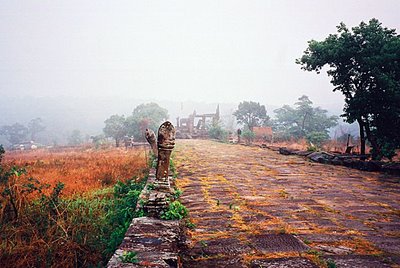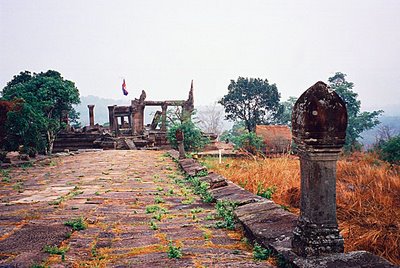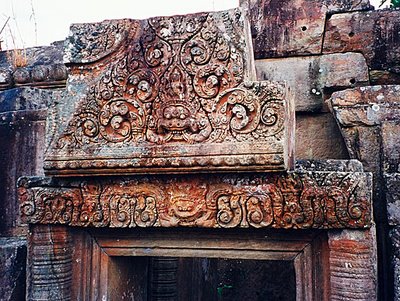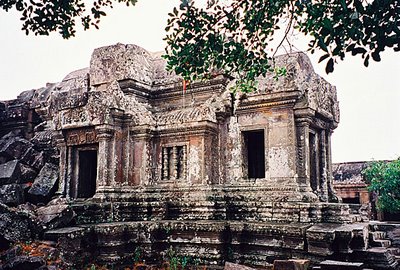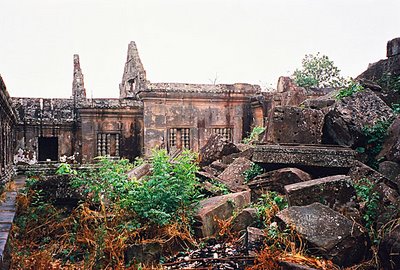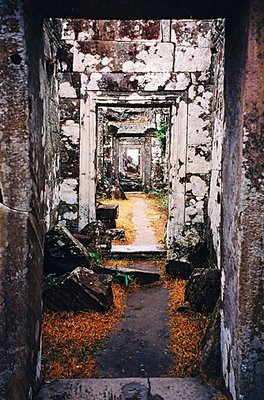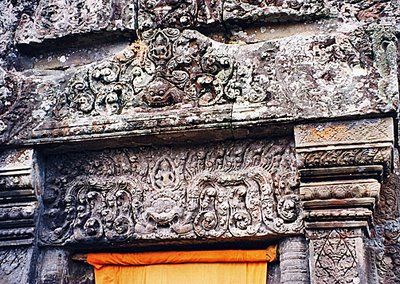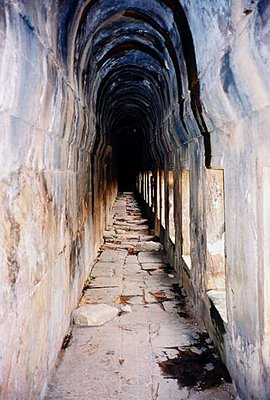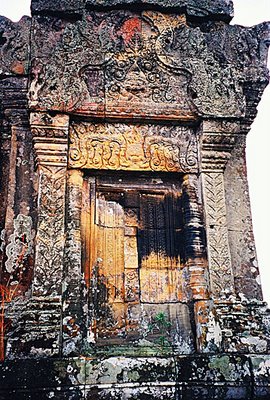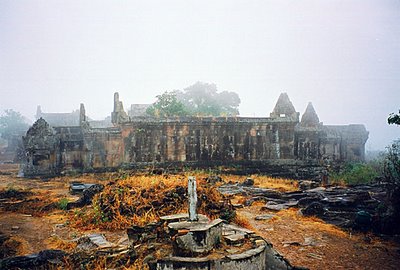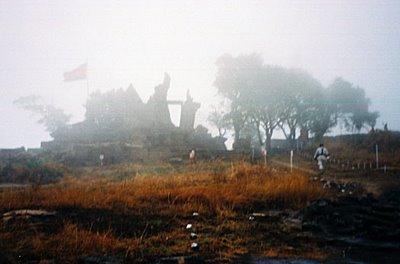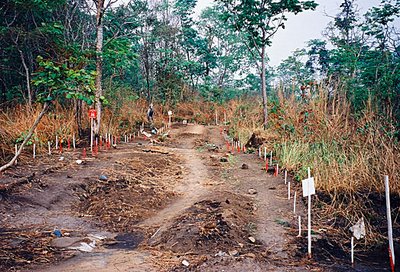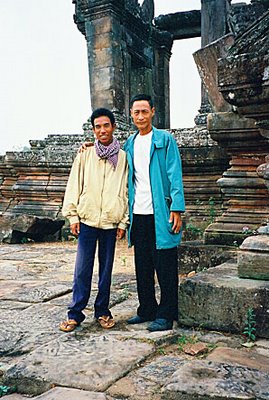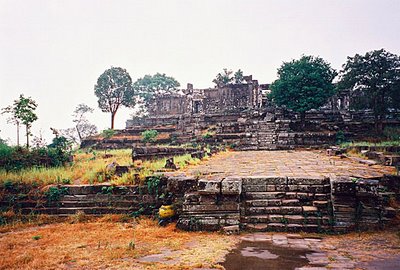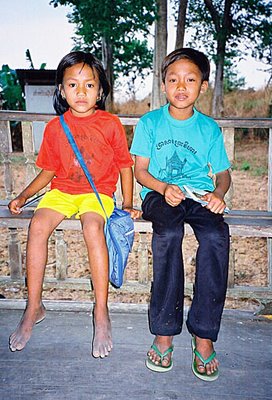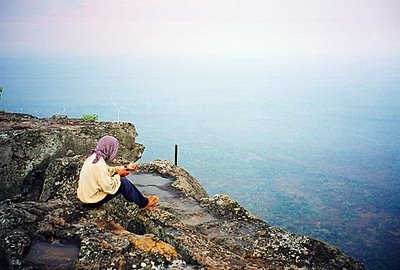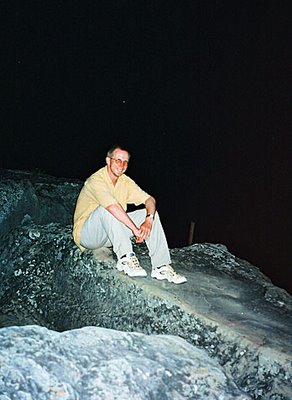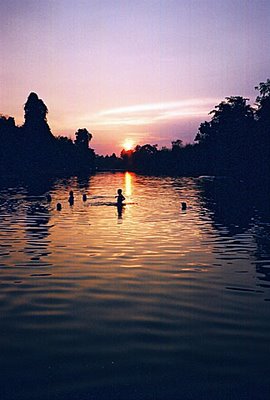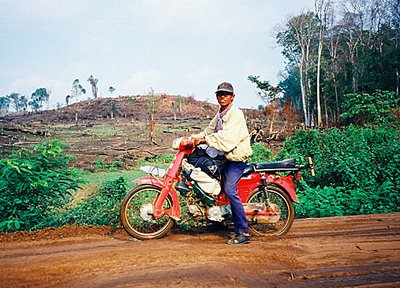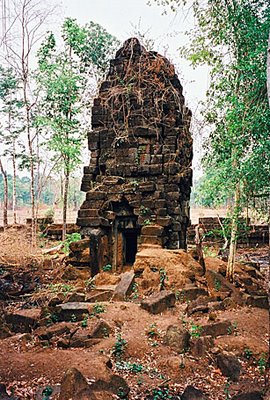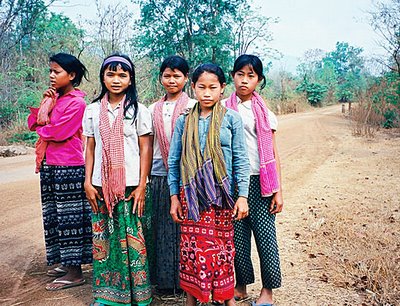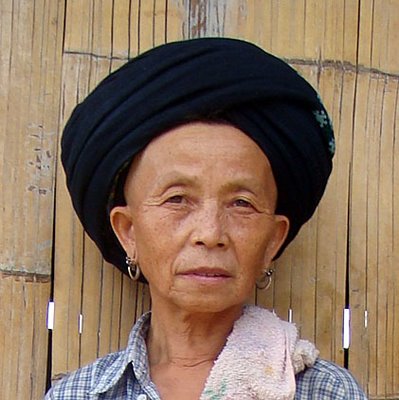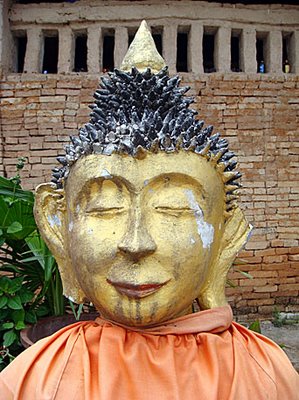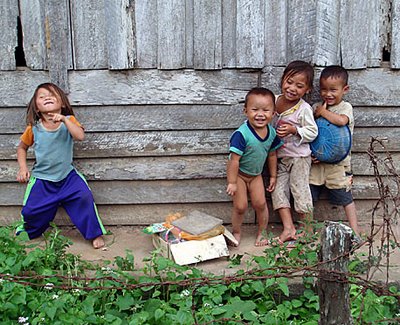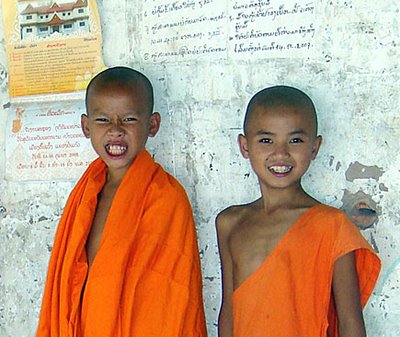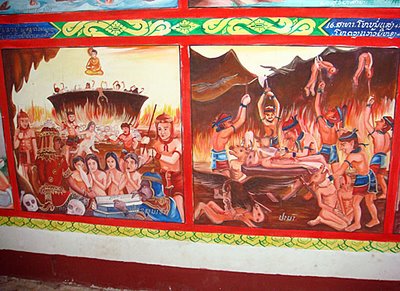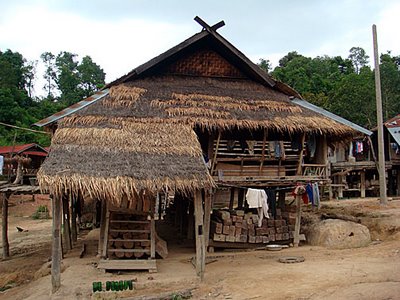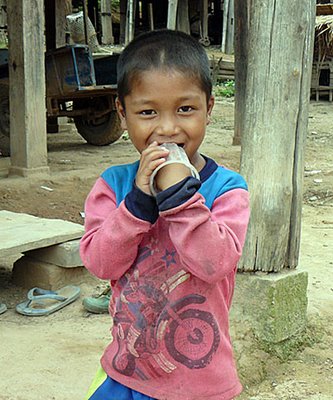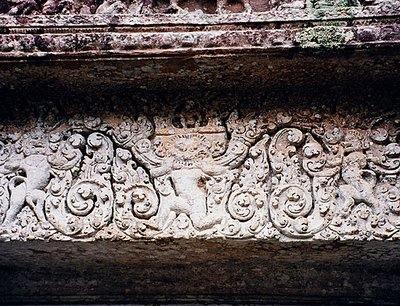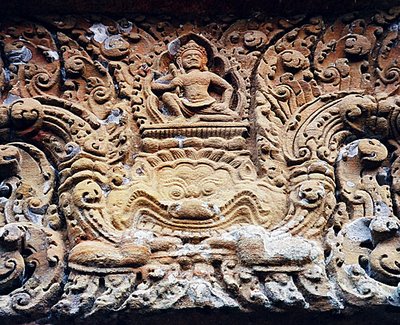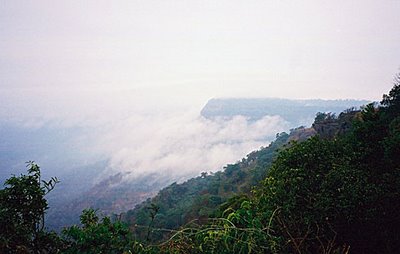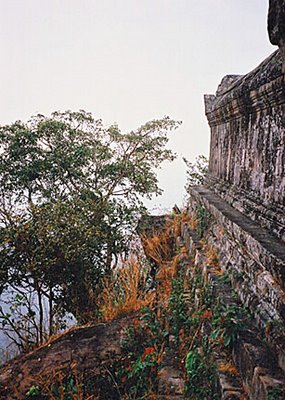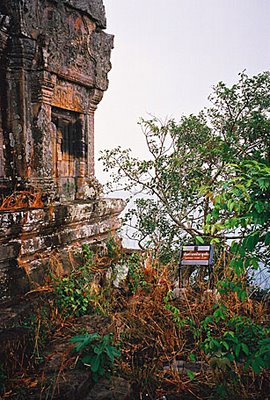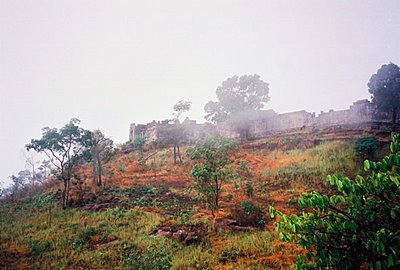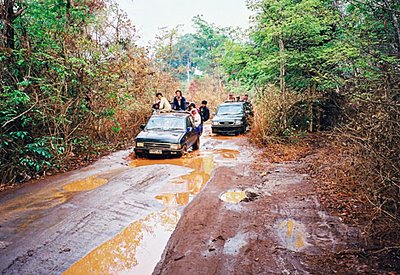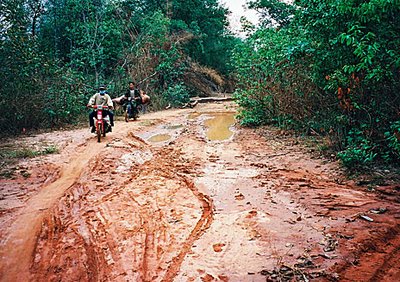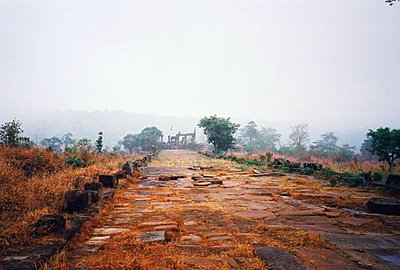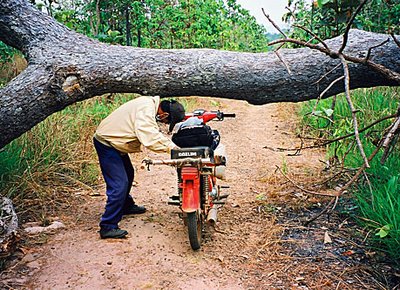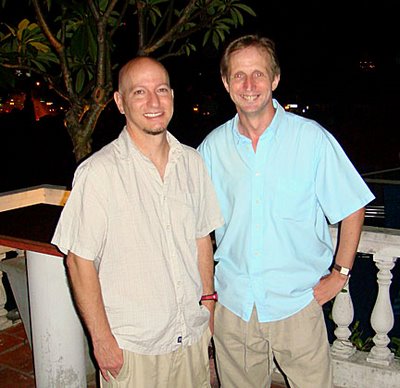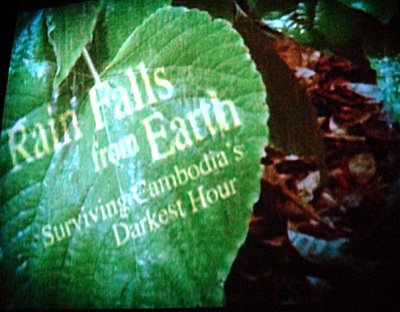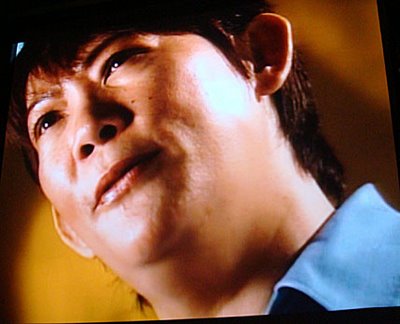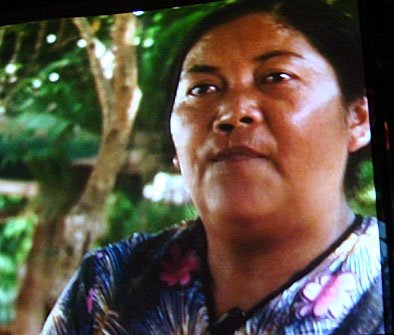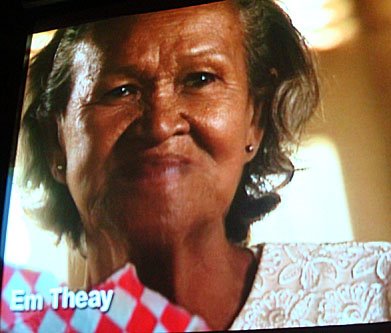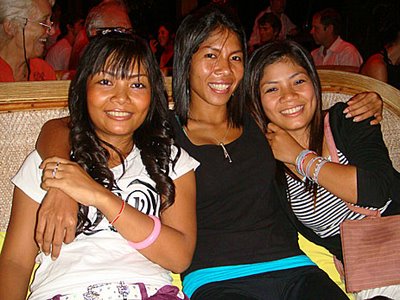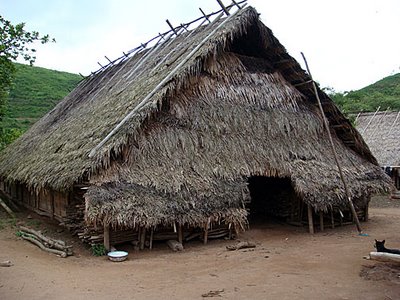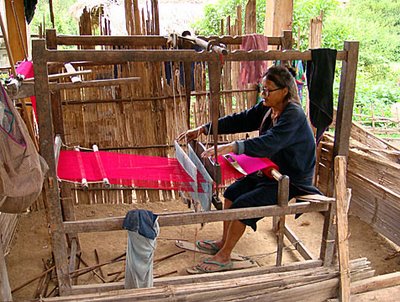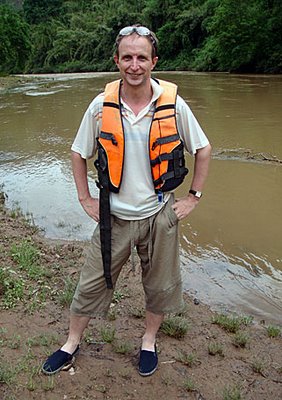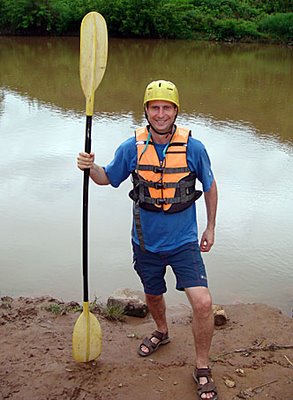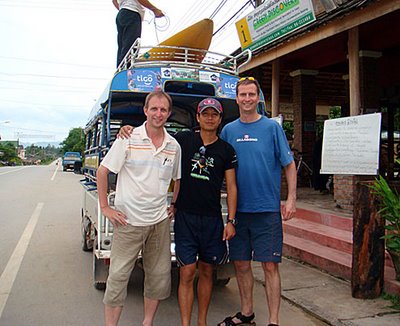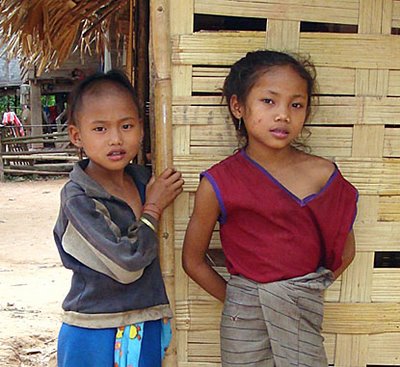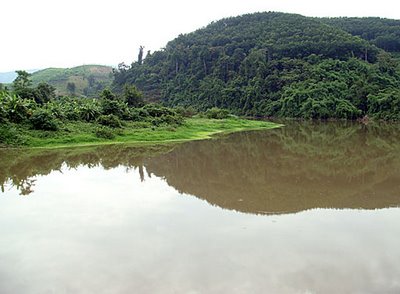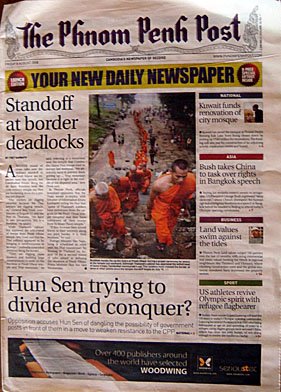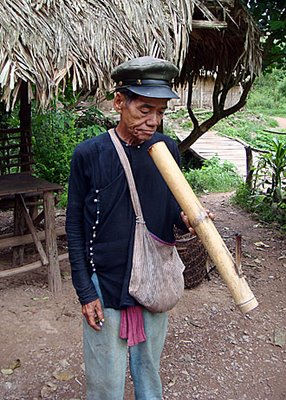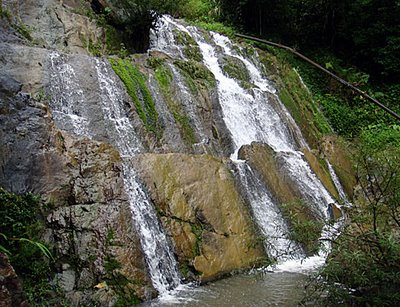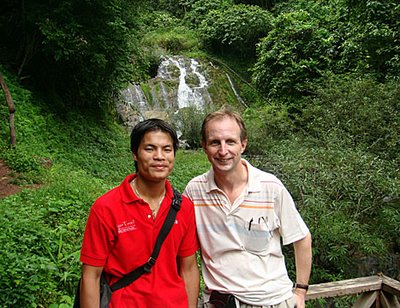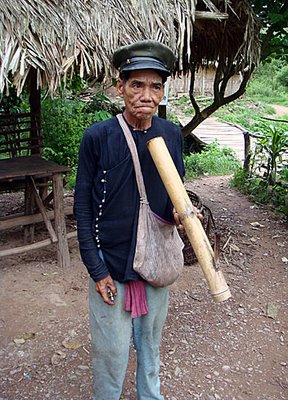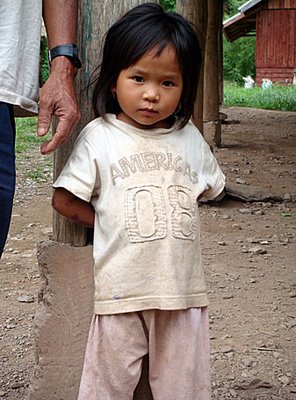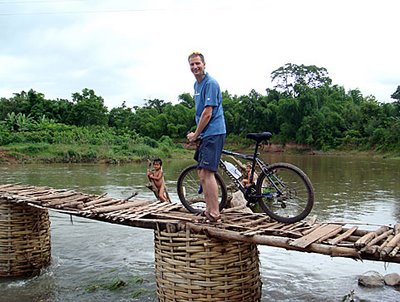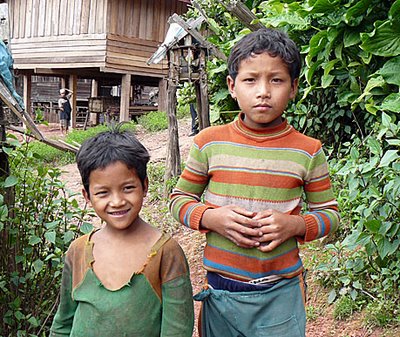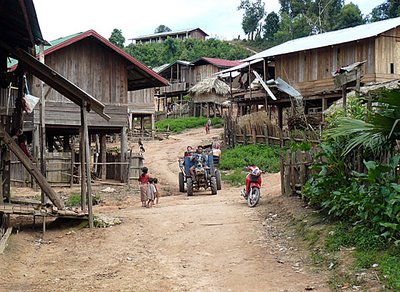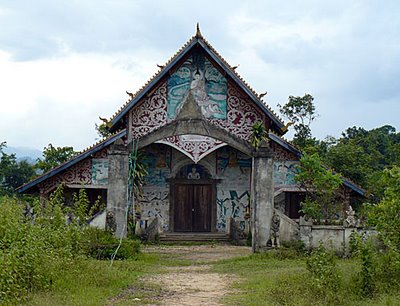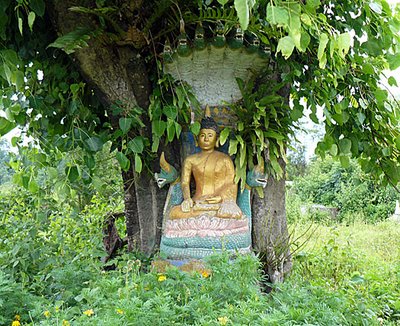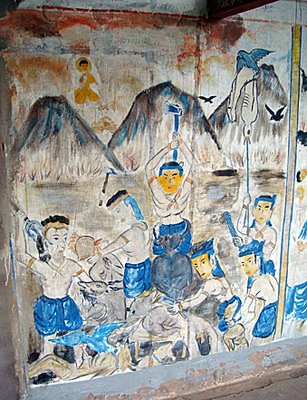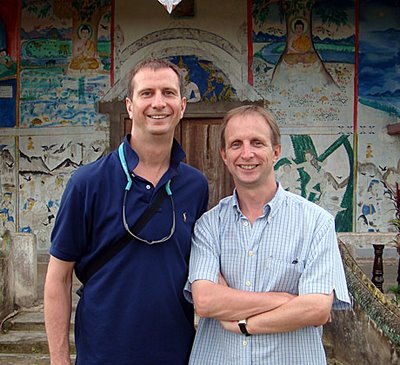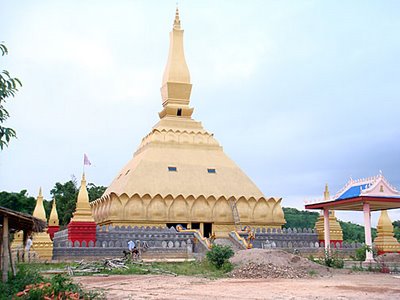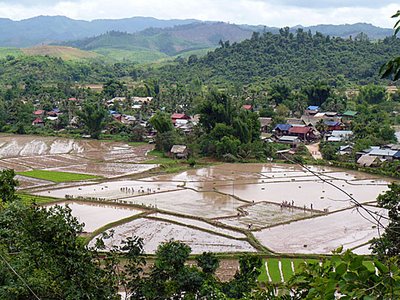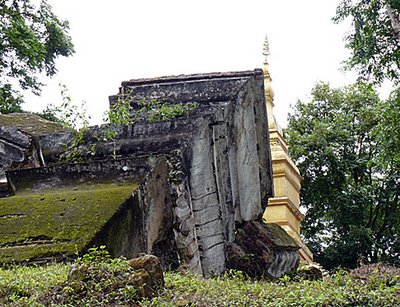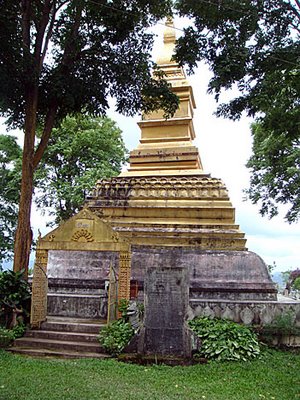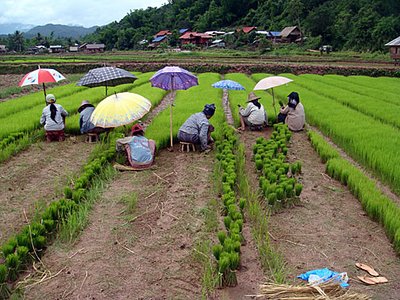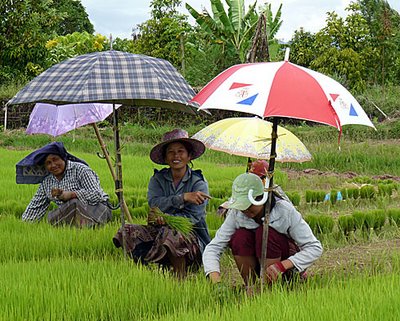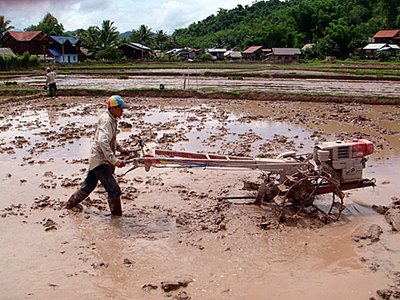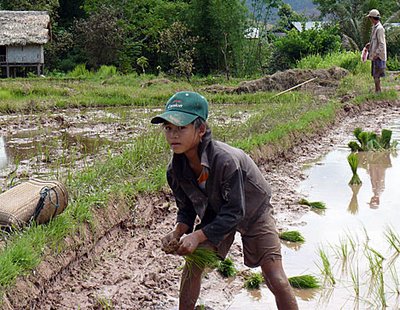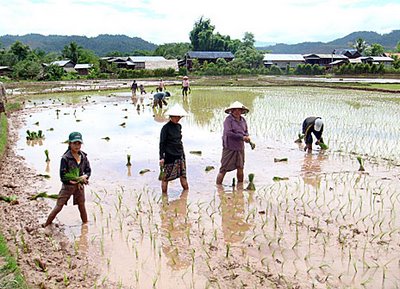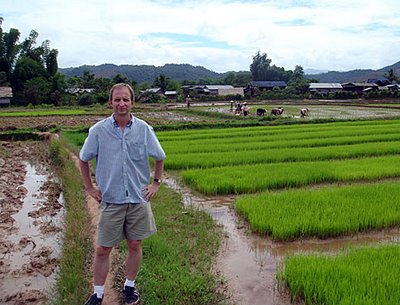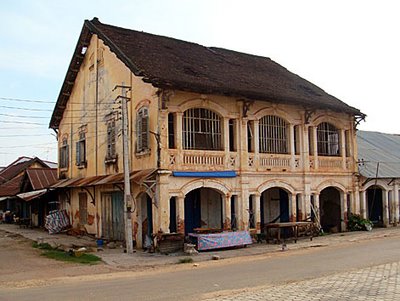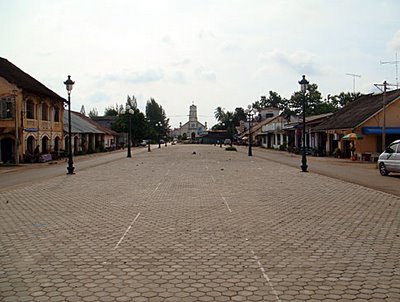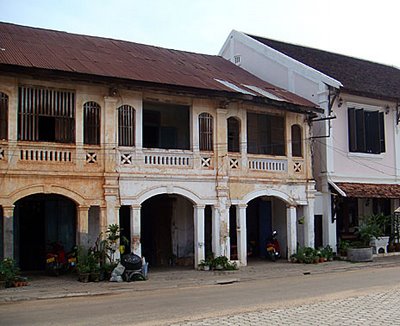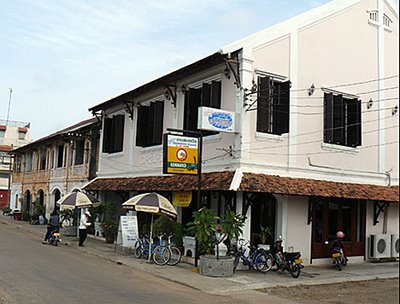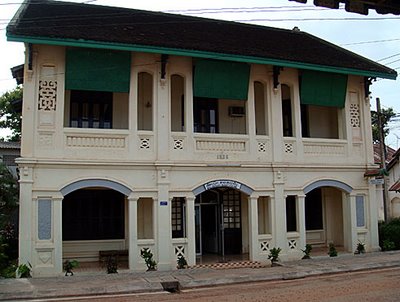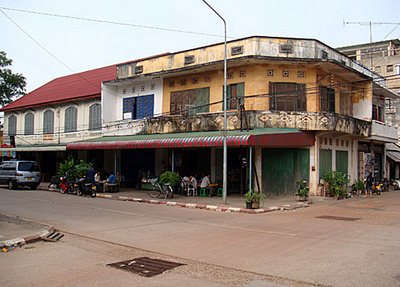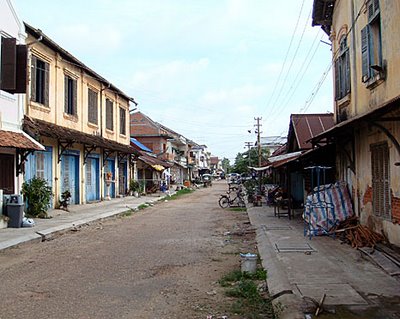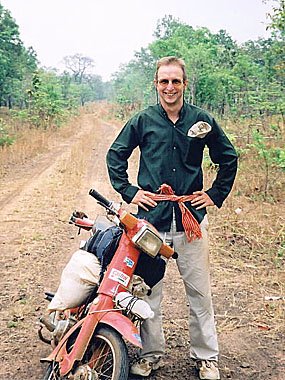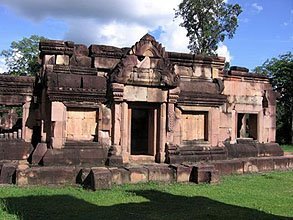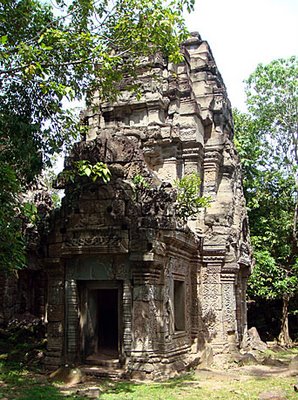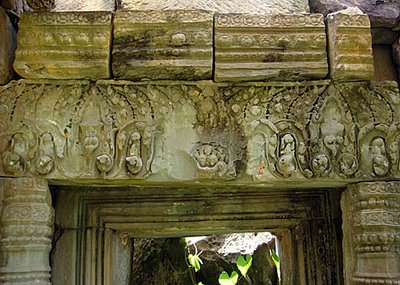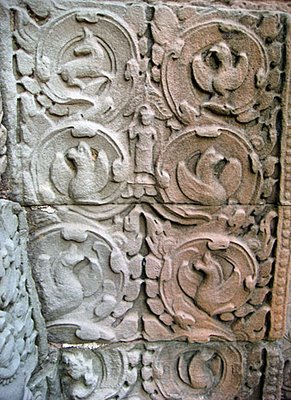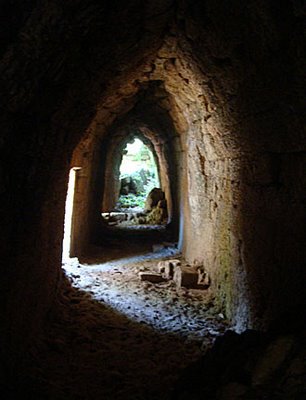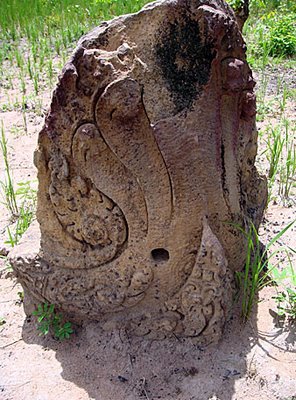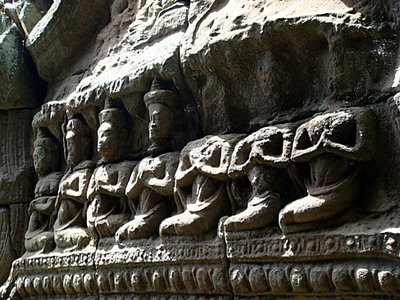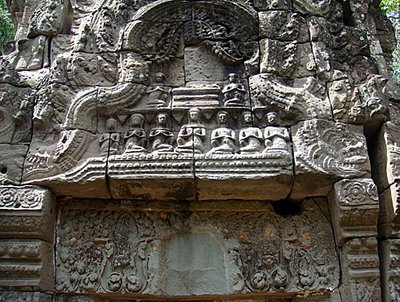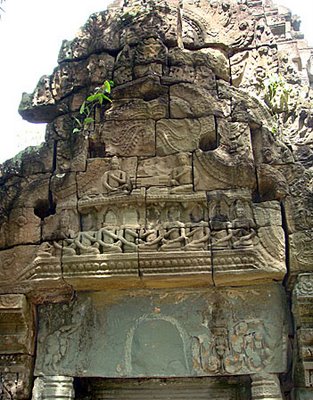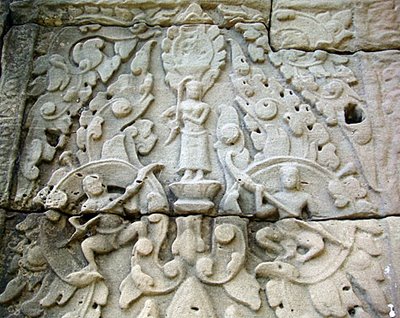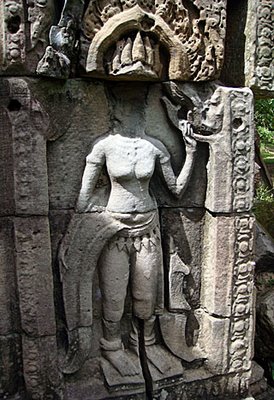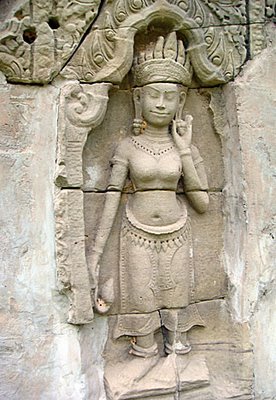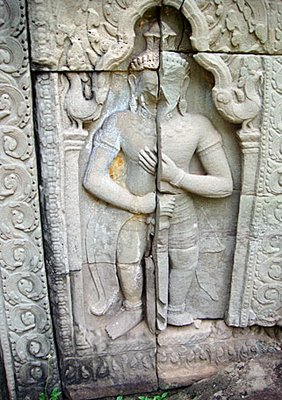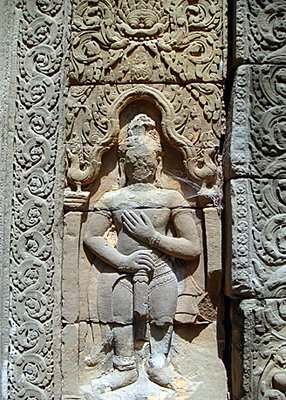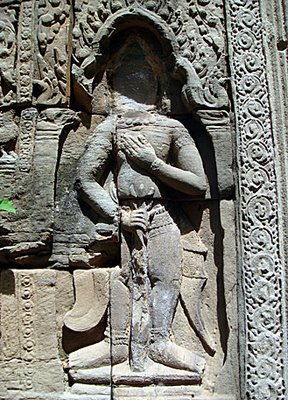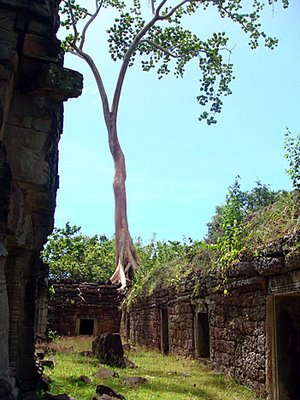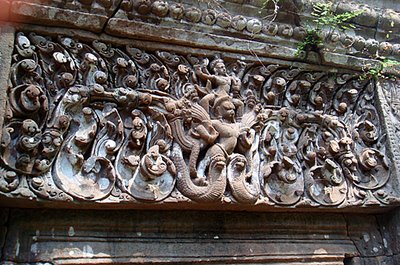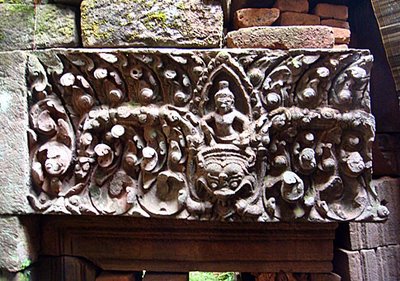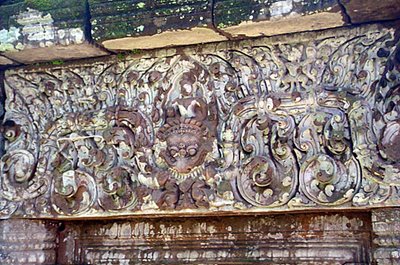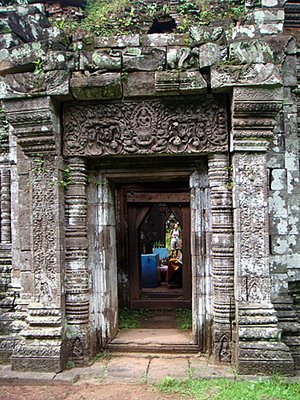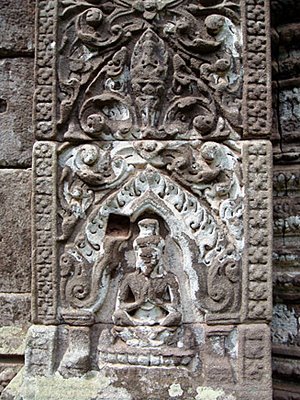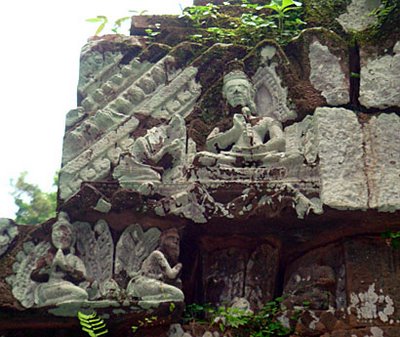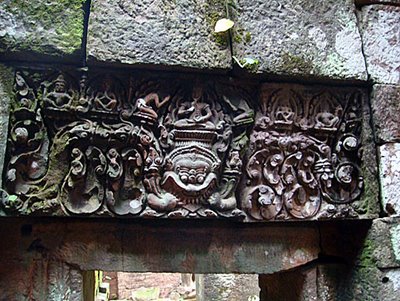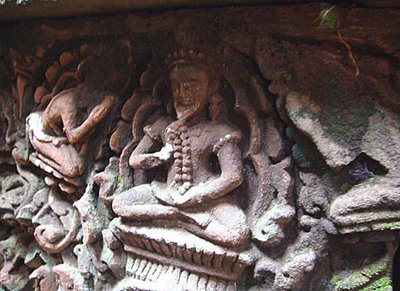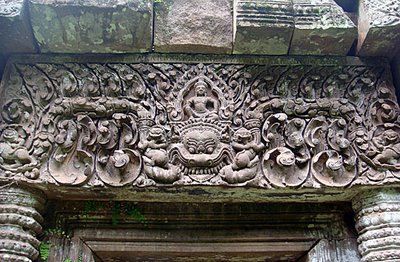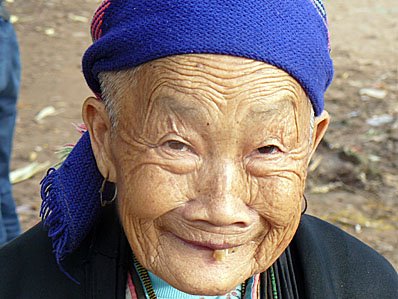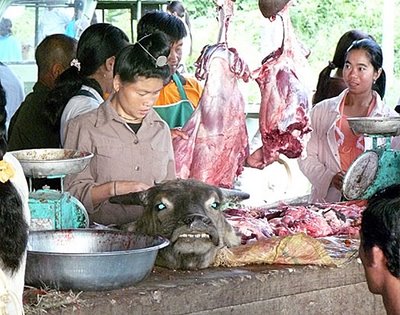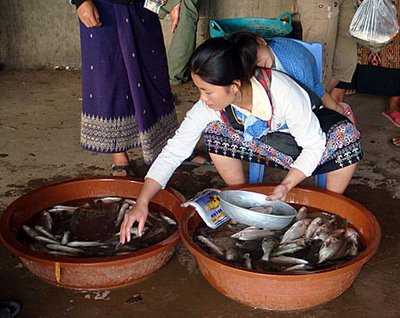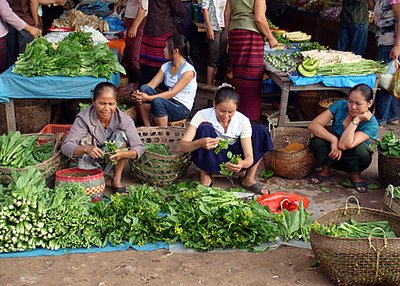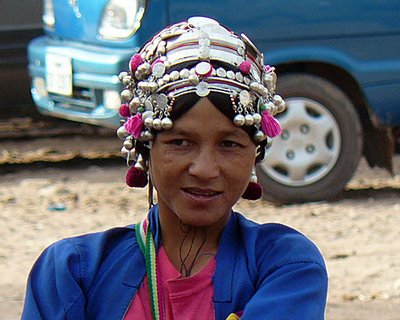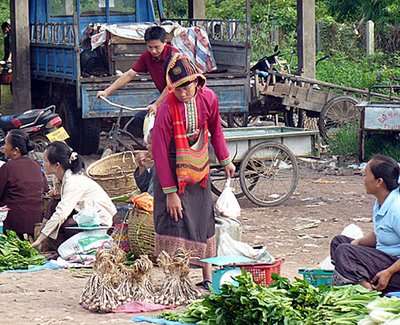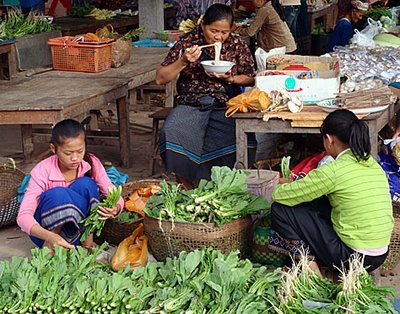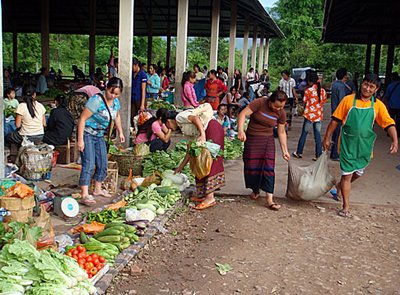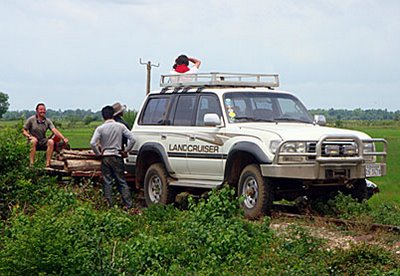Sunday, August 31, 2008
Voyage of discovery
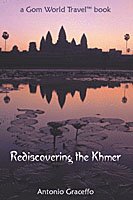 Antonio Graceffo is irrepressible. He will try his hand at everything and anything. In recent months he's trained to become an emergency medical technician in the Philippines, and that was after spending the preceding five months with the Shan State Army rebels in Burma for a film, In Shanland, documenting human rights abuses of the Burmese government against ethnic minority people. Better known for his martial arts activities, he's travelled throughout Cambodia and those travels have just been published by Gom Press as an e-book, available online for under $10, in Rediscovering the Khmer. It should also be out in paperback in October. His first Cambodian book, Letters from the Penh, a mix of journalism, diaries, and short stories, has never found a publisher. His second book began at Angkor Wat, and included hiking, bicycling, riding elephants, fighting, and scuba diving his way around the country. To find out more go to his website at www.speakingadventure.com.
Antonio Graceffo is irrepressible. He will try his hand at everything and anything. In recent months he's trained to become an emergency medical technician in the Philippines, and that was after spending the preceding five months with the Shan State Army rebels in Burma for a film, In Shanland, documenting human rights abuses of the Burmese government against ethnic minority people. Better known for his martial arts activities, he's travelled throughout Cambodia and those travels have just been published by Gom Press as an e-book, available online for under $10, in Rediscovering the Khmer. It should also be out in paperback in October. His first Cambodian book, Letters from the Penh, a mix of journalism, diaries, and short stories, has never found a publisher. His second book began at Angkor Wat, and included hiking, bicycling, riding elephants, fighting, and scuba diving his way around the country. To find out more go to his website at www.speakingadventure.com.
Saturday, August 30, 2008
A national symbol
Friday, August 29, 2008
Home-grown success
Activities and scenery
Monkey success
Huge Endangered Monkey Population Discovered in Cambodia
Just when you think modern technology reveals all, Mother Nature throws out a few surprises. According to a Wildlife Conservation Society(WCS) report, two surprisingly large populations of globally threatened primates have been found in Cambodia. The report counted 42,000 black-shanked douc langurs along with 2,500 yellow-cheeked crested gibbons in Cambodia's Seima Biodiversity Conservation Area, an estimate that represents the largest known populations for both species in the world.
The two primate species are found in much lower numbers at other sites in Cambodia and in Vietnam. Prior to the recent discovery in the Seima Biodiversity Conservation Area, the largest known populations were believed to be in adjacent Vietnam, where black-shanked douc langurs and yellow-cheeked crested gibbons hover at 600 and 200 respectively. The total population of the two species remains unknown. You may be wondering how something can be endangered if the population is unknown. Science has no answer for that. Regardless of the new finds, conservationists are rarely happy people. In Cambodia, WCS researchers are concerned that looming threats could jeopardize these recent successes.
WCS scientists conducted the surveys with the Cambodia's Ministry of Agriculture, Forestry and Fisheries across an area of 300 square miles (789 square kilometers) within a wider landscape of 1,150 square miles (3,000 square kilometers), which is about the size of Yosemite National Park. The scientists believe total populations within the wider landscape may be considerably greater. The recent census in Cambodia took place in a former logging area where the two monkeys were once extensively hunted. Then in 2002, the Minister of Agriculture, Forestry and Fisheries declared the region a conservation area and began working with WCS on site management and landscape-level planning for conservation and local development.
According to WCS, a combination of factors account for such high numbers of primates: successful long-term management of the conservation area; cessation of logging activities; a nation-wide gun confiscation program implemented in the 1990s; and habitat where there is plenty of food. The report says that the two primate populations started to recover in 2002 when the joint program between WCS and the Royal Government began and have remained stable since 2005. "Despite this good news in Cambodia, the area still remains at risk from conversion to agro-industrial plantations for crops, including biofuels, and commercial mining," said Tom Clements, the lead author of the WCS report. "WCS is therefore committed to continuing to work with the Cambodian Government to ensure that these globally important primate populations will continue to remain secure." WCS has worked with the Royal Government of Cambodia since 1999, helping to establish the Seima Biodiversity Conservation Area (in Mondulkiri), and developing landscape-level conservation programs in the Northern Plains and Tonle Sap Great Lake.
Thursday, August 28, 2008
Pick of the news
Postscript:
Cambodia now has 2 world champions! Both Vorn Viva and Meas Chantha defeated foreign opponents in their 5-round kickboxing ISKA world title fights at the Olympic Stadium tonight to firmly put Cambodia on the world kickboxing map. And don't even begin to think of any home bias amongst the judges, both fighers were deserved winners. I watched the bouts on television in the comfort of my own flat, and even I could see the reigning German and British world champions were beaten fair and square. Football and kickboxing are Cambodia's two favourite sports and the latter have raised the bar which the footballers will be hard pressed to equal anytime this century.
Wednesday, August 27, 2008
Candee's Angkor
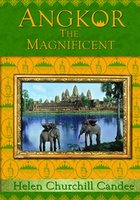 Later this year, or early next, a modern and expanded edition of one of the most popular accounts of the exotic, and then largely unknown, temples of Cambodia in Helen Churchill Candee's Angkor The Magnificent, will be published by DatASIA Inc. It was due out a few months ago but a fire in the home of CEO Kent Davis destroyed some of the graphics and other material, causing a delay in printing. Originally published in 1924, it brought to life the vast jungle edifices of Angkor and their mysteries through the eyes of this intrepid woman explorer.
Later this year, or early next, a modern and expanded edition of one of the most popular accounts of the exotic, and then largely unknown, temples of Cambodia in Helen Churchill Candee's Angkor The Magnificent, will be published by DatASIA Inc. It was due out a few months ago but a fire in the home of CEO Kent Davis destroyed some of the graphics and other material, causing a delay in printing. Originally published in 1924, it brought to life the vast jungle edifices of Angkor and their mysteries through the eyes of this intrepid woman explorer.In addition, Candee was a survivor of history’s most infamous maritime disaster, the sinking of the Titanic, one adventure among many for the Washington, D.C. society leader and interior decorator who turned more and more to the joys of writing and the thrill of travel to the foreign lands that intrigued her. On her journeys of discovery, Helen Candee walked with kings, presidents, the wealthy and powerful – entertaining, educating and influencing them along the way. Yet her outlook was democratic, her approach spiritual, her love for people of all races genuine. A champion of female equality, she was yet quintessentially feminine – as bold as she was beautiful, she charmed while she shocked. Candee’s vision and talent were never melded with greater impact than in the pioneering work she accomplished after traveling the Far East with her keen sense of detail, inquisitive mind, and respect for a culture that enchanted her. The result of her study, Angkor the Magnificent, is more than a tale of early 20th century Asian travel. Candee’s observations are enlightening, elegant and witty as she relates the history and context of Angkor’s ancient monuments. Thanks to her inspired hand, the world has one of the first significant works on Cambodia in the English language.
The book will include Candee’s complete original account of Southeast Asian travel, a biography of the explorer by Randy Bryan Bigham and more than 120 illustrations of Cambodia and the author. Candee’s personal account of the Titanic disaster is also included, as is a bibliography and index.
Here's an excerpt from Randy Bryan Bigham's biography of Candee called Life's Decor:
Travel for Helen Candee in the early 1920s increasingly meant Japan, China and the exotic Far Eastern lands of Indonesia and Cambodia. The latter was a chief draw, and in her sixth book, Angkor the Magnificent , now a classic travelogue, Helen's facility for words found inspiration in the mysterious, half-hidden temples and palaces, hanging gardens, sculpture and stonework of the ancient “Wonder City." In her book, the beauty and symbolism of the architecture of the temple of Angkor Wat came in for rapturous praise: One can never look upon the ensemble of the Wat without a thrill, a pause, a feeling of being caught up to the heavens. Perhaps it is the most impressive sight in the world of edifices.
The fascinating ruins of Angkor and their Eden-like environs had only been known to Westerners for fifty years, and weren't widely explored or photographed before Candee's ambitious study. Her book, published by Stokes in 1924, was the work Helen was most proud of. It also brought her the most acclaim. She was commanded to give a private reading of Angkor the Magnificent to King George and Queen Mary and was afterwards asked to Their Majesties' annual garden party at Holyroodhouse, being one of only a few Americans invited. Helen was even decorated by the King of Cambodia in a native ceremony. Captivated by the region, its riches and its people, Helen was pleased that the success of Angkor the Magnificent allowed her to focus on Asia in a series of articles and short stories for newspaper syndication the following year, as well as a special feature for Art and Archeology Magazine.
Bye to Luang Prabang
Tuesday, August 26, 2008
Wats galore
Pulse on the record
David Hinds: On Tour, On the New Album, on the United Front for Africa - by Jan Salzman 14 July 2008,
Steel Pulse has been one of my favorite bands for about 25 years. In 1985, the popular band from
Jan: Tell us a little about your new DVD, Door of No Return. David: It’s a DVD that’s a collection of inserts of different scenery, but the body of it was filmed some seven or eight years ago, when we made our first exodus to
Jan: You have been known for your socially conscious lyrics and your stand on socially conscious issues. At what age did this start for you, and is there any particular incident that triggered it? David: I would say that my socially conscious or politically conscious age began when I was about fourteen years old. It was all to do with the “Free Angela Davis” campaign that was happening in
Jan: You are also known for such beautiful spiritual songs as “Chant a Psalm a Day.” At what point did you reach this kind of enlightenment? David: “Chant a Psalm” was written about 1980. It was at a time when the band was at rock bottom…in regards to its career. We had teamed up with
Jan: What kind of music do you listen to when you are on your own? David: I listen to all kinds of music. You would be surprised what I listen to.
Jan: What was the last CD you bought? David: The last CD I got…what I literally bought in my hand was a reggae CD. I think it was Stephen Marley’s Mind Control album. I think it is a very vibrant album. It didn’t hit me at first. That was the strange thing about the album, it never grabbed me at all initially. But, after the third, fourth listening…I think it is one of the best albums that’s out there on the market right now. It’s very underestimated because of the nature of the music…which, well you know, when it comes to the acts that are out there…the ones that are making it in the mainstream…your Sean Paul’s and your Shaggy’s…I think Mind Control is a very technical album. I think it is something that is a spin off and [in the] progressive direction, as what Bob Marley would be doing, in so many different ways. I think all the sons, as a matter of fact, are contributing in a very big way towards how the music should be going, as far as I’m concerned.
Jan: What’s in your CD player right now? David: There’s an artist called Umojah that was passed on to me by one of my associates here within the camp, Rootsman Kelly, which is a new act out there trying to penetrate his reggae vibe. I don’t know much about him. This is what I’m trying to say to you. I listen to unknown acts and I listen to people who are up there. Then I go diverse and I start listening to guys like Papoose and 50 Cent. Trust me. You nah mean. I just jump from different artists to different artists.
Jan: What makes you happy? David: I think what really makes me happy, when I look at the nitty-gritty, is meeting people with positive spirits, people who are intelligent, and have good ideas to share. When I look back on it…that’s what really makes me happy.
Jan: What would be a perfect day for you? David: I find is a perfect day is when I manage to get through all the chores that I’ve written down the night before, which includes if I can get a nice song written or half written. I think that becomes a perfect day for me, because that gives me my greatest high of all… when I have a song that I know is really in the pocket. It just gives me a buzz that nothing else does…to be honest with you.
Jan: Is there a new album in the works that we can look forward to? David: There is a new album in the works. as far as being written. The other band members haven’t heard any of the tracks as yet. We’re putting ideas down, we’re putting subject matters together. I don’t like throwing any old song out there. I don’t like throwing any old groove out there. That’s one of the reasons why the band takes such a long time to put music out. ‘Cause once we put it out, then it’s the whole idea of touring for quite a long while. ‘Cause that’s what usually happens. I don’t like putting dumb lyrics together. I like something that is constructive and has meaning to it. It makes me feel good about what I do, and I think it pays off when I see people come back and compliment the bands’ legacy.
Jan: Yes, I think your work is brilliant. David: Thank you very much. We’re absolutely jet-lagged right now. I’m talking to you on auto-pilot.
Jan: Thank you very much for the interview. I bought the DVD and look forward to watching it. David: There’s another DVD that’s coming out shortly. It’s gonna be in two parts basically. It’s a show that we did in
Jan: Oh, that’s great! Do you have any particular message that you’d like to give your fans or your readers? David: Yeah, we are going to be vamping up our website. We’re not happy with the way it is at the moment. Never been actually, but we’ve never had the time to address it, now we’re finding the time. We want to also launch an organization that we are putting together, via the sales of our merchandise…and that’s called UFFA…United Front For Africa. It has to do with raising and distributing the funds in various parts of
Jan: Are there any songs from your vast repertoire that are favorites of yours? David: Wow, there are so many favorite songs of mine. Sometimes I listen back to tracks like “ Nyabinghi Voyage,” “Door of No Return” …there are certain songs I can’t believe I wrote. Something possessed me at the time. I look back on it and I sort of wake up and realize …Hey, where did these lyrics come from? Those are the songs I feel pleased about. “Soldiers” is probably my all time favorite. Obviously there’s “Rally Round”…there’s so many of them. “Drug Squad,” I like that. When it comes to songs, it’s not only the song itself…it’s how it comes into being in the first place. It had to be an excuse of some kind that brought that song into motion. I’m enjoying putting together the new sets of songs right now. Taking my time with it. See what happens. Let’s hope that the grooves are strong enough to stand up to what the songs are gonna contain.
Jan: Thank you so much for this wonderful interview and for taking time on your jet-lagged body to talk to us. David: Thank you, as well, for all of the support you’ve given us over the years and all those wonderful photographs. I hope to be sifting through some of those for the new website. I’m telling you…I’m serious as a heart attack…Boo Boom! Interview copyright of ReggaeReport.com and Jan Salzman.
The right places
Last night I had a call from Rachel, in town for a couple of days before starting her new job in Siem Reap, to meet on the top of one of Phnom Penh's tallest buildings for cocktails. It's just around the corner from me, it's called The Place and is a smart, newly-opened mish-mash of restaurants, bars, a gym and more besides. Not somewhere I'd usually visit but worth it for a view over the rooftops of Phnom Penh at night, looking down towards and past the Independence Monument. My photo doesn't really do the view justice but with a pepsi at $3.50 it won't be the place for me.
Monday, August 25, 2008
Pocket guide review
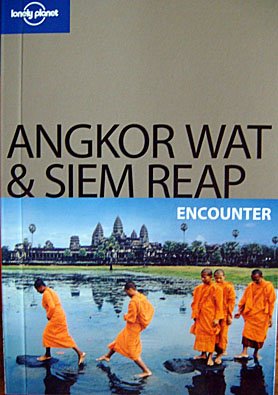 Siem Reap is changing rapidly and to keep abreast of the best the town and the surrounds have to offer, Lonely Planet are publishing a 150-page Encounter pocket guide to Angkor Wat & Siem Reap. Written by resident Nick Ray, co-author of LP's Cambodia, it's essentially a handy-sized book of top tips rather than the in-depth look its parent guidebook takes. It's aimed at the short vacationer, written in a witty style, focusing on shopping, eating, drinking and sightseeing, moreso than accommodation. It still has 33 pages on the temples of Angkor, which is afterall why most people visit Siem Reap - the book title should really read Angkor & Siem Reap - and it also branches out with a few excursions beyond the town. Some will say it's cheap and cheerful, in fact I do, but it fills a niche for visitors who will see only Angkor and Siem Reap on their visit to Cambodia and who don't have time to wade through a mass of detail.
Siem Reap is changing rapidly and to keep abreast of the best the town and the surrounds have to offer, Lonely Planet are publishing a 150-page Encounter pocket guide to Angkor Wat & Siem Reap. Written by resident Nick Ray, co-author of LP's Cambodia, it's essentially a handy-sized book of top tips rather than the in-depth look its parent guidebook takes. It's aimed at the short vacationer, written in a witty style, focusing on shopping, eating, drinking and sightseeing, moreso than accommodation. It still has 33 pages on the temples of Angkor, which is afterall why most people visit Siem Reap - the book title should really read Angkor & Siem Reap - and it also branches out with a few excursions beyond the town. Some will say it's cheap and cheerful, in fact I do, but it fills a niche for visitors who will see only Angkor and Siem Reap on their visit to Cambodia and who don't have time to wade through a mass of detail.It kicks off with a top-six highlights, includes two walking tours as well as interviews with locals such as Nhiem Chun, the famed sweeper of Ta Prohm, Angkor guide Srei Omnoth and scholar Dr Ang Choulean. Here's a sample of Snapshots - Spas & Massages to give you a flavour:
Foot-massage shops are spread out around Psar Chaa and offer a range of remedies for dispirited soles.... Siem Reap is littered with massage shops, but some offer more 'services' than others. Gentlemen should not be surprised to be offered a 'happy ending' in certain establishments, but the amount of make-up caking the face of the masseuse is usually a good indication that traditional massage may not be high on the agenda.
As I said, cheap and cheerful. It costs $12.99, is in full colour and will be published in September.
Smile
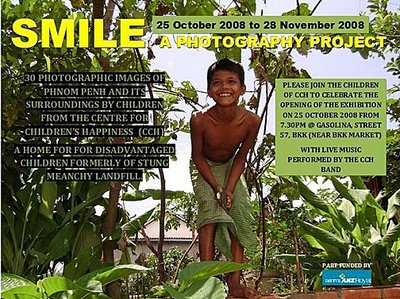 Make a note in your calendars. The Smile exhibition of photographs taken by 5 children who have found their way to the Centre for Children's Happiness from Phnom Penh's Stung Meanchey rubbish dump and been given street-documentary photography instruction, will be on display at Gasolina, Street 57, for a month from 25 October. If you want to see their 'work in progress,' click here, it's pretty darn good.
Make a note in your calendars. The Smile exhibition of photographs taken by 5 children who have found their way to the Centre for Children's Happiness from Phnom Penh's Stung Meanchey rubbish dump and been given street-documentary photography instruction, will be on display at Gasolina, Street 57, for a month from 25 October. If you want to see their 'work in progress,' click here, it's pretty darn good.
Reggae Rockz 2008
Sunday, August 24, 2008
Reflections
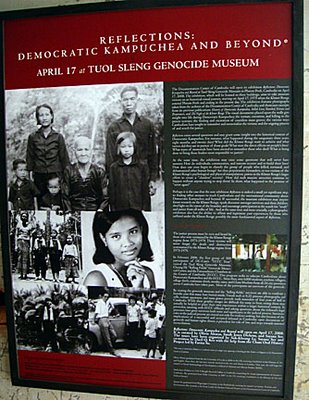 Reflections is an exhibition that began life in April 2008 at Tuol Sleng and will present different aspects of the Khmer Rouge regime in an historical-visual journey from their take over of the country in 1975 through to the present day. The exhibition is a collection of photographs and information provided by DC-Cam that range from the work carried out to locate and document the mass graves left behind by the genocidal Khmer Rouge regime through to daily life in Democratic Kampuchea and onto the ongoing search for justice.
Reflections is an exhibition that began life in April 2008 at Tuol Sleng and will present different aspects of the Khmer Rouge regime in an historical-visual journey from their take over of the country in 1975 through to the present day. The exhibition is a collection of photographs and information provided by DC-Cam that range from the work carried out to locate and document the mass graves left behind by the genocidal Khmer Rouge regime through to daily life in Democratic Kampuchea and onto the ongoing search for justice.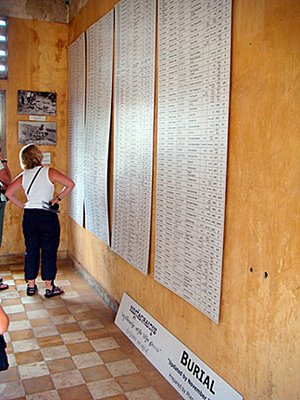 Lists of the 19,733 mass graves uncovered during a ten-year project by DC-Cam to map the grave-sites, KR prisons and genocide memorials
Lists of the 19,733 mass graves uncovered during a ten-year project by DC-Cam to map the grave-sites, KR prisons and genocide memorials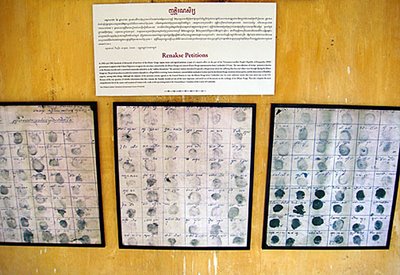 The Renakse Petitions from the early '80s were signed by hundreds of thousands of survivors seeking justice against the Khmer Rouge
The Renakse Petitions from the early '80s were signed by hundreds of thousands of survivors seeking justice against the Khmer RougeFaces
Survival art
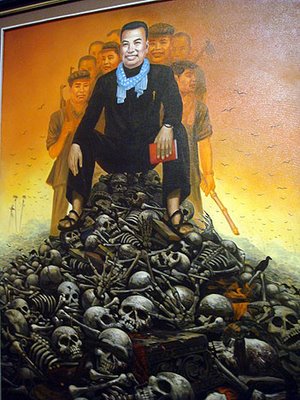 Hen Sophal's The Khmer Rouge Leader painting
Hen Sophal's The Khmer Rouge Leader paintingThese two works represent the divergent perspectives of different generations of Cambodians on Pol Pot and his killing fields, and lie at the heart of "Art of Survival," a group exhibition at the contemporary art space Meta House in Phnom Penh. The exhibit is a "long-overdue dialogue through art" that seeks to address modern memories of Cambodia's painful past, says Meta House director Nico Mesterharm. The two-part exhibition began in January with 21 artists and expanded this month to include a total of 40 artists, who were each given a blank canvas to document their reflections on the Khmer Rouge period. The show was scheduled to coincide with current efforts to bring former Khmer Rouge leaders to justice through a U.N.-assisted genocide tribunal, which is preparing for its first trial—of Kaing Guek Eac, the former commander of the notorious S-21 prison and torture center—next month. The exhibit includes international artists such as Vietnamese-Khmer painter Le Huy Hoang, who painted a portrait of his father, a Cambodian military doctor who died in one of Pol Pot's detention camps, and the American Bradford Edwards, who has regularly traveled to Cambodia over the past 12 years. "We're trying to show the impact of the genocide not just on Cambodia but on the region as well," says Lydia Parusol, art manager of Meta House.
Pol Pot's Khmer Rouge presided over the deaths of almost 2 million Cambodians between 1975 and 1979. But their presence was felt long after they were overthrown 10 years ago. The Southeast Asian nation's culture was nearly wiped out during that time, and though the new government sought to rebuild the arts, it placed more emphasis on traditional dance and theater than on contemporary art. Indeed, most artists have been extremely reluctant to confront the past, notes Hen, admitting that he painted "The Khmer Rouge Leader" in 2000 but was afraid to show the work in public for fear of "retribution." "Everybody knows this happened to Cambodia, so actually, some artists feel they don't need to paint [it]," he says. "But I think about the Khmer Rouge all the time. It's in my head; it's an obsession." The works on display are clearly skewed by age. Older artists who survived the regime, like Hen, Chhim Sothy and Vann Nath, tend to show more graphic depictions of the Khmer Rouge, with skulls and death crowding canvases. Vann's untitled oil painting, which depicts a group of blindfolded prisoners with ropes around their necks being led inside the S-21 prison, is made more poignant by the knowledge that the artist is only one of a handful of remaining survivors from the torture center, where nearly 20,000 people are believed to have been tortured and killed. Since the end of the Khmer regime, Vann is probably the only painter to have continuously depicted in great detail the atrocities of the regime. Some of his works are on permanent display at the Phnom Penh prison, which has been turned into the Tuol Sleng Genocide Museum.
The younger generation favors more abstract works. Tith Veasna's "Blind Pins" is a mixed-media installation using pins and black fabric—a Cambodian symbol of mourning for a relative who dies. Vandy Rattana's "Going Fanatic" is a photograph of squares of light around a hammer and sickle. "It's not that the younger generation is forgetting," Vandy says. "It's just that we don't know much about it. After 12 years of school, I'd never heard about the Khmer Rouge." Perhaps the most powerful painting is by the rising contemporary-art star Leang Seckon, whose "My Shadow" depicts a half-naked man whose mirrored reflection shows a skeleton. The man, which the artist imagines as part of Pol Pot's regime, is throwing a punch at his shadow as if wrestling with his own demons. "This man knows his guilt," says Leang. "He can hide it outside, but the mirror shows his true self." In the same way, "Art of Survival" is an unflinching reflection of Cambodia's attempts to reconcile the past.
Saturday, August 23, 2008
Football fever
Cambodia, who were using the games to tune-up for the AFF Suzuki Cup 2008 qualifiers to be held in Phnom Penh, are now out of the tournament that also included Libya, Brunei and an Indonesia B team. The Asean Championship qualifying rounds will be held in Cambodia from 17-25 October and five nations will go head-to-head for the two available slots in the final rounds later in the year. Joining Cambodia in the event are Philippines, Laos, Timor Leste and Brunei.
At a slightly lower standard, but not much, there's an inter-squad game between two Bayon Wanderers sides at the Old Stadium tomorrow at 2pm. With well over 40 players itching for a game, the team that went to Saigon last weekend will take on the team that stayed behind and beat the Ministry of Labour 5-3. It's certainly a thriving club and the competition for places is getting hotter each week. I need games to get my own match fitness back after my years in the football wilderness, but I'm likely to miss tomorrow after picking up a niggling groin injury at training on Thursday. I'm getting increasingly frustrated at picking up a series of knocks and strains but I must be realistic that after so long without playing, my body just isn't the athletic machine it used to be...yeah right!
The playboy King
The search is on
Teams to Search for Tuol Sleng survivors - by Mean Veasna (VOA)
According the center, the prisoners were arrested from Kampong Thom, Kandal, Kampong Cham, Kampong Speu, and other provinces, and then released, between 1975 to 1977. Some of them were accused of links to the CIA, while others stood accused of loving a forbidden partner. Other charges included attempts to steal the motorcycles of Khmer Rouge cadre and other infractions against the secretive regime. "In the closing order, co-investigating judges did not mention this, and it seems that in the closing order all people who were detained have been killed," Youk Chhang said. "Indeed, some of them were released." The center will begin sending teams into the provinces next week in search of the survivors, in hopes of interviewing them and learning why they were released.
Co-investigating judge You Bunleng said Friday the center had a right to investigate. "This is their affair. I cannot give further comment before the plenary trial," he said, adding that investigating judges do not give full details of the case in their closing orders. Some documents of the center have already been used by civil party and defense lawyers. "We think that all the work of NGOs that provides interest in the [tribunal] will provide interest to our citizens," tribunal spokesman Reach Sambath said. Only 10 Tuol Sleng survivors have so far been discovered, and most of those have already died.
A slice of luxury
Friday, August 22, 2008
Doing his thing
With help, Montrose man dousing Cambodian fires - by Reilly Capps (Telluride Daily Planet, Colorado, USA)
Cambodia doesn’t have much, and what little they do have keeps burning down, because that beautiful and battered country doesn’t have enough fire fighting equipment or fire stations to keep up. The whole country, in fact, has far fewer fire stations than the Western Slope. In the capital, Phnom Penh, for example, there is only one fire station and just nine trucks to protect two million people. It’s not uncommon for dozens, even hundreds of rickety buildings to burn down before a truck can get to the blaze. That dire situation struck Montrose resident and former volunteer fireman Doug Mendel as nearly criminal, and he’s working to change it. He’s coordinated the donation of tons of gear and two fire trucks to departments throughout the country. He long ago fell in love with this southeast Asian nation famous for producing Angkor Wat and children of Angelina Jolie. While on vacation in Cambodia in 2001, Mendel noticed that the fire station in Sihanoukville was unbelievably run-down and decrepit. “It was very basic and almost barren,” he said. When he came back, he convinced the Breckenridge fire department to donate an old fire truck, and he raised the $18,000 necessary to ship it over to Sihanoukville. In 2005, three members of the Breck fire department traveled to Cambodia to teach the locals how to use it. “It was actually really awesome,” said Kim Scott, a captain in the Breck department. She couldn’t make the trip, but heard that the Cambodians “were so appreciative it makes you want to cry.”
A lot of things about Cambodia make you want to cry, since the story of Cambodia since 1970 is pure tragedy: illegal American bombing and intense civil war, and then the horror of Pol Pot, who promoted communism by snuffing out 1.7 million of his own countrymen and left huge parts of the country booby-trapped with land mines. Today, the president is bringing real reform and the economy is improving, but one-armed kids still beg on street corners and sit below your table, big eyes desperate for a scrap of leftover noodles. To travel there is to have your heart expanded, lifted...and broken into a million little pieces. And Mendel’s big heart isn’t reserved just for underfunded fire stations. He’s also donated cameras to national park rangers so that they can document poaching and illegal logging activities, and brought over medical and dental supplies for street children. And, he gives them stuffed animals. “It makes their day,” Mendel said. "They're such genuinely happy people. Especially the children. They have so little. It just light 'em up." Last year, Mendel had a fire truck built for a remote province, Ratanakiri, and his project this year is to build a whole new fire station in that province’s capital, Ban Lung. Building a whole fire station, from foundation to roof, costs just $35,000 — less than a new Toyota FourRunner. To fund his travel, Mendel saves what he makes at the Montrose Home Depot. And when he returns from Cambodia, he brings back silk purses, silk scarves, jewelry boxes and table cloths, and sells them around the Western Slope. Yesterday, he was peddling the Cambodian stuff at the Grand Junction Flea Market.
Mendel’s next term goal is to raise a couple hundred g’s to build two fire stations in Phnom Penh, since it breaks his heart to read about the fires that ravage the capital. There was a fire not long ago, he said, that took out 500 slum houses and just about every single possession a lot of families had. "It would bring tears to my eyes to see one or two more fire stations in Phnom Penh," Mendel said. Scott, the Breck fire captain, said her department’s relationship with Cambodia has expanded their world, and said Mendel made it possible. “He’s just an amazing man,” she said. “It’s a really nice feeling when you know you’re helping people.” Mendel returns to Cambodia in October, his 12th trip in six years, brining over 800 pounds of gear for the Phnom Penh station. His nonprofit, the Douglas Mendel Cambodian Relief Fund, is looking for donations. If you’d like to help, surf to dougmendel.com, where you can watch videos, see pictures and donate via PayPal. Or call him at 970-240-6120.
Thursday, August 21, 2008
Don't miss Kuang Si
Tempers cool off
In other news, the 5-times-a-week Mekong Times has halted production after about six months of struggling to get itself a foothold in the media dog-fight in Cambodia, whilst the brand new daily Phnom Penh Post failed to arrive at the newstands yesterday after alleged problems at the printers. Not something a new paper can afford to happen too often! Oh, and as I type this, it's raining again outside...
Wednesday, August 20, 2008
Iconic sweeper
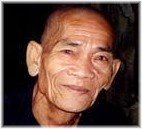 I wrote the following blog post back in September 2006. I repeat it now as the spotlight has again been turned onto the sweeper of Ta Prohm in the latest edition of the Lonely Planet Guide to Cambodia. First of all, here's my posting from a couple of years ago:
I wrote the following blog post back in September 2006. I repeat it now as the spotlight has again been turned onto the sweeper of Ta Prohm in the latest edition of the Lonely Planet Guide to Cambodia. First of all, here's my posting from a couple of years ago:Do you recognise this living icon of Angkor? His name is Choun Nhiem, he's eighty-four years old and features in the photos of thousands of tourists that have visited the Angkorean temple of Ta Prohm. Many will recognise his face, his hunched stature, and like the white-robed nuns who tend the statues at Bayon and the sweet little girls who sell trinkets and souvenirs amongst the temples, he's become one of Angkor's living icons. A widow and nearly blind, Choun Nhiem spends his days sweeping leaves from the courtyards and corridors of Ta Prohm and is recognised by many from his appearance on the cover of the Lonely Planet guidebook. For the past fifteen years he's been as much a part of Ta Prohm as the roots and trees that clasp the temple walls in their vice-like grip. Choun Nhiem was a labourer at the Angkor site before the Khmer Rouge years, during which he lost two sons. He lives in a small village near the temple, has three surviving children and returns to Ta Prohm every day to carry out his duties, and to sell the occasional trinket to tourists - he offered me a small cowbell when I first met him in 1997. I've seen Choun Nhiem every time I've returned to the temple on my visits to Angkor, and I hope to see him for many years to come, Ta Prohm wouldn't be the same without him.
The latest LP Cambodia, published this month, focuses on him in their Angkor section.
Nhiem Chun by Nick Ray
Nhiem Chun is as much an icon of
In 2006 the BBC came to
Oh My Buddha!
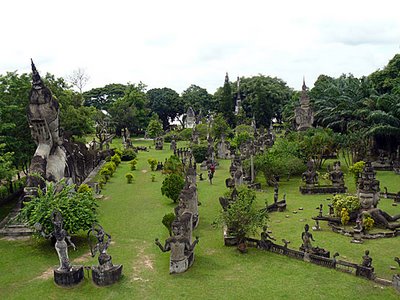 A panoramic view of Buddha park
A panoramic view of Buddha parkTuesday, August 19, 2008
A spot of peace and quiet
History and happenstance
To thank the museum, Mr Dean, now 80, offered a gift from his own collection of ancient Khmer artefacts. Last month, the gift arrived, the sculpted head of a woman found at the Bakong temple site in 1939. "I asked him for a Khmer head because we only had headless statues but I didn't think for a moment about a possible match," said Pierre Baptiste, the museum's curator for south-east Asian art. "I brought the head into our [Cambodian] hall looking for a place that it could be exhibited," said Baptiste. "I had a sudden notion the two pieces resembled each other but then thought, 'no, things never happen that way'. I put the head on the statue's shoulders. It shifted a few millimetres. I heard the little click that you get when two stones fit together and the head fell perfectly into place. It was as if it had put itself together. I still get goose-bumps thinking about it." The reformed statue, which is 4ft 10in high, was beheaded in the temple when it was destroyed in the 15th century.
Note: The wife of Shiva is Parvati, also known as Uma. However, the Guimet Museum has always shied away from confirming the statue as a wife of Shiva, instead terming the work of art as a female divinity from the Preah Ko period, c 881.
Monday, August 18, 2008
Cambodia books aplenty
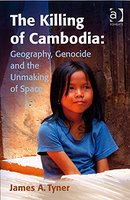 A new book from Ashgate Publishing that is just about to go public is James A Tyner's attempt to convince us that the Khmer Rouge genocide was also terracide - the erasure of space. His 228 page book argues that their erasing and reshaping of space gives a uniquely geographic perspective on the complex topic of genocide. If I could understand it, I might agree! His book is called The Killing of Cambodia: Geography, Genocide and the Unmaking of Space. Tyner is a professor of geography at the Kent State University in the US.
A new book from Ashgate Publishing that is just about to go public is James A Tyner's attempt to convince us that the Khmer Rouge genocide was also terracide - the erasure of space. His 228 page book argues that their erasing and reshaping of space gives a uniquely geographic perspective on the complex topic of genocide. If I could understand it, I might agree! His book is called The Killing of Cambodia: Geography, Genocide and the Unmaking of Space. Tyner is a professor of geography at the Kent State University in the US.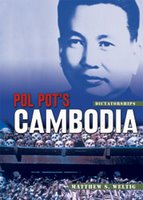 Staying on an educational theme, a book for 14-18 year olds is Pol Pot's Cambodia by Matthew Scott Weltig, in the Dictatorships series by Twenty-First Century Books. Out in October, its 160 pages brings to the classroom the real story behind Pol Pot and his genocidal regime. On the same subject Sean Bergin's The Khmer Rouge & The Cambodian Genocide is aimed at the same age grouping. On a lighter note, Thomas Cook Publishing will join the guidebook party with their Travellers Cambodia edition, by David Henley and Andrew Forbes, in October. 176 pages with 140 photos from the same team that brought us the Insight Compact Guide to Cambodia in 2000.
Staying on an educational theme, a book for 14-18 year olds is Pol Pot's Cambodia by Matthew Scott Weltig, in the Dictatorships series by Twenty-First Century Books. Out in October, its 160 pages brings to the classroom the real story behind Pol Pot and his genocidal regime. On the same subject Sean Bergin's The Khmer Rouge & The Cambodian Genocide is aimed at the same age grouping. On a lighter note, Thomas Cook Publishing will join the guidebook party with their Travellers Cambodia edition, by David Henley and Andrew Forbes, in October. 176 pages with 140 photos from the same team that brought us the Insight Compact Guide to Cambodia in 2000.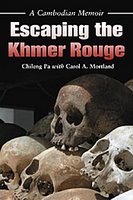 I missed this book on its publication earlier this year, so its high time I highlighted Escaping the Khmer Rouge: A Cambodian Memoir by Chileng Pa with Carol A Mortland. A former policeman Chileng recalls his life as he hid his identity from the Khmer Rouge until his wife and child were murdered and he escaped to Vietnam. He returned as part of the Vietnamese invasion force before resettling in America with his new family in 1981. His memoir is posthumous as Chileng died in 2005. I don't hear about every new book that gets published with Cambodia as its main focus, so if you do know of any that I haven't mentioned, please let me know.
I missed this book on its publication earlier this year, so its high time I highlighted Escaping the Khmer Rouge: A Cambodian Memoir by Chileng Pa with Carol A Mortland. A former policeman Chileng recalls his life as he hid his identity from the Khmer Rouge until his wife and child were murdered and he escaped to Vietnam. He returned as part of the Vietnamese invasion force before resettling in America with his new family in 1981. His memoir is posthumous as Chileng died in 2005. I don't hear about every new book that gets published with Cambodia as its main focus, so if you do know of any that I haven't mentioned, please let me know.
Art of Survival
Perhaps the most well-known artist in Cambodia at this time is Vann Nath. His paintings and sketches of his experiences during a year of captivity at Tuol Sleng have for many years informed visitors of the cruel activities that took place at the S-21 headquarters in Phnom Penh. He recently exhibited a series of newly-created paintings and sketches at the Bophana Center in the city before taking his exhibits to Bangkok, under the title Endurance. Now that collection is being issued as a limited edition of 79 numbered and signed copies, 79 being symbolic of the year Vann Nath escaped imprisonment and the year that Phnom Penh was liberated from the Khmer Rouge. The full collection includes fine art prints of 12 paintings and 14 sketches. They are available for purchase at his Phnom Penh gallery on Street 169, Art World on Street 240 and the Thavibu gallery in Bangkok.
Sunday, August 17, 2008
Henri Mouhot
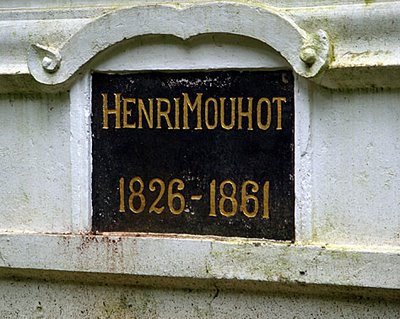
Ignoring the misconception that French naturalist and explorer Henri Mouhot discovered Angkor in 1860, he was still instrumental in bringing it to the attention of the West and it was his posthumously published 'Travels in Siam, Cambodia and Laos' that evoked lost civilizations in the jungle. From his base in Bangkok he made four journeys into the three countries covered in his journals and overcame extreme hardship before succumbing to malaria in the jungle near Luang Prabang in Laos. Two of his servants buried him by the banks of the Nam Khan river and his favourite servant, Phrai, transported all of Mouhot's journals and specimens to Bangkok, from where they were shipped to Europe. He died in November 1861 and his journals were published two years later. His tomb was lost for many years and only rediscovered in 1990. Today its a popular stop on the tourist route and lies just a few kilometres from Luang Prabang.
Rough Guide to Cambodia - review
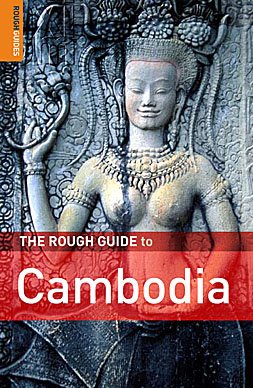 The folks at Rough Guide have sent me their brand new 3rd edition of The Rough Guide to Cambodia to review and as a standalone guidebook it's certainly adequate if unspectacular. Like all new guidebooks it inevitably suffers from the gap between research and publication with amendments in its eating and sleeping sections even before it hits the bookshelves and this edition is no exception. Address changes for Cafe 151 and Garden Centre Cafe in Phnom Penh are obvious ones but the inclusion of the Sambor Prey Kuh hotel in Kompong Thom is shoddy - it closed its doors at least two years ago. They limit their accommodation listings - I let out a big groan of disappointment when I realised they'd completely overlooked my favourite guesthouse in Siem Reap, Shadow of Angkor - and they haven't exactly gone out on a limb with their author picks of hotels such as Raffles Le Royal, Grand Hotel d'Angkor, Independence, Knai Bang Chatt and La Villa. I did like their in-depth look at the National Museum and their books section, and thirty pages on the temples of Angkor is welcome, but some of their page layout is messy, their 21 things not to miss is confusing and their choice of black & white photos left a lot to be desired. I cringed at some of the spelling - Skone (Skun), Koh Dait (Koh Dach) and Wat Jum Pos Ka-aik (Wat Champuh Ka'Ek) - come to mind, and felt they missed lots of opportunities to expand their coverage of key sights. For example, Koh Ker was paltry, the Cardamom Mountains virtually ignored, the floating villages of Kompong Phluk and Kompong Khleang do not appear to exist, no mention too for the temple ruins near Kompong Chhnang and Prey Veng, a province no less, merited all of one line.
The folks at Rough Guide have sent me their brand new 3rd edition of The Rough Guide to Cambodia to review and as a standalone guidebook it's certainly adequate if unspectacular. Like all new guidebooks it inevitably suffers from the gap between research and publication with amendments in its eating and sleeping sections even before it hits the bookshelves and this edition is no exception. Address changes for Cafe 151 and Garden Centre Cafe in Phnom Penh are obvious ones but the inclusion of the Sambor Prey Kuh hotel in Kompong Thom is shoddy - it closed its doors at least two years ago. They limit their accommodation listings - I let out a big groan of disappointment when I realised they'd completely overlooked my favourite guesthouse in Siem Reap, Shadow of Angkor - and they haven't exactly gone out on a limb with their author picks of hotels such as Raffles Le Royal, Grand Hotel d'Angkor, Independence, Knai Bang Chatt and La Villa. I did like their in-depth look at the National Museum and their books section, and thirty pages on the temples of Angkor is welcome, but some of their page layout is messy, their 21 things not to miss is confusing and their choice of black & white photos left a lot to be desired. I cringed at some of the spelling - Skone (Skun), Koh Dait (Koh Dach) and Wat Jum Pos Ka-aik (Wat Champuh Ka'Ek) - come to mind, and felt they missed lots of opportunities to expand their coverage of key sights. For example, Koh Ker was paltry, the Cardamom Mountains virtually ignored, the floating villages of Kompong Phluk and Kompong Khleang do not appear to exist, no mention too for the temple ruins near Kompong Chhnang and Prey Veng, a province no less, merited all of one line.Inevitably, guidebooks draw comparisons with their rivals in the marketplace and Rough Guides' main rival is the Lonely Planet. Both have published their latest editions this month so the comparison is timely and in my opinion, Lonely Planet wins hands down. Rough Guide is ahead on photos, 73 against a poor 23, LP leads on maps, and map quality, with 46 versus 33, while both books are 368 pages in length. At $29.99, Rough Guide is $8 more expensive and in a head-to-head battle, Rough Guide comes off second best and with a bloody nose.
Saturday, August 16, 2008
Waterfall fun
Love story
Friday, August 15, 2008
Wet stuff
There's been major progress at the Khmer Rouge Tribunal and fresh details have emerged with the indictment of Kaing Guek Eav, aka Duch, with Crimes Against Humanity and Grave Breaches of the Geneva Convention. Effectively it opens the door to the start of the trial proper for Duch, who was the head of the Khmer Rouge's S-21 interrogation center at Tuol Sleng. The indictment order is 45 pages long and contains details that I haven't previously been aware of. Read it for yourself here.
Flynn
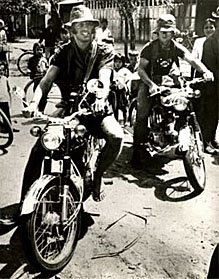 The tragic story of Sean Flynn, the son of Hollywood icon Errol Flynn, who rode off on his motorbike with photojournalist colleague Dana Stone into a battlezone during the 1970 Cambodian civil war, never to be seen again, will be told in the new big-screen biopic, Flynn. Himself an actor, Flynn's disappearance has been the subject of much conjecture suggesting that either the Khmer Rouge or the Viet Cong were his captors and eventual killers, though never proved, giving the story an air of mystery and intrigue. Prolific tv writer Ralph Hemecker will direct and is writing the screenplay with Perry Deane Young, who wrote the 1975 book, Two of the Missing, on which the movie will be based. Flynn was declared dead in 1984 as one of 22 international journalists missing in SEAsia. A few years later a photojournalist colleague, Tim Page's investigations revealed eye witness reports about Flynn's whereabouts and eventual death but no definitive proof has been established. Perhaps the film will reveal all.
The tragic story of Sean Flynn, the son of Hollywood icon Errol Flynn, who rode off on his motorbike with photojournalist colleague Dana Stone into a battlezone during the 1970 Cambodian civil war, never to be seen again, will be told in the new big-screen biopic, Flynn. Himself an actor, Flynn's disappearance has been the subject of much conjecture suggesting that either the Khmer Rouge or the Viet Cong were his captors and eventual killers, though never proved, giving the story an air of mystery and intrigue. Prolific tv writer Ralph Hemecker will direct and is writing the screenplay with Perry Deane Young, who wrote the 1975 book, Two of the Missing, on which the movie will be based. Flynn was declared dead in 1984 as one of 22 international journalists missing in SEAsia. A few years later a photojournalist colleague, Tim Page's investigations revealed eye witness reports about Flynn's whereabouts and eventual death but no definitive proof has been established. Perhaps the film will reveal all.
Roy Hill - My Life In Showbiz - final part
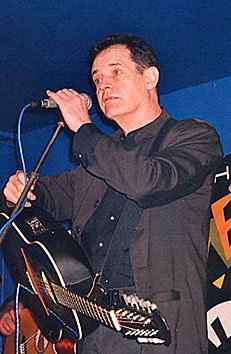 The final instalment of 'My Life In Showbiz' by Roy Hill brings us right up to date. Roy is currently rehearsing like a madman for some solo dates in the next couple of months and the usual Cry No More reunion gig around Christmas. He's also been busy putting out a series of CD's of his own work and that of Cry No More. You can find out all the details at his Myspace website.
The final instalment of 'My Life In Showbiz' by Roy Hill brings us right up to date. Roy is currently rehearsing like a madman for some solo dates in the next couple of months and the usual Cry No More reunion gig around Christmas. He's also been busy putting out a series of CD's of his own work and that of Cry No More. You can find out all the details at his Myspace website.In 1999 I sold steam irons, handed out leaflets and got a job as a courier driver.
And so my life is over now, I have nothing to look forward to except death and hell. In 'The Waltons' and 'Little House On The Prairie', people die nice deaths, surrounded by their freinds but I will probably fall down a manhole and break my neck before drowning in sewage. However, I wonder if hell can really be that bad? It can't be any worse than standing outside this bloody warehouse waiting for Terry Watkins to arrive.
- DEATH AND HELL
In 2000 I drove a van, wrote stories, script ideas, sketches, poems, anything but songs.
In 2001 I drove another van, sold massage machines and wrote a comedy script, Car 13 Where Are you?
RUBY: Still no news from Car 13?
VINCENT: Nothing.
RUBY: He’ll show up.
VINCENT: I hope so. How are things with you?
RUBY: Well, I swear my clients are getting weirder.
VINCENT: Is that possible?
RUBY: You have no idea. This morning I had a gentleman who dressed up as Rupert Bear and tried to balance a beach ball on his head. Every time the ball dropped I had to whack him between the legs with a golf club. A nine iron.
VINCENT: Good grief.
RUBY: And tomorrow I have a gentleman who likes to cower behind the refrigerator while I skin a rabbit. I have to shout at him.
VINCENT: What do you shout?
RUBY: You naughty boy, you scamp, that sort of thing.
- CAR 13 WHERE ARE YOU?
In 2002 I co-wrote and recorded an album with my son Jamie. He hears different notes to me and I learned a lot. Most of all I learned to loosen up my approach to songwriting and don’t work with your son. Only joking Jamie.
In 2003 I sold more massage machines and wrote a comedy script, Welcome To Kent.
In 2004 I sold more massage machines and wrote another comedy script, Hubert.
SOUND FX: Seagulls, distant waves.
GEORGE: Oh I love the seaside. I love the sea. It's so wet and salty. Hubert loved the sea you know. I remember once in
WHITWORTH: It's a seagull your reverence.
GEORGE: Is it really? He's a cheeky fellow, look, he's blowing me a kiss. Too whit too whoo, too whit too whoo, I think he knows what I'm saying.
WHITWORTH: Shall we walk a little further?
GEORGE: Hubert loved birds ...
WHITWORTH: Did he?
GEORGE: ... eagles, wrens, peewits, even the humble sparrow, he shot them all. - HUBERT
In 2005 I wrote and recorded an album of new songs which stepped outside my normal style, a brave decision considering how successful I’d been wth the old one. My lawyer and good friend David Gentle felt I might have found my oeuvre (he’s very cosmopolitan), my brother Deryk said they sounded like a suicide note.
In 2006 my doctor told me I was clinically depressed. I asked her how she'd reached this apparently random diagnosis. She said, 'You've been crying for the last fifteen minutes', a regular Sherlock Holmes. She said I needed anti-depressants and counselling. I said I didn’t believe in counselling. She said I couldn’t have the anti-depressants then. I had the counselling. Things got much worse then much better. I got a job putting up exhibition stands. There's nothing quite like being constantly called a useless wanker by a gang of tattooed ruffians for lifting the spirits. END OF PART SIX.
In 2007, impressed with my ability to carry four bacon rolls with brown sauce, two hot dogs and six teas, in one go, without dropping anything, the ruffians decided I wasn't entirely useless and I became just 'wanker'. Bliss. Their plug ugly faces and endless moaning will live in my heart forever. Feeling more like my old self than my old self ever did I started compiling CDs from the stuff I’d been writing and recording since the long gone yesteryear of 1974. One crisp October morning I started singing in the bath. I was back.
So here we are in 2008 and whaddayaknow ... CD's On Sale: Four ready so far, ten to come, more if I include the real rubbish. I'm working on a website to make purchasing as simple as pie, in the meantime you can order direct from me. More info? Coming right up.
HELLO SAILOR
12 songs recorded 1976-77, a mixture of acoustic demos and tracks recorded with The Strolling Players.
'Although sometimes primitive in execution these recordings are charged with the writer-performer’s manifest eccentricities, by turns playful, waspish and melancholy.' Pat from next door.
FUN WITH DAVE
12 tracks recorded 1983-84 with producer David Richards. Most are demos, some had loftier ambitions. David Richards went on to work with lesser acts such as Queen, Bowie and Michael Jackson. I went on to sell massage machines.
'I am completely satisfied with my massager, it has helped my shoulders no end’ Mrs Pike,
LIVE AT THE MULBERRY TREE
Cry No More's debut outing originally released on cassette in 1986, otherwise exactly what the title suggests, with knobs on.
'My all-time favourite album.' Brian Rizla, The Brian Rizla Experience.
CRY NO MORE 'CRY NO MORE'
From the pubs of Twickenham to ... American producers, American Musicians, released in 1988 on vinyl and cassette. Chapter 15 of a study in career pinball.
'What were they thinking?' Keith from Homebase.
Link: MyspaceRoy Hill - My Life In Showbiz - part two
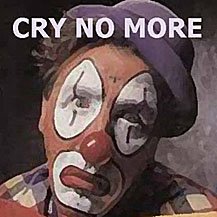 Here's the second instalment of Roy Hill's 'My Life In Showbiz' memoir that appears on his Myspace website. It is simply too good not to bring to the attention of as many people as possible. The man is a genius.
Here's the second instalment of Roy Hill's 'My Life In Showbiz' memoir that appears on his Myspace website. It is simply too good not to bring to the attention of as many people as possible. The man is a genius.In 1982 I recorded an album of songs with airline pilot and sound engineer Nigel Stokes, in his basement studio, with a host of guest musicians. It was a happy and heartening experience. I hawked the tapes around and acquired a manager, Jim Beach, renowned for his success with Queen. Fame and indecent fortune beckoned. This time there would be no mistakes.
In 1983 I signed to Warner Bros Music who would ensure my songs were recorded by the worlds’ major artists. Jim Beach would get me a new record deal in no time. Happy days were here again. I began working with producer David Richards at Queen’s Mountain Studios in
In 1984 I recorded songs in
In 1985 I played some shows with Chas Cronk at The Mulberry Tree, a pub in Twickenham. The shows turned into a weekly residency, and we turned into Cry No More. Sunday night took on a life of its own, part music, part bearpit, a drop-in centre for moral delinquents, a cabaret for the disposessed. Moi? We were joined occasionally by moustachioed keyboard wizard Nick Magnus, against his better judgement. Everyone talked a lot and had nosebleed. It was fun. We released a self-financed single Cry No More and the keenly titled Live At The Mulberry Tree on cassette. Paul Farrah, the owner of a successful sound equipment hire company, provided us with a PA, sound engineers and recording gear free of charge.
In 1986 we played Richmond Theatre thanks to Paul Farrah and an expanding Mulberry Tree Choir. Chas and I began a regular writing partnership and acquired a manager, Jim Beach, renowned for his success with Queen. We signed to EMI Records and EMI Music. Bingo! EMI Records would make us stars, EMI Music would ensure our songs were recorded by the worlds’ major artists. Fame and an unspeakable fortune beckoned. This time there would be no mistakes. We released Dancing In The Danger Zone, a self-produced single which disappeared without trace, followed by Real Love which was even less successful in spite of having five different producers. I won’t trouble you with their names. Smile, an edited version of Live At The Mulberry Tree, was released by Coldharbour Records.
In 1987 we supported Suzanne Vega on a UK tour before recording the provocatively titled Cry No More, produced by Richard Gottehrer, Jeffrey Lesser and David Richards. Planned in New York, recorded in Switzerland with American session men and Nick Magnus, against his better judgement, mixed at a studio belonging to Tears for Fears, it was an expensive, overblown affair. Richard and I were not a match made in heaven. Not to worry, it was singles time. Recipe For Romance bombed in spite of a Nick Davies remix, Tears On The Ballroom Floor, co-written with Anthony Phillips and released with a promotional video, went the same way. We provided songs for a low budget horror film, Bloody New Year and our cameo appearance as The Flying Cadillacs won us both Oscars. It didn't really, I made that bit up. I'm not making this up though, Bucks Fizz recorded Tears On The Ballroom Floor and we ended the year touring with Aswad. Yes, Aswad.
In 1988 we wrote more songs, played at The Mulberry Tree, played in lots of other pubs, toured with John Martyn and produced a 17 minute documentary video, Crying Out Loud, without EMI noticing.
In 1989 we recorded Love And Power with curly haired ex-Strawbs keyboard wizard Andy Richards. It still didn't sound like us and we co-produced it. EMI released Peace In Our Time, another flop, before dropping us, but the album was released in
A single, Oh
In 1990 we did a second tour of
MICK: Come on ref, watch him.
JOHN: Now use it.
MICK: Go on, shoot!
JOHN: Useless Evans, you're useless.
MICK: How's your missus?
JOHN: She's only crashed the car hasn't she? Swerved to avoid some
kid running in the road and bosh, straight into a skip, both legs broken, four broken ribs, broken shoulder, sixty stitches, no claims right up the chute, muggins 'ere on the bus. Come on Evans pass it.
MICK: When was this?
JOHN: About quarter to one, I nearly didn't make it.
In 1991 we were asked to perform Georges Bar on an ITV consumer show, Beat The Cheat. I ended up becoming a presenter, something I wouldn’t care to repeat. It never got past the pilot edition, a blessing. Noel Gay Television expressed an interest in Radio Nowhere, I wrote a second instalment, it came to nothing.
Beat The Cheat ... 'When Lloyd Grossman is the only person making any sense you know you have encountered crap of the highest order.' Time Out.
In 1992 we played a week long residency in the Hyatt Hotel, Montreux, which is as much fun as you can have without actually enjoying yourself. The Social Club audience began to drift away. Jim Beach quit. END OF PART THREE.
The Defence Department has confirmed that scientist, Andre Delon, was working on a top secret project at the time of his death, fuelling rumours that he may have been killed by a Russian spy.
In 1993 I was commissioned by Paul Farrah, now a theatre producer, to write a stage musical version of The Fly, a gift from heaven. I wrote day and night for a spectacularly tiny fee. My profits would come when the play was a hit.
SHERAZ: Did you kill your husband Mrs Delon? JENNIFER: Yes. SHERAZ: How did you kill him? JENNIFER: In a hydraulic press. SHERAZ : You squashed him to death? JENNIFER: I pushed a button. SHERAZ: Why did you push it twice? JENNIFER: I missed the first time. - THE FLY
In 1994 a director, Steven Dexter, was appointed and a dizzying round of re-writes, rehearsals and backstabbing began. The music business might be a filthy swamp of deceit, avarice and corruption but it’s a tea party compared with musical theatre. Paul announced that, as producer, he now owned the entire rights to my script and songs. Someone called Steven Clark changed a few words here and there and was credited as co-writer. The Fly played two preview shows at the Garrick Theatre in
Cry No More bid adieu to The Turks Head, the first of many farewell appearances. END OF PART FOUR.
In 1995 I got a driving job.
In 1996 I started writing again and decided to try and record some songs myself. I contacted Jim Beach, renowned for his success with Queen. Jim was starting his own record label and willing to invest a modest sum in the project. Bingo! This time absolutely nothing could go wrong.
In 1997 I acquired an 8-track recorder and set about becoming my own producer, engineer and three-fingered keyboard player with all the technical acumen of a dead otter. Not a pretty sight. Helpfully, my keyboard could play She’ll Be Coming Round The Mountain on its own.
In 1998 I finished the tracks. Jim suggested we replace my toytown instrument noises with the real thing using classical musicians from the Lausanne Conservatoire at Mountain Studios. My primitive playing with a bleak orchestral veneer. I agreed. David Richards was called in. Our relationship was less harmonious than of old. I returned to
Roy Hill - My Life In Showbiz - part one
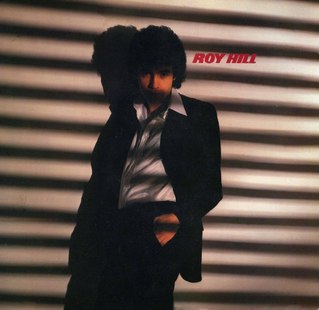 Roy Hill is quite simply one of the most talented people I've ever met. I thought he was brilliant when I first saw him in 1978 and he's even better today. He's a genius. His comedic bent is as good as his musical ability. And he's a genuinely nice guy. Here's a glimpse into the mind of the man in this serialized 'My Life In Showbiz' memoir he's penned on his Myspace website:
Roy Hill is quite simply one of the most talented people I've ever met. I thought he was brilliant when I first saw him in 1978 and he's even better today. He's a genius. His comedic bent is as good as his musical ability. And he's a genuinely nice guy. Here's a glimpse into the mind of the man in this serialized 'My Life In Showbiz' memoir he's penned on his Myspace website:In 1974 I wrote three songs.
In 1975 I won a heat of the Melody Maker Rock Contest and figured I must be the new Dylan. Yaaaaahooo! Fame and an indecent fortune beckoned. I wrote more songs, played floor spots in a
'The soloists’ section was won convincingly by Roy Hill whose original compositions, 'Join Me' a bitterly ironic song about a potential suicide, 'Living On Memory Lane’ a savage and hilarious look at a family living in a nostalgic wonderland and the poignant ‘Still Waiting’ revealed him to be a writer of substantial talent.' Allan Jones: Melody Maker.
In 1976 I signed with Arista Records and Island Music. Bingo! Arista would make me a star,
'There were demo tapes by Roy Hill that sounded good enough to release; tough, spare, inexorable urban laments full of sexual and social grief.' Donald Clarke: The Rise and Fall of Popular Music.
In 1977 I recorded my first album with former Elton John producer, Gus Dudgeon and a host of top session men. It was as an expensive and overblown affair but it would have been churlish to complain when I was the only one there I hadn’t heard of. Any hope of working with some Strolling Players was dashed by Gus's ability to locate and destroy unknown musicians from a distance of several miles. Saxophonist, Bimbo Acock, survived by disguising himself as Lulu. An appearance on So It Goes provided brief respite from anecdote hell. It's impossible to do justice to the very colourful time I spent with 70's superstar producer and all-round megalomaniac, Gus Dudgeon, in this brief guide. Shame.
In 1978 the daringly named and much hyped Roy Hill was released to a critical mauling. A newly assembled Roy Hill Band supported Strawbs and Styx on
'Hill scores nil.'
'Roy Hill has all the excitement of Julie Andrews singing with her head buried in a bucket of sand.' Donna McAllister: Sounds.
In 1979 as I continued touring to a chorus of howling disapproval my next offering I like I like I like, produced by Davy Rohl, became ... an NME single of the week! A second John Peel session was followed by a live set on Radio One's In Concert with Dire Straits and three sell-out shows at Riverside Studios in
'I like the way Roy Hill takes the piss out of rock and roll's sexual mores, social manners, tribal customs, etc ... and what I would really like is for the rest of the world to quit this Roy Who? bullshit and recognise the geezer as one of our greatest songwriters with no eyebrows raised.'
Tony Parsons: NME.
'A band able to handle any number of mood shifts as their employer goes cavorting off round the stage.' David Hepworth: Sounds.
'I haven't enjoyed a rock show so much for ages. How can such a man fail to become a star?' Dave Gelly: The Observer.
In 1980 I was dropped by Arista and
I wouldn't wish to give the impression it was all work and no play. I was very open to distractions, really very open. I drank beer once and ran around with my trousers off for several weeks, a frightful business.
'I never thought
In 1981 The Roy Hill Band started playing in pubs. It was fun, but not as much fun as it had been. A single, Vancouver Nights, was released by Attic Records in Canada, From The Bottom Of My Heart, co-written with Chas Cronk, came out on Scratch Records in the UK. They didn't get into any charts, I don't think they actually got into any shops.
It faded, it was gone.
Cue funereal music.
Every Strolling Player, every member of The Roy Hill Band brought something good to the table. Country boys, city slickers, space cadets, funkateers, shy types, awkward types, all types. Some I knew from my teens, some came and went. John Acock was an endless fund of help and goodwill; Bimbo Acock, top man, dynamite player; Bob Critchley, grand companion, great drummer; Chas Cronk and I have been friends and cohorts since 1978; Gary, Richie, Mike, Kevin, Ross, Colin, Jamie, Steve, David, Tony, John, I learned something from all of you and look where it got me. END OF PART ONE.
Link: Myspace
Ah, I forgot these
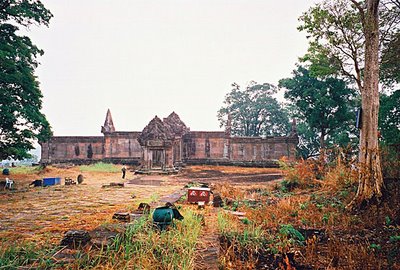 The southern-face of Gopura IV that contains the Churning pediment
The southern-face of Gopura IV that contains the Churning pedimentThursday, August 14, 2008
Journey to Pak Ou
Wednesday, August 13, 2008
Closing the Preah Vihear chapter
Ever-present danger
Iconic images
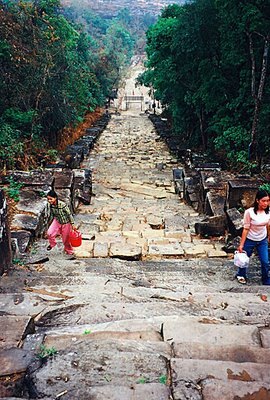 The 162 steps of the monumental stairway as they descend to the small Khmer village below and the border with Thailand
The 162 steps of the monumental stairway as they descend to the small Khmer village below and the border with Thailand 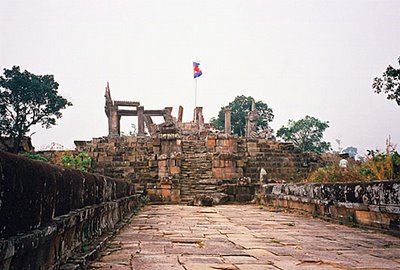 As you approach Gopura V from the naga platform at the top of the stairway, the Cambodian flag flies high
As you approach Gopura V from the naga platform at the top of the stairway, the Cambodian flag flies highSanctuary in the sky
Tuesday, August 12, 2008
Gnome sweet gnome
It's a case of gnome sweet gnome for one lucky leprechaun who has been returned to its owner after being taken all over the world by gnome-nappers. When Eve Stuart-Kelso opened the front door she got the shock of her life to see her garden gnome, which had been snatched from her Longlevens home, standing on the step. Next to him was a suspicious-looking parcel and the package turned out to be a photograph album with pictures of the gnome on his travels. The photos show him abseiling down a mountain, swimming in the sea, standing in a shark's mouth and riding a motorbike. They also show a group, which could be the gnome-nappers, but their identity remains a mystery. 
The grandmother-of-three said: "My leprechaun went missing months and months ago but I had totally forgotten about it. I opened the door and there it was – it was such a shock. He looked quite badly damaged and there was a tightly wrapped parcel next to him. I was very alarmed about the parcel but then curiosity overcame my alarm and I opened it. I wondered if it might explode but then I saw it was a photo album and opened it up." Inside were pictures of the gnome in South Africa, Swaziland, Mozambique, New Zealand, Australia, Singapore, Thailand, Cambodia (where Murphy visited Angkor Wat), Vietnam, China, Hong Kong and Laos. The album also included immigration stamps from the countries and a note from the gnome explaining his abscence. New Zealand was his favourite destination, he said. But, despite his grand travels, there was no mention of the little adventurer finding a pot of gold.
Eve said: "It was the strangest gift I have ever received. "It was a wonderful cheery surprise – it is nice to get some good news. I just keep thinking how funny it is. It puts a smile on my face to see all the people who met on his travels – it's just unbelievable." Eve said she has no idea who is responsible for the gnome's travels. "It is beautifully made and beautifully written", she said. "It is intriguing because someone has gone to so much trouble to give it to a complete stranger." She said she will be telling her grandchildren Sophie, 14, Ellie, 13, and Piers, 13, all about it. "Although they may be disbelieving at first," she said. A Gloucestershire police spokesman said it had no record of the gnome going missing, but added: "Any theft of another person's property, even if this is carried out for a joke, will be treated as a crime by the police. What may seem like a laugh to one person can cause another person distress."
"Hello!
First of all I feel I should explain my prolonged absence... A gnome's life is full of time for reflection, and whilst surveying your front garden one summer morning , I began to get somewhat itchy feet. I came to the conclusion that the world is such a big place and that there is surely more to life than watching the daily commuter traffic and allowing passing cats to urinate on you. I thus decided to free myself from the doldrums of the Shire and seek adventure in foreign lands! My seven months of travel have taken me across three continents, twelve countries and more time zones than I can possibly remember. There have been high points, there have been low points and there have been positively terrifying points, but I have survived and thrived, no small thanks to my travel companion with whom I have shared all these moments."
Preah Vihear 2002 - part two
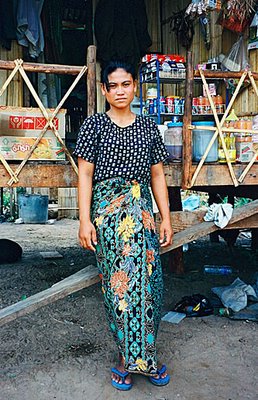 Shop-owner Kouch in the village of Kor Mouy at the foot of the mountain
Shop-owner Kouch in the village of Kor Mouy at the foot of the mountainThe
I was exhausted as I rested in the immigration hut next to a tiny pagoda. The two-hour climb had been a real challenge and when one of the monks suggested I wash in their natural bathing pool nearby, I gratefully accepted his offer. I stripped, retaining a krama around my waist for modesty, and ladled cold water from the large rock pool over my head and body, alongside three other monks and Sokhom. A westerner using their washing facilities was very uncommon they told us but they were pleased to share and I was happy to accept. Refreshed, we walked through the village and on through a narrow 200 metre channel marked by small white stones and red markers. Danger!! Mines!! signs were everywhere, though the deminers had retired to their homes for the evening. As we reached the crest of the mountain plateau, the wreckage of a military helicopter lay off to the left and directly in front of us the Cambodian flag fluttered above the first gopura of Preah Vihear temple. The gopura or entrance pavilion stands at the top of a steep stairway of 162 steps flanked by giant nagas that leads down to a small Khmer community who live just inside the border with
As I looked out towards a smooth tarmaced Thai motorway in the distance,
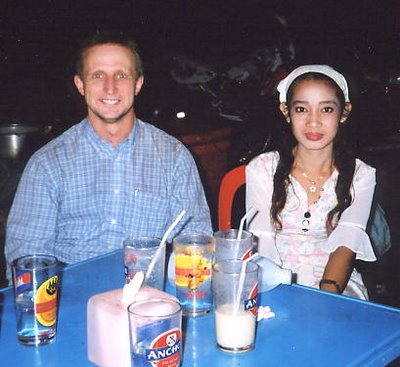 The author and Kove, the TBM queen of tikaloks
The author and Kove, the TBM queen of tikaloks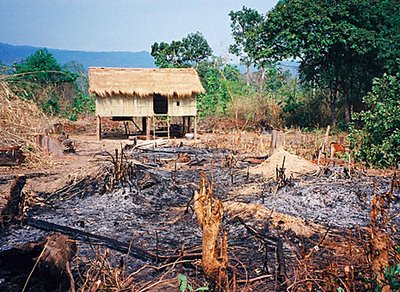 A new house on the route between Tbeng Meanchey and Kompong Thom
A new house on the route between Tbeng Meanchey and Kompong Thom
Monday, August 11, 2008
Preah Vihear 2002 - part one
Preah Vihear 2002 - part one
As the road from Siem Reap to Kompong Thom had improved according to reports, I chose the more comfortable Camry share-taxi option rather than the usual pick-up truck and after successfully concluding negotiations for the two front seats, left a little before 7am. An hour later, I jumped out at Spean Praptos for a few photos of the ancient Angkorean bridge as we waited for a passenger before the rain began to fall, which when added to a few overnight showers, turned the road into a quagmire in places. At one spot the traffic was reduced to a crawl as trucks and taxis slid and careened their way through axle-deep mud. With the main bridge at Stoung under repair, a diversion took us through someone's garden and we finally arrived in Kompong Thom city centre after a four-hour trip.
As arranged by e-mail, my trusted friend, fellow adventurer and moto-driver, Sokhom, was waiting to greet me. After a plate of noodles at the Arunras restaurant, we stopped at his home to pack my daysack, collect our hammocks and mozzie nets and a brief reunion with his wife Sroy and daughter Kunthea, before our mid-day departure. Sokhom's moto is an old one with suspect suspension and an uncomfortable seat but its never let us down on all our previous trips, though this one, a round-trip of some 500 kms north to the ancient temple of Preah Vihear and back, would be its greatest test. The rain had left large puddles in the red-clay road and a succession of massive logging lorries either splashed the water over us or forced us to cover our faces to avoid the dust clouds, once the sun re-emerged from behind the clouds. After a couple of hours we reached the rubber tree plantation where we'd stopped on the same route four months before. Pausing for a cold drink at Phnom Dek, forty minutes later, the minefields nearby had been cleared and obvious signs of demining activity removed, though the large tyre tracks, dried out by the sun, made the final thirty kilometres into Tbeng Meanchey town (TBM), a painful one on Sokhom's elderly Daelim moto. En route, we passed the Prasat Kraham Chhouk temple where a religious ceremony was taking place with what looked like hundreds of monks and nuns in attendance but pressed for time we didn't stop for long.
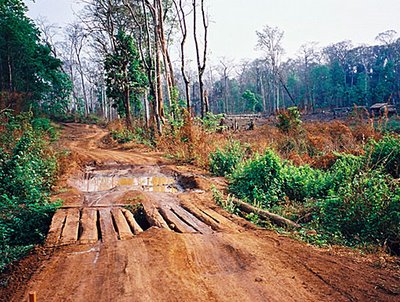 The old road to Tbeng Meanchey from Kompong Thom left a lot to be desired
The old road to Tbeng Meanchey from Kompong Thom left a lot to be desired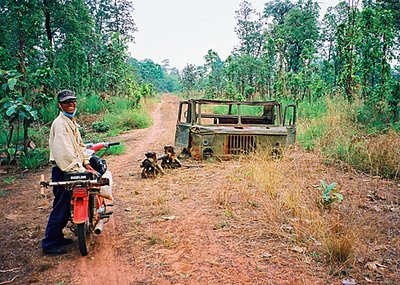 A rusting military vehicle provided reminders of the not-too-distant past
A rusting military vehicle provided reminders of the not-too-distant pastAn alternative route from TBM, used by trucks and taxis, would've meant a detour to the town of Choam Khsan which we'd avoided. However, we did join the road that carried traffic from Choam Khsan to Preah Vihear, which meant we were about forty kilometres from our intended destination. The sun was overhead, the road was the consistency of a sandpit and I spent as much time trudging through the sand on foot as I did sat on the moto. We saw our first humans in three hours when we came across a group of soldiers stripping a clapped-out army tank for spare parts and other roadside wreckage reminded us that this part of Cambodia was a battle-zone until a couple of years ago. At the village of Sro Am (Sa Em) we stopped for petrol and a drink near the junction of the new road being built to bring supplies and future tourists from the direction of Anlong Veng and Siem Reap. This was Sokhom's second visit to Preah Vihear and because of that we took a short-cut, wide enough only for a moto, through a heavily wooded area. We saw only one Danger!! Mines!! sign but he made sure we kept to the track which was a bit painful as the route was rarely used and the vegetation whipped against our legs and arms. In a clearing, we caught our first glimpse of the mountain on which Preah Vihear sits, but it was still some way off and we had to negotiate four steep but dry riverbeds before we arrived at the village of Kor Mouy on the stroke of 2pm, more than six hours after leaving TBM. Many of the houses were very new and belonged to the soldiers who guard the temple and the nearby border with Thailand. A recent squabble between the two countries had seen the border remain firmly closed in the preceding months with only access from the Cambodian side a possibility and talk of a road being constructed to take tourists to the very top of the mountain was rife in the Khmer press. Preah Vihear 2002 - part two will follow tomorrow.
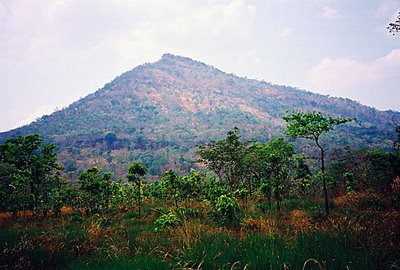 Our first glimpse of Preah Vihear mountain as it towers above the surrounding countryside
Our first glimpse of Preah Vihear mountain as it towers above the surrounding countryside
Muang Sing here we come!
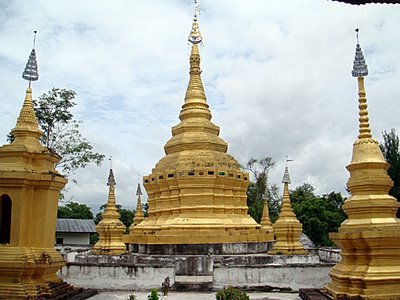 The gilded spires of That Xieng Tung, a Thai Lu stupa about five kilometres south of Muang Sing that hosts an annual festival, the biggest of the year, that everyone attends
The gilded spires of That Xieng Tung, a Thai Lu stupa about five kilometres south of Muang Sing that hosts an annual festival, the biggest of the year, that everyone attendsPreah Vihear's iconography
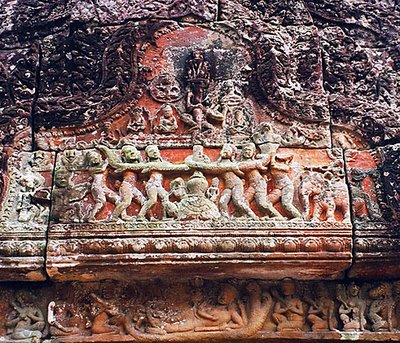 The main scene on the pediment above is the Churning of the Ocean of Milk. The depiction is an unusual one as it shows Indra on his elephant mount to the right and Garuda with open wings on the left amongst a myriad of gods and deities. The reclining Vishnu is on the lintel below.
The main scene on the pediment above is the Churning of the Ocean of Milk. The depiction is an unusual one as it shows Indra on his elephant mount to the right and Garuda with open wings on the left amongst a myriad of gods and deities. The reclining Vishnu is on the lintel below.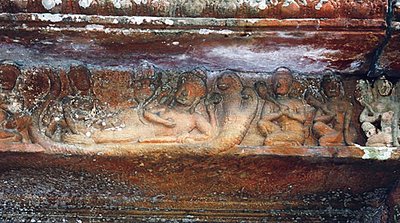 Connected to the Churning scene on the pediment above, this lintel depicts Vishnu Anantashayin with the god reclining on the mythic snake, his legs supported by Lakshmi and a lotus emerging from his navel on which sits Brahma. These can be found on the southern door of Gopura IV.
Connected to the Churning scene on the pediment above, this lintel depicts Vishnu Anantashayin with the god reclining on the mythic snake, his legs supported by Lakshmi and a lotus emerging from his navel on which sits Brahma. These can be found on the southern door of Gopura IV. 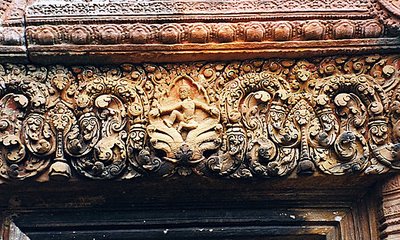 This gorgeous lintel's central scene shows Krishna almost joyfully subduing the naga Kaliya and keeping two of the snake's heads away with his hands. This scene is depicted at Gopura IV, I and the main sanctuary
This gorgeous lintel's central scene shows Krishna almost joyfully subduing the naga Kaliya and keeping two of the snake's heads away with his hands. This scene is depicted at Gopura IV, I and the main sanctuary 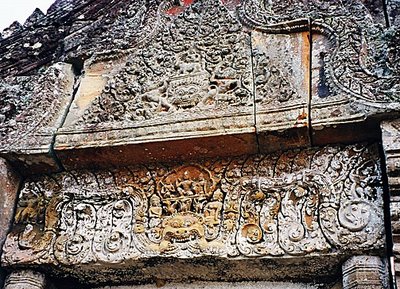 The pediment shows Yama riding his buffalo above a kala, while the lintel is Rama's return to Ayodhya accompanied by Lakshmana and Sita, held aloft by three flying hamsas, above a kala. Its located on the southern door of Gopura III
The pediment shows Yama riding his buffalo above a kala, while the lintel is Rama's return to Ayodhya accompanied by Lakshmana and Sita, held aloft by three flying hamsas, above a kala. Its located on the southern door of Gopura III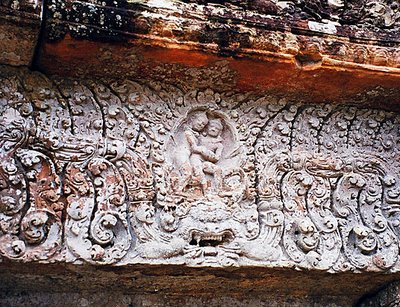 If you thought this lintel showed two lovers, think again! It actually depicts Shiva and Arjuna in hand to hand combat above a kala on the eastern door of Gopura III
If you thought this lintel showed two lovers, think again! It actually depicts Shiva and Arjuna in hand to hand combat above a kala on the eastern door of Gopura III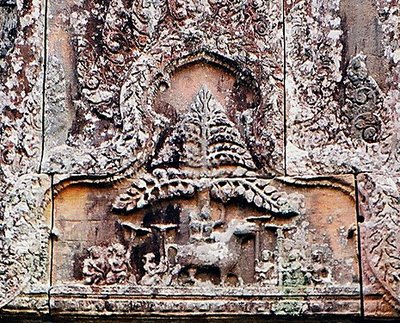 This pediment carving of Shiva and Uma on the back of Nandi is on the southern door of Gopura III. They sit under a large tree accompanied by six acolytes, four of whom hold parasols
This pediment carving of Shiva and Uma on the back of Nandi is on the southern door of Gopura III. They sit under a large tree accompanied by six acolytes, four of whom hold parasolsClose to the edge
Sunday, August 10, 2008
Preah Vihear recalled
Injury update
Film success
Saturday, August 9, 2008
On the river
Friday, August 8, 2008
Bit of a damp squib
I know the Post have been having printing problems and the copy I saw wasn't anywhere near their old standard, choosing instead a far less superior quality paper to print their new edition on. I read through it and it looked 'okay' rather than knocking my socks off, which I was quietly hoping for. There was a lot of international news, though not as much as you see in The Cambodia Daily thank goodness, a business section, 3 pages on the Olympics and very little in the way of breaking stories that I wasn't already aware of. Maybe it was a slow news day yesterday. And of course, it has massive competition with so many foreigners in Cambodia having ready access to the internet, where stories can break every hour, rather than having to wait until breakfast-time the following day. I've no idea about how many copies they need to sell each day to break even, etc but for sure, if they can get the Post to my Street 51 vendor each morning before 8am, they'll have at least 1 regular customer for the next couple of weeks, whilst it beds in. Nearly forgot to mention, it'll be published five times a week, costs 2,500 Riel, is 24 pages in length (the 1st edition also had an 8-page supplement) and its in colour (though the photographs were of poor quality). Link: PPP.
Surviving Cambodia's darkest hour
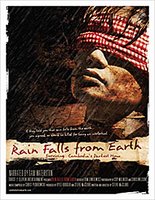 This is my final reminder that film director Steve McClure will be hosting a Q&A after the Cambodian premiere of the feature documentary, Rain Falls from Earth: Surviving Cambodia's Darkest Hour tomorrow (Saturday) night at Phnom Penh's Meta House on Street 264. It's a story of courage, a story of survival and a story of eventual triumph over the genocidal regime that was responsible for the deaths of more than 1.7 million Cambodians. The voices of many survivors - including Vann Nath, Em Theay and Thida Butt Mam - are heard as they convey their thoughts, ideas and emotions - the very things they were forced to abandon in the killing fields. Narrated by Academy Award nominated actor, Sam Waterston, this film gives a voice to those lives that were senselessly lost. The screening begins at 7.30pm, admission is free and everyone is welcome. Visit here for more information about the film.
This is my final reminder that film director Steve McClure will be hosting a Q&A after the Cambodian premiere of the feature documentary, Rain Falls from Earth: Surviving Cambodia's Darkest Hour tomorrow (Saturday) night at Phnom Penh's Meta House on Street 264. It's a story of courage, a story of survival and a story of eventual triumph over the genocidal regime that was responsible for the deaths of more than 1.7 million Cambodians. The voices of many survivors - including Vann Nath, Em Theay and Thida Butt Mam - are heard as they convey their thoughts, ideas and emotions - the very things they were forced to abandon in the killing fields. Narrated by Academy Award nominated actor, Sam Waterston, this film gives a voice to those lives that were senselessly lost. The screening begins at 7.30pm, admission is free and everyone is welcome. Visit here for more information about the film.
Interlude at Nam Dee
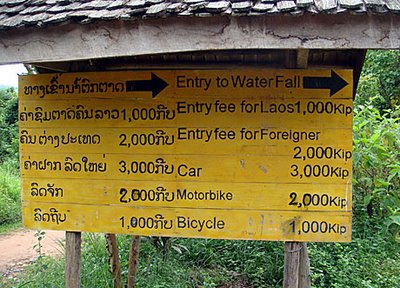 Welcome to Nam Dee waterfall and the usual dual-pricing structure for 'foreigners' found all over Asia
Welcome to Nam Dee waterfall and the usual dual-pricing structure for 'foreigners' found all over AsiaThursday, August 7, 2008
Temple high-spots in demise
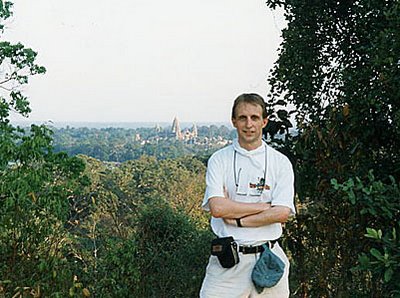 Flashback... This is yours truly on Phnom Bakheng a decade ago with the towers of Angkor Wat bathed in the late afternoon glow of the setting sun over my right shoulder. On a recent visit to Angkor, I noticed a sign at the foot of the steep steps to Phnom Bakheng and friends tell me that the very summit of the temple - which is overcrowded every day with hordes of tourists enjoying the setting sun over the western baray - is now off-limits to everyone after 4pm. I'm getting it checked out but if the news is correct, that's a major blow to those sunset worshippers, though conversely, good news for the future wear and tear of the temple. Pre Rup and even Phnom Krom could become the new hotspots for those gorgeous Angkor sunsets if Phnom Bakheng is now off the itinerary. This follows on from the closure of the upper level of Angkor Wat - another major punch in the kidneys for tourists visiting the jewel in the Angkor crown - and access to the pyramid tower of Prasat Thom at Koh Ker has also been restricted in recent months, after part of the temple collapsed. Unrestricted access to the Angkor temples, for so long a real bonus for visitors, is fast becoming a thing of the past.
Flashback... This is yours truly on Phnom Bakheng a decade ago with the towers of Angkor Wat bathed in the late afternoon glow of the setting sun over my right shoulder. On a recent visit to Angkor, I noticed a sign at the foot of the steep steps to Phnom Bakheng and friends tell me that the very summit of the temple - which is overcrowded every day with hordes of tourists enjoying the setting sun over the western baray - is now off-limits to everyone after 4pm. I'm getting it checked out but if the news is correct, that's a major blow to those sunset worshippers, though conversely, good news for the future wear and tear of the temple. Pre Rup and even Phnom Krom could become the new hotspots for those gorgeous Angkor sunsets if Phnom Bakheng is now off the itinerary. This follows on from the closure of the upper level of Angkor Wat - another major punch in the kidneys for tourists visiting the jewel in the Angkor crown - and access to the pyramid tower of Prasat Thom at Koh Ker has also been restricted in recent months, after part of the temple collapsed. Unrestricted access to the Angkor temples, for so long a real bonus for visitors, is fast becoming a thing of the past.
Nosing around Namtha
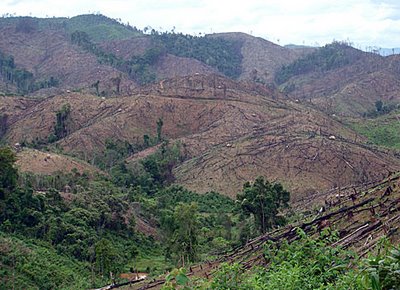 We found the deforestation in the hills around Luang Namtha to be a worrying trend as more people move into the area
We found the deforestation in the hills around Luang Namtha to be a worrying trend as more people move into the areaWednesday, August 6, 2008
A few minutes from Luang Namtha
Coming up
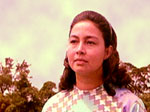 The Meta House (Street 264) month of film and documentary screenings has already begun and this evening's offering is Rithy Panh's The Burnt Theatre, blending fact and fiction as it depicts a group of actors and dancers living and working in the burnt-out shell of Cambodia's former national theatre. Tomorrow (Thursday) will see some rare 1965 super-16mm footage of Cambodia's development through the early 1960s, followed by one of Norodom Sihanouk's films, Rose of Bokor. Filmed in 1969 on Bokor mountain amongst other locations around Cambodia, it features the King and his wife Monique (pictured), as Rose, amidst the triangle of French and Japanese control and the growing seeds of Khmer independence. Friday night will host three documentaries on HIV/Aids in Southeast Asia and on Saturday night, Rain Falls from Earth will enjoy its Cambodian premiere. All films begin at 7pm.
The Meta House (Street 264) month of film and documentary screenings has already begun and this evening's offering is Rithy Panh's The Burnt Theatre, blending fact and fiction as it depicts a group of actors and dancers living and working in the burnt-out shell of Cambodia's former national theatre. Tomorrow (Thursday) will see some rare 1965 super-16mm footage of Cambodia's development through the early 1960s, followed by one of Norodom Sihanouk's films, Rose of Bokor. Filmed in 1969 on Bokor mountain amongst other locations around Cambodia, it features the King and his wife Monique (pictured), as Rose, amidst the triangle of French and Japanese control and the growing seeds of Khmer independence. Friday night will host three documentaries on HIV/Aids in Southeast Asia and on Saturday night, Rain Falls from Earth will enjoy its Cambodian premiere. All films begin at 7pm.
Tuesday, August 5, 2008
PPP going daily
I was saddened to hear today that the Sunrise Children's Village in Siem Reap had been taken over by a gang of youths and staff threatened including Geraldine Cox, the founder of the orphanage. At the weekend, local police initially refused to help eject the youths who are former orphanage boys that have become involved in gang activity. The former government-run facility was adopted by SCV in 2004, though problems with the older boys have dogged it ever since. It houses over 70 orphans and disadvantaged kids. As I type this, I've just heard that the problem has thankfully been resolved. Trying to give these children a better life has always had its ups and downs for Geraldine and for evidence of this I recommend you read her amazing life story in her autobiography, Home Is Where The Heart Is. Link: SCV.
Colonial-era Savannakhet
Wandering back to 2002
In a clearing, we caught our first glimpse of the mountain on which Preah Vihear temple sits, but it was still some way off and we had to negotiate four steep but dry riverbeds before we arrived at the village of Kor Mouy on the stroke of 2pm, more than six hours after leaving Tbeng Meanchey. Many of the houses were very new and belonged to the soldiers who guard the temple and the nearby border with Thailand. A recent squabble between the two countries had seen the border remain firmly closed in the preceding months with only access from the Cambodian side a possibility and talk of a road being constructed to take tourists to the very top of the mountain was rife in the Khmer press.
The temple of Preah Vihear (or Khao Phra Viharn in Thai), mainly built in the 11th century by King Suryavarman I, commands the most spectacular location of any Khmer monument. To reach it, the climb up the mountainside would take us two hours at least, so Sokhom and I rested in hammocks at a shop-house belonging to Kouch and her two children for half an hour. As we walked to the foot of the mountain, part of the Dangrek Mountain chain that determines the border with Thailand, we met an Italian NGO worker and his four helpers who'd spent the night at the temple, which was our intention too, and I didn't need reminding that the spent shell casings and mine-signs we encountered recalled the days when the temple stronghold was a prized possession of the Khmer Rouge. The climb quickly became a real burden. I longed for an escalator (one of the off-the-wall suggestions by the Khmer press) as the canopy of trees made it extremely humid, the trail weaved around giant sandstone boulders and tree stumps but was pretty steep and frequent pauses to catch my breath were necessary. An hour into the ascent, we reached the midway point on arrival at the Bram Makara (15 January) village, much to my relief. The village as such consisted of just three houses and we rested at the first, where the family who lived there sold us some sugary drinks to boost our energy levels. We were joined for the second half of the climb by Chhoun Ny, an immigration policeman, who was due to begin his two day shift that evening. He'd been a policeman for fifteen years, mostly in Kompong Spue before transferring to Preah Vihear two years ago. According to Ny, I was the tenth tourist to visit the temple that week. The latter half of the trek was less arduous and in the open, though frequent rest and drink-stops were still a necessity. As we arrived at the small settlement at the summit, a large pig and her piglets squealed their welcome and a few families belonging to the HALO Trust deminers stationed at the site waved their hello.
I was exhausted as I rested in the immigration hut next to a tiny pagoda. The two-hour climb had been a real challenge and when one of the monks suggested I wash in their natural bathing pool nearby, I gratefully accepted his offer. I stripped, retaining a krama around my waist for modesty, and ladled cold water from the large rock pool over my head and body, alongside three other monks and Sokhom. A westerner using their washing facilities was very uncommon they told us but they were pleased to share and I was happy to accept. Refreshed, we walked through the village and on through a narrow 200 metre channel marked by small white stones and red markers. Danger!! Mines!! signs were everywhere, though the deminers had retired to their homes for the evening. As we reached the crest of the mountain plateau, the wreckage of a military helicopter lay off to the left and directly in front of us the Cambodian flag fluttered above the first gopura of Preah Vihear temple.
For more from my first Preah Vihear adventure, click here. To be honest my notes don't fully express how hard the climb was. At the time I was pretty fit but the first half of the climb was incredibly steep and so exhausting that I contemplated giving up more than once. Another real concern was the threat of landmines, so we stuck to what could loosely be called a track, though pulling ourselves up by tree roots and grabbing large stones for leverage, wasn't my idea of a recognised path. It was Sokhom's second visit so I put my trust in his judgement and we made it to the half-way point intact, where I collapsed onto a wooden bench. I was utterly shattered and I still remember that feeling as if it was yesterday. Fortunately the second half of the climb was considerably less strenuous.
Working to conserve
A new day for community-based ecotourism
Wildlife Alliance's Jules Colomer takes environmental education on the road with the Kouprey Express and finds a way to blend his enthusiasm for mountain biking with a new ecotourism project in Cambodia's Cardamom Mountains.
When you’ve just ridden 40 km of single track through the rainforest, swam in waterfalls, heard gibbon calls echo through the canopy, and watched giant hornbills cruise overhead, it’s important to remember that life is supposed to be tough in rural Cambodia. Thankfully a boat carrying ice makes its way to Chi Phat Commune by mid-afternoon, and the rambling wooden guest house offers good food and a great view of the main village street where locals go about their daily lives. Chi Phat, home to around 550 families, is one of the largest settlements in the Cardamom Mountains of Southwest Cambodia, and Wildlife Alliance, my host organisation, has been working to develop capacity in community-based ecotourism here since early 2007. Traditional use of forest resources has recently given way to increasingly commercial extraction of timber and wildlife, and community-based ecotourism (CBET) has the potential to provide alternative livelihoods to locals. It also contributes to poverty reduction and provides an incentive to protect the area’s rich environment. Recognised as one of the world’s biodiversity hotspots, the Cardamom Mountains’ 16 different ecosystems are home to many species, including endangered Asian elephants, Indochinese tigers, and Siamese crocodiles. The mountainous topography makes a welcome change from the generally pancake-flat terrain, and old logging roads and walking trails crisscross the forest – leading from village to village, to rivers, waterfalls and cultural artifacts. Chi Phat is a muddy 17km ride or 2.5 hours by slow boat from the nearest main road.
What does a VIDA (Volunteering for International Development from Australia) volunteer do in such situations? Having met a fellow Australian volunteer in Cambodia, Terry Wooltorton (an AVI with the NGO Live and Learn Environmental Education), with a shared passion for mountain biking, and with the support of Wildlife Alliance, we successfully proposed the development of a community-based mountain biking enterprise in Chi Phat and were awarded 25,000 Euro by the IUCN (World Conservation Union) to undertake the 9-month project. The project is based on building capacity in eco-awareness, hospitality, First Aid, eco-guiding, and mountain biking among community members. Trails are being mapped, groomed, and signposted. In November 2008, 12 quality mountain bikes will be brought in from Thailand, and a promotional multi-day ride for tour operators, media, and recognised mountain bikers is being organised by the community with the aim of providing the basis for a small-scale enterprise managed by Chi Phat’s democratically-elected CBET Committee. All benefits from the project are shared between local service providers and a commune fund administered by the Committee for the benefit of Chi Phat.
I spend roughly one week per month in Chi Phat, dividing my time between this project and managing Wildlife Alliance’s mobile environmental education unit, the Kouprey Express, which travels the country providing interactive, hands-on environmental education to rural primary schools in proximity to protected areas. Working with children who are eager to learn, participate, and who are excited by just the sight of the project vehicle (a coaster bus featuring a wraparound forest and wildlife scene) is a great experience. Between the busy schedule of tree planting, mural painting, bin decoration, and environmental games, the project managed to squeeze in a wildlife art competition to celebrate World Animal Day in September 2007. We worked with 250 children from five orphan and vulnerable children centres in Phnom Penh for a week, and took 50 lucky artists to the Phnom Tamao Wildlife Rescue Centre. There they saw the tigers, walked with the elephants, and prepared food for the bears – a special experience for the children, the majority of whom had never seen wildlife.
I’ve been here as a VIDA volunteer since January 2007, leaving behind a government job for the opportunity to experience Khmer culture and to contribute in a small but meaningful way to the people I interact with along the way. Clichéd, but true nonetheless. Being a VIDA has broadened my understanding of the vibrant and evolving Khmer culture, allowed me to meet people and see places that would otherwise be inaccessible, and provided me with a strong in-country support network. I can highly recommend the experience to anyone with an open, curious, and adventurous mindset. Copyright Jules Colomer
To find out more about the work of Wildlife Alliance, click here
Monday, August 4, 2008
Meta magic
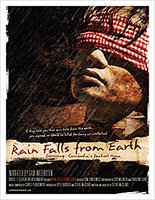 I've been quiet on the Meta House front for the last month or so as to be honest, they weren't showing anything that grabbed my attention. I've been a regular visitor to their roof-top cinema and exhibition rooms for many months now so it was unusual not to set foot in their Street 264 headquarters for a few weeks. However, the month of August will see an end to my absence, in a big way. In fact Nico and his team have surpassed themselves with their program for this month. I've already penciled in a dozen nights' worth of viewing and it could be more! The main focus will be next Saturday (9th Aug) when filmmaker Steve McClure will be on hand to present a story of courage and survival in Rain Falls From Earth - Surviving Cambodia's Darkest Hour. Steve has put his heart and soul into this project and the story he weaves includes interviews with Vann Nath, Em Theay and Thida Butt Mam. Don't miss it! Also on my 'must-see' list are 1960's footage including Sihanouk's Rose of Bokor film (Thurs 7th), the double-docu night of Kampuchea: Death & Rebirth with Inside Pol Pot's Secret Prison (Fri 15th), two of John Pilger's best-ever documentaries, Year Zero and The Betrayal (Sat 16th), Rithy Panh's One Evening After The War (Sun 17th), a slew of Vietnam documentaries and to close the month, the double feature of Dogora and Baraka (Sat 30th). Maybe I should bring my camp-bed and stay for the whole month.
I've been quiet on the Meta House front for the last month or so as to be honest, they weren't showing anything that grabbed my attention. I've been a regular visitor to their roof-top cinema and exhibition rooms for many months now so it was unusual not to set foot in their Street 264 headquarters for a few weeks. However, the month of August will see an end to my absence, in a big way. In fact Nico and his team have surpassed themselves with their program for this month. I've already penciled in a dozen nights' worth of viewing and it could be more! The main focus will be next Saturday (9th Aug) when filmmaker Steve McClure will be on hand to present a story of courage and survival in Rain Falls From Earth - Surviving Cambodia's Darkest Hour. Steve has put his heart and soul into this project and the story he weaves includes interviews with Vann Nath, Em Theay and Thida Butt Mam. Don't miss it! Also on my 'must-see' list are 1960's footage including Sihanouk's Rose of Bokor film (Thurs 7th), the double-docu night of Kampuchea: Death & Rebirth with Inside Pol Pot's Secret Prison (Fri 15th), two of John Pilger's best-ever documentaries, Year Zero and The Betrayal (Sat 16th), Rithy Panh's One Evening After The War (Sun 17th), a slew of Vietnam documentaries and to close the month, the double feature of Dogora and Baraka (Sat 30th). Maybe I should bring my camp-bed and stay for the whole month.
Your own place
Their website explains it as follows: AAfC's largest project, the Rural Schools Project, has helped build over 400 enriched primary and lower secondary schools in rural Cambodia since 1999. In this program, donors sponsor the construction of a school in a village that currently lacks one. Donors pay US$13,000 for a school, with matching funds provided by the World Bank and Asian Development Bank, through partnership with Cambodia's Social Fund and Ministry of Education. After the school is constructed, donors are strongly encouraged to enrich the lives of students by funding improvments for their school. School improvements include English and computer teachers, computers powered through solar panels, Internet access through a satellite dish or GPRS system, a well or water filter, a school nurse, a vegetable garden, and a bookcase of books.
Thom (big) problems at Ta Muen
I highlighted the difference of opinion between Cambodia and Thailand over this temple in my blog in December. To refresh memories, here's what I said at the time:
If you're not aware, one of my biggest passions is visiting ancient Khmer temples, dotted around the Cambodian countryside. However, there are a series of Khmer temples in northeast Thailand that I have yet to visit so I was particularly interested in a report from Radio Free Asia's correspondent Kim Pov Sottan which highlighted the issue surrounding the 12th century Angkorean temple of Prasat Ta Muen Thom - which is in fact three ruined structures all with the same generic name - in a location that seems to be on the very border between Cambodia and Thailand. If you speak to the Khmers in the locality, they'll tell you that the temple is Cambodian and that the Thai's have stolen it in the last few years, whilst the Thai's have assumed responsibility for the temple and built a paved road for easy access for visitors. The report from RFA suggested that even the Thai military commander for the area claims that the temple is in a 'white zone' which is technically a disputed, no-man's land.
Michael Freeman’s excellent Guide to Khmer Temples in
Sunday, August 3, 2008
Au revoir to Banteay Thom
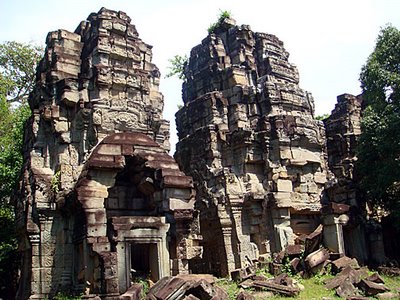 The southern (left) and central towers of Banteay Thom. The rear of the central tower has collapsed in part
The southern (left) and central towers of Banteay Thom. The rear of the central tower has collapsed in part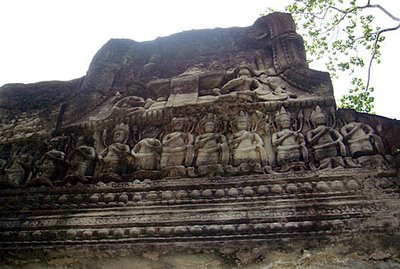 With the sun behind the eastern gopura, this pediment photo isn't one of my best. The pediment shows Prajnaparamita and a lower register of 12 crowned women holding lotus flowers
With the sun behind the eastern gopura, this pediment photo isn't one of my best. The pediment shows Prajnaparamita and a lower register of 12 crowned women holding lotus flowers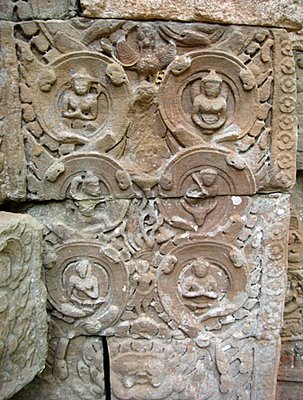 Banteay Thom has some gorgeous wall panels and these Buddhist figures escaped mutilation in the late 13th century
Banteay Thom has some gorgeous wall panels and these Buddhist figures escaped mutilation in the late 13th centuryPediments at Banteay Thom
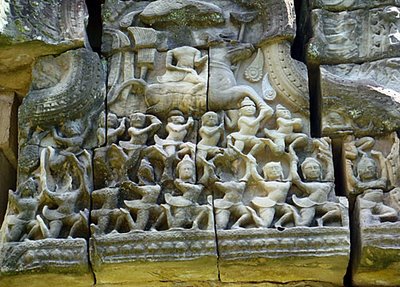 Over the southern door of the southern tower, this pediment depicts the Great Departure with the horse of Siddhartha being supported by the gods, his tail held by Chandaka and eleven dancing apsaras below, which seems to belie the suggestion that the departure was in silence
Over the southern door of the southern tower, this pediment depicts the Great Departure with the horse of Siddhartha being supported by the gods, his tail held by Chandaka and eleven dancing apsaras below, which seems to belie the suggestion that the departure was in silence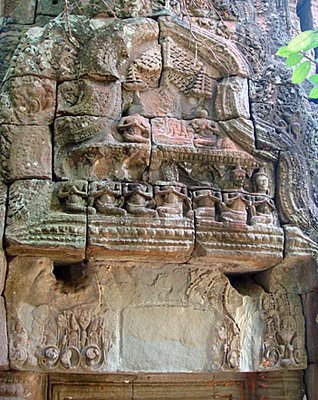 Both the lintel and the pediment above have been badly defaced. A row of worshippers remain but the main figure, probably a Lokeshvara, has been removed
Both the lintel and the pediment above have been badly defaced. A row of worshippers remain but the main figure, probably a Lokeshvara, has been removed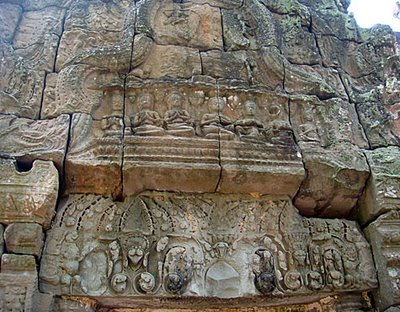 An almost identical scene with the pediment losing its central figure and the lintel losing its Buddhist theme including its kala
An almost identical scene with the pediment losing its central figure and the lintel losing its Buddhist theme including its kalaOne of my fave prasats
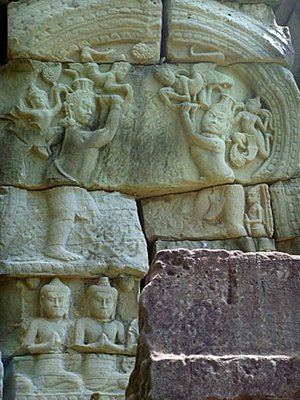 This defaced pediment is located on the eastern gopura of Banteay Thom. The Lokeshvara has been expertly chiselled away leaving two asuras either side who are seen torturing the central missing figure. Crowned worshipping figures sitting in anjali are below
This defaced pediment is located on the eastern gopura of Banteay Thom. The Lokeshvara has been expertly chiselled away leaving two asuras either side who are seen torturing the central missing figure. Crowned worshipping figures sitting in anjali are below Saturday, August 2, 2008
Closing the Wat Phu chapter
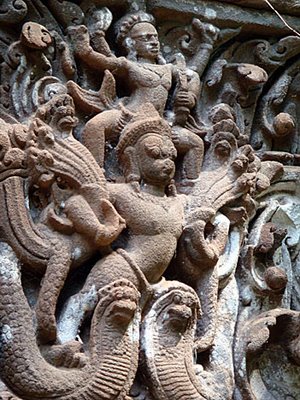 Detail of Vishnu riding his mount Garuda. The bird-man grasps a multi-headed naga in either arm, while he steps upon one-headed nagas who, rearing up, obscure his legs. Vishnu has four arms and is standing on the shoulders of his mount. This lintel is above the northern door of the sanctuary. White patches on this lintel are lichens, not paint
Detail of Vishnu riding his mount Garuda. The bird-man grasps a multi-headed naga in either arm, while he steps upon one-headed nagas who, rearing up, obscure his legs. Vishnu has four arms and is standing on the shoulders of his mount. This lintel is above the northern door of the sanctuary. White patches on this lintel are lichens, not paint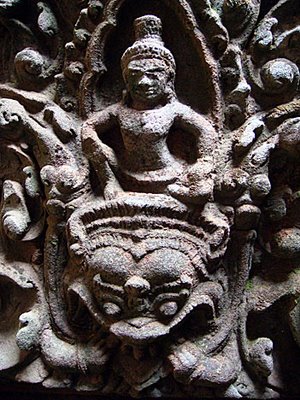 Detail of Vishvakarma - architect of the gods - sat above a kala in munching mode, as he makes a meal out of a foliage branch
Detail of Vishvakarma - architect of the gods - sat above a kala in munching mode, as he makes a meal out of a foliage branch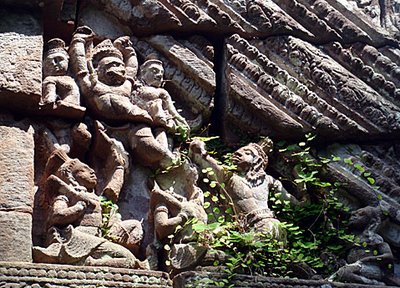 This half pediment above the northern door shows a scene of monkeys fighting, most likely Valin and Sugriva
This half pediment above the northern door shows a scene of monkeys fighting, most likely Valin and SugrivaBeautiful lintels at Wat Phu
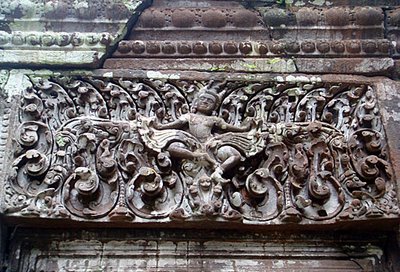 The southern door has a beautiful rendition of Krishna subduing the poisonous snake Kaliya by dancing on his head and splitting him into two pieces
The southern door has a beautiful rendition of Krishna subduing the poisonous snake Kaliya by dancing on his head and splitting him into two pieces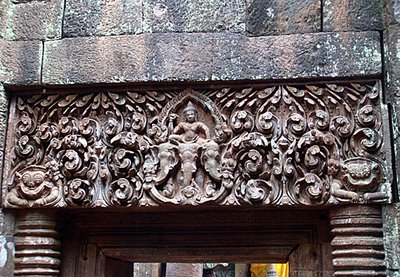 On this lintel over the southern door to the central sanctuary resides Indra on his three-headed elephant mount Airavata, with two kalas at either end keeping guard
On this lintel over the southern door to the central sanctuary resides Indra on his three-headed elephant mount Airavata, with two kalas at either end keeping guard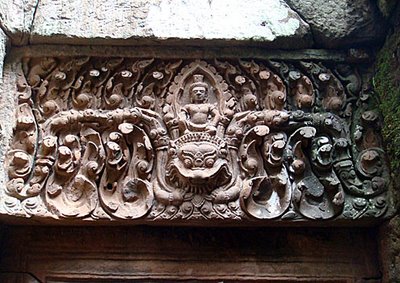 Vishvakarma is never far from the action and appears here sitting on a fierce kala on this lintel above one of the antechamber doorways
Vishvakarma is never far from the action and appears here sitting on a fierce kala on this lintel above one of the antechamber doorways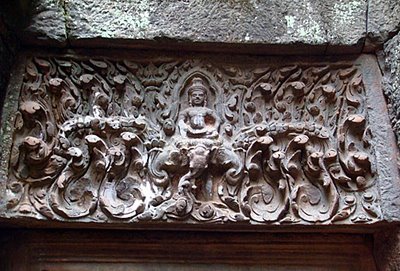 On this slightly worn lintel over the central doorway, Indra is again accompanied by his 3-headed Airavata
On this slightly worn lintel over the central doorway, Indra is again accompanied by his 3-headed AiravataRiver of Victory
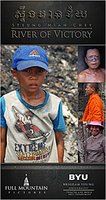 A documentary film looking at the hopes and fears of three people whose lives are immersed with the Stung Meanchey garbage dump in Phnom Penh will be the focus of Steung Mian Chey: River of Victory. Currently in production and seeking funds, the film is the brainchild of Trevor Wright, director, Todd Smith and Jordan Augustine, who traveled to Cambodia to do humanitarian service and were bowled over by the inspirational people they met at the garbage dump. Their story will focus on three of these people, Scott Neeson, the founder of Cambodian Children's Fund, together with a mother, Samphoas and a child, Samnang. Keep tabs on the film's progress here.
A documentary film looking at the hopes and fears of three people whose lives are immersed with the Stung Meanchey garbage dump in Phnom Penh will be the focus of Steung Mian Chey: River of Victory. Currently in production and seeking funds, the film is the brainchild of Trevor Wright, director, Todd Smith and Jordan Augustine, who traveled to Cambodia to do humanitarian service and were bowled over by the inspirational people they met at the garbage dump. Their story will focus on three of these people, Scott Neeson, the founder of Cambodian Children's Fund, together with a mother, Samphoas and a child, Samnang. Keep tabs on the film's progress here.
Cheery Chhnang
Chaotic, cheery Chhnang - by Tom Cockrem (Malaysia Star online)
Kompong Chhnang in Cambodia is a fantastic destination in itself — exotic and chaotically old world. The flood waters had not come. The houseboats sat low at the foot of their long-legged neighbours — the stilt houses on the land. The soaring height of these informed how far the river might soon be expected to rise. The floaters would rise with them, until almost eye to eye with their stilted counterparts. The river here was busy with the comings and goings of so many kinds of craft — fishing boats, ferries, sampans, hawker boats and canoes, some motor-driven and some propelled by oar. The women at the helm wore multi-hued pajamas, just like in Vietnam. But this was Cambodia. The river was the Tonle Sap, and the town, Kompong Chhnang. I was on a ferry heading north from Phnom Penh to Siem Reap, with a view to visit Angkor. But Chhnang seemed to me a fantastic destination in itself — intriguingly exotic and chaotically old-world. I decided then and there to make it back here some time, and get to see close up how these people of the river live their lives.
So a few years down the track, and I am back in Phnom Penh, and off to Kompong Chhnang. Only this time I cheat a bit, and travel by bus instead of boat. It would take just two hours. I am dropped off at the market end of town. It’s some 2km inland from the river, and looks like any other small Cambodian urban centre, with nondescript shophouses and a good amount of grunge. The market itself, though, would be good fun to explore. To get to the river you take a moto (taxi motorbike) down the long main street to Pasar Krom — the waterfront market. It feels a little strange sneaking up on the river from behind, so to speak. The road is lined by a motley assortment of small businesses and shacks. In between, you glimpse the countryside — the vivid green wetlands given over to rice, commanded here and there by thatched cottages on piles. Meanwhile, greetings are coming thick and fast — “Hello, sir”, “Good afternoon”, “What’s your name?” It’s nice to feel so welcome. I pass a temple complex with saffron-robed monks smiling hellos from the yard. A dirt road branches off to the right, and heads down to a stream. It crosses a breakwater — one that draws a crowd. Net casting fishermen share it with the traffic, as well as sporting kids, as a bevy of motor bike owners wash their machines. Now there’s a novel scene!
When it gets to the river, the road does a sharp left to become a kind of esplanade. On the riverbank side are lots of little eateries and stalls. The “esplanade” soon turns into a track, and I am in amongst a maze of wooden stilts. Then the fun begins. The people are so friendly here, I reach celebrity status before I’ve made a hundred yards. Ladders lead steeply up to the cube-like domiciles perched atop the piles. Once ensconced up there you must feel pretty safe, except maybe in a storm. Backtracking now, I stand on the riverbank and overlook the houseboats down below. There are far more than I could ever have imagined. They are moored in neat rows stretching away as far as you can see. A high rickety bridge takes you over the stream — the one with the breakwater. A lady wearing a conical hat awaits my arrival. “Boat — five dollar one hour!” And who could resist her charming smile. I tell her I’ll be back tomorrow morning. An even bigger smile!
The scene here is simply amazing. Makeshift plankwalks lead out to rowboats that take commuters and school kids to and from their homes. Neighbours sit and chat across the decks. Fisherman mend engines and nets, and the kids just lark about. Boat builders and mechanics work away on the river or the shore, and floating shops sell everything from groceries to soup. Most of the boat dwellers are, in fact, Vietnamese. They are fisherfolk who have ventured up the Mekong from the Delta, then worked their way up the Tonle Sap. Around 150,000 Vietnamese make Cambodia their home. Most reside in Phnom Penh, but many are fishers and rice farmers who have followed in the wake of the not infrequent Vietnamese invasions of Cambodia. The first of these occurred in the 17th century, and the most recent was in 1979.
Next morning, I’m as good as my word. Traversing the bridge again — risking life and limb — I am met by the boat lady with the hat and the smile. She soon has me seated in her boat and conveyed out amongst the other crafts. She works a single oar while standing at the bow — how I wouldn’t know. The houseboats have a surprising array of mod cons — TV, karaoke and the like. The rowers sidle up to one another for a chat. A hawker boat stops by, and they maybe grab a coffee or a snack. Gee, it ain’t so bad here living on the water, after all. Back on terra firma, I find an alternative route back up town. It’s a dirt road lined with shrub-enshrouded homes. Motorised traffic here is light, and the road is given over to vendors, cyclists and strollers such as me. Life seems idyllic in these parts, in a minimal communal kind of way. I am invited onto verandahs, and get to meet the family — all three generations — plus relatives and friends. It’s not hard to really like Chhnang. Sundown sees me back on the “esplanade”, relishing this cooling river breeze, a chilled Anchor beer in my hand. The hawker stalls get busy around this time. Any wonder. I drink to cheery fellow diners and to the houseboat residents below, to everyone I’ve met in Kompong Chhnang, and also to this ferry on the river passing by. Now I bet it’s on its way from Phnom Penh to Siem Reap.
Friday, August 1, 2008
Market time in Muang Sing
Two extraordinary women
 In today's Huffington Post, writer Marianne Schnall focuses on two extraordinary women.
In today's Huffington Post, writer Marianne Schnall focuses on two extraordinary women.Isabel Allende, Loung Ung and the Power of Memoir
It's mind-numbing. Four hundred thousand dead and 2.45 million displaced in Darfur; 5.4 million dead in fighting in the Democratic Republic of Congo since 1998; epidemic levels of violence against women and children. With the constant repetition of such statistics of devastation, what can move us to action? At an upcoming Women & Courage Conference at Omega Institute in Rhinebeck, New York, Isabel Allende and Loung Ung (pictured) will cross paths. These two extraordinary writer/activists demonstrate that the most direct and powerful way to comprehend human suffering is through compelling, first-hand accounts.
Two daughters of exile, Allende and Ung present a study in similarity and contrast. After happy, affluent childhoods, both fled their countries, Chile and Cambodia, after watching them disintegrate into violence, struggle and genocide. And both later wrote memoirs of suffering and survival, stories of personal courage. But from here their stories diverge. In the 1970s, Isabel Allende was already a journalist and young mother when the violent overthrow of her father's cousin, Chile President Salvador Allende, occurred. She helped many young leftists evade the Pinochet death squads before a series of threats forced her family to flee to Venezuela. Her best-selling first novel, House of Spirits, drew on her experiences then. A generation younger, Loung Ung was only five when the violent 1975 Khmer Rouge regime forced her family of nine to flee Phnom Penh for the Cambodian countryside. Posing as peasants, they lived through every human's worst nightmares. First They Killed My Father is the memoir that tells her wrenching story of labor camps, starvation, attempted rape and the loss of her family. Ung and one brother eventually made their way to the United States, where she ultimately became a human rights activist. Her second memoir, Lucky Child, tells the story of the challenges of her new life juxtaposed with those of her sister who remained in Cambodia.
Today, as U.S. citizens, Allende and Ung value their freedoms, but view the American media with critical eyes. "It seems to me we are living in a time in which fear is used as a tool in the media, entertainment, culture, and politics," says Ung. I think right now, it takes courage to live a life of hope. A life of insights. A life of family. And to not buy into this fear that we're being sold." Allende doesn't mince words. "The media could do a much better job, that's for sure, especially the media that targets women. ... Human rights? They couldn't care less! Their message to women is all about consumerism, looking sexy and pleasing men in bed. And yet they have the potential to make profound changes for the better in women's lives." Allende, an avowed feminist, has drawn liberally from her story and those of her family for her novels, but her first memoir, Paula, written amidst the storm of emotion provoked by her daughter's illness and death, has an extraordinary intimacy and authenticity. Calling a memoir "an invitation into another person's privacy," she has a new one just out, The Sum of Our Days. "I have more freedom when I write fiction, but my memoirs have had a much stronger impact on my readers. Somehow the 'message,' even if I am not even aware that there is one, is conveyed better in this form."
Similarly, Ung feels that memoirs "connect the humanity in us." She explains, "We often hear about many hundred thousands killed in Darfur, and two million in Cambodia. All these big numbers. Memoirs bring it down to a family, a face... it breaks down that barrier of what is Cambodia, Vietnam, Sierra Leone, Darfur - down to a father, a mother, a brother, a sister. How I missed my mother - is that very different from how your children miss you? How I long for my father's touch on top of my head is not different from any other child's longing." Ung's story is searing. Told with simplicity and drama from a child's point of view, it includes events that are simply beyond the bounds of our comfortable western experience. At one moment, after Ung's father has been taken away and executed, her mother picks her three strongest children - including Ung, who is at this point seven years old - and essentially says to them, go away; go off in three different directions; say that you are an orphan; get lost so that you can survive. Ung's emotionally devastated mother then remains with her smallest, weakest child. Grief-stricken and starving, they both will be executed by the Khmer Rouge. Ung - tiny, clever, rebellious - comes across as extraordinarily courageous, the ultimate survivor. Yet Ung sees what is universal in her story. "As a child, it took courage to survive the war that I was in," she says. "As a young girl, it took courage to be true to my brown skin in a sea of white children. ... It takes courage for all of us to be a woman, a mother, a sister; to be together in a society that is breeding so much fear." Allende agrees: "Women have always been courageous. ... They are always fearless when protecting their children and in the last century they have been fearless in the fight for their rights. ... In times of conflict, war, poverty or religious fundamentalism, women and children are the first and most numerous victims. Women need all their courage today."
Both Allende and Ung, in the context of the Omega Conference on Women & Courage, are issuing a call to action for all women. The message begins with the awareness that we all need to call on the "everyday" forms of courage, and to support each other in that. "We get so caught up in all these different issues - whether it's the economy, the war, oil crisis, or the election - that sometimes we forget about the challenges women face every day. It's important to come together and to re-connect on that level," says Ung. And from Allende, "Sisters: talk to each other, be connected and informed, form women's circles, share your stories, work together, and take risks. Together we are invincible. There is nothing to be afraid of." And both Allende and Ung call for activism. Allende (who founded her own women's advocacy organization, called The Isabel Allende Foundation) sees a distinct role for senior women, who have education, resources and have been empowered by the women's movement. "Our role as grandmothers is to protect young women and children, to work for peace in every way and at every level, and to improve the quality of life for everybody, not just the privileged." "Overall, I think the more team members we have - be it memoir writers, journalists, peace corps volunteers - to go out there and report on human rights issues in the world, the better," says Ung, who's been active on behalf of a variety of causes affecting her homeland, as well as for the elimination of land mines around the world. "Ultimately, I think our goal is the same; to create a safer and better world for all of us." "Our role is to dream a better world," says Allende, "and to work courageously to make that dream possible."
Article co-written with Patty Goodwin. This article originally appeared at the Women's Media Center.
A much longer one-to-one interview with Loung Ung by Marianne Schnall appears here. In the interview Loung lets on that she's writing a book about her great grandmother, her grandmother and her mother and the family's migration from China to Cambodia to America.